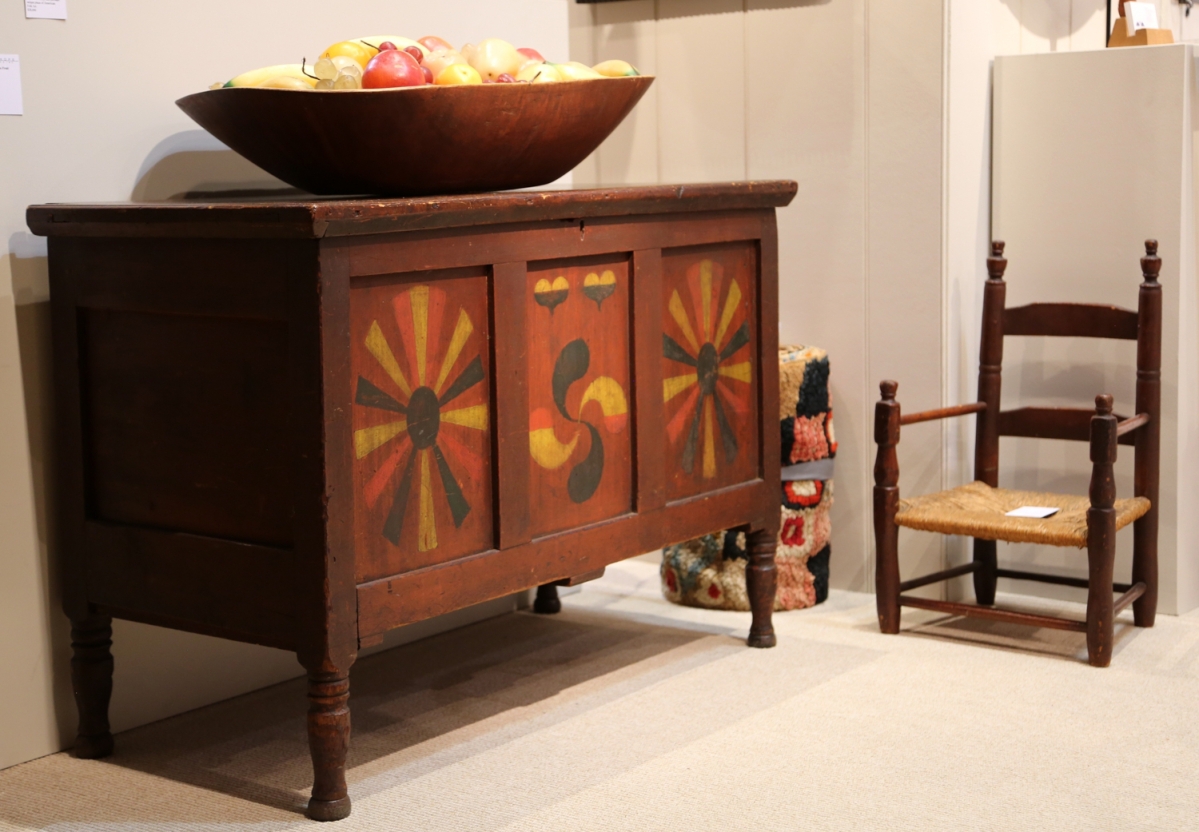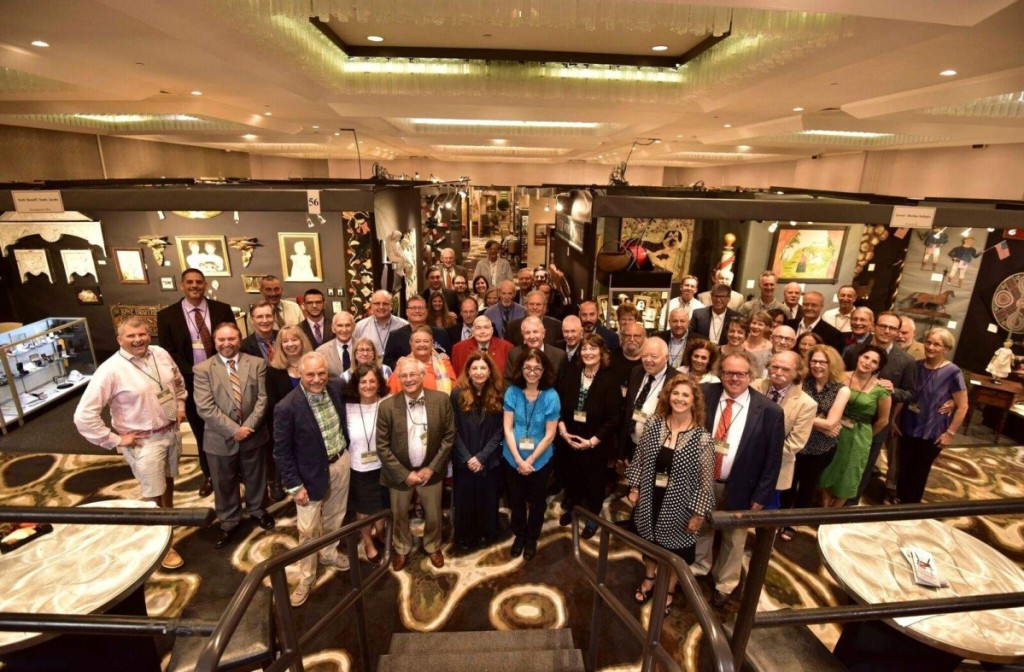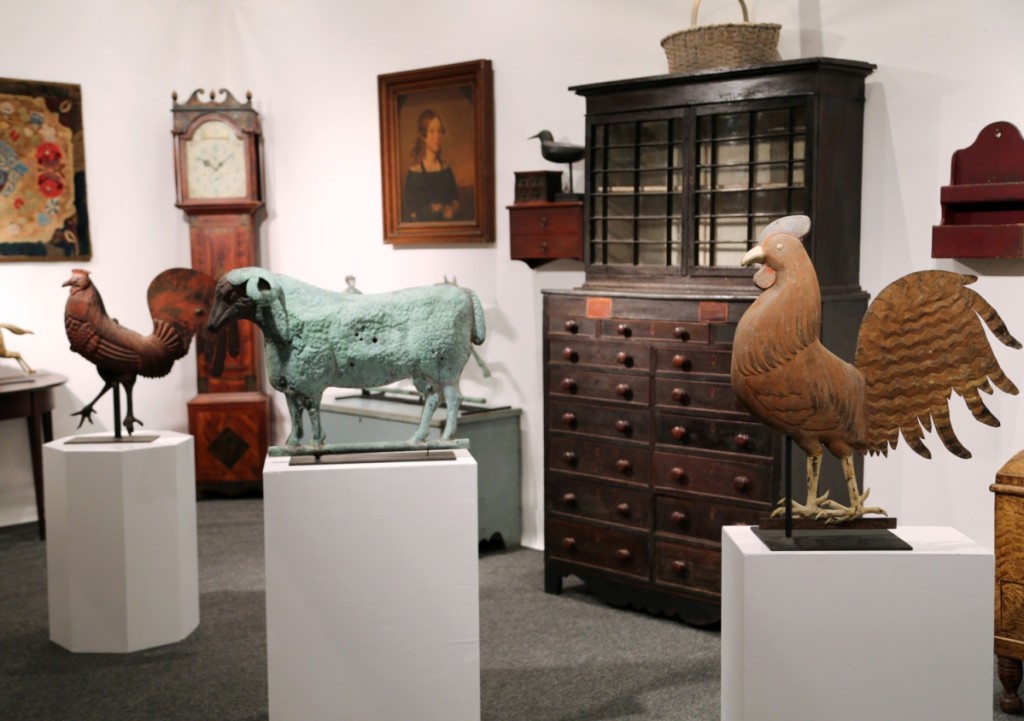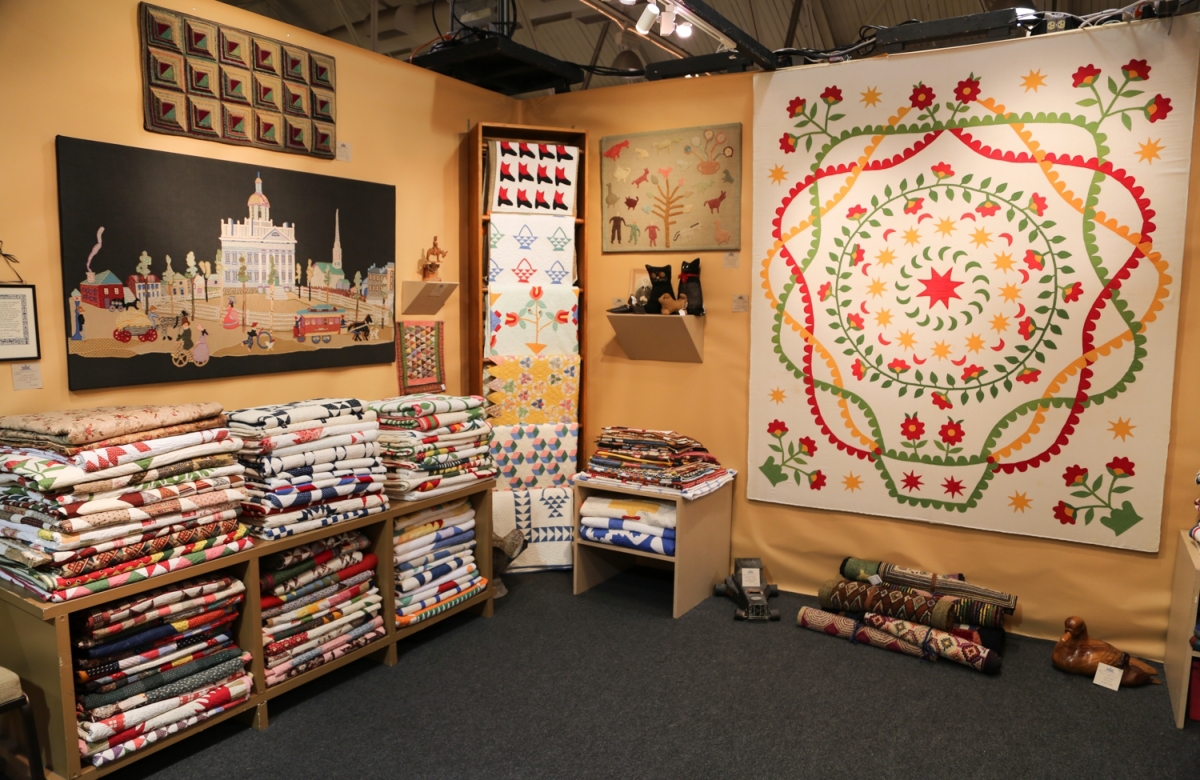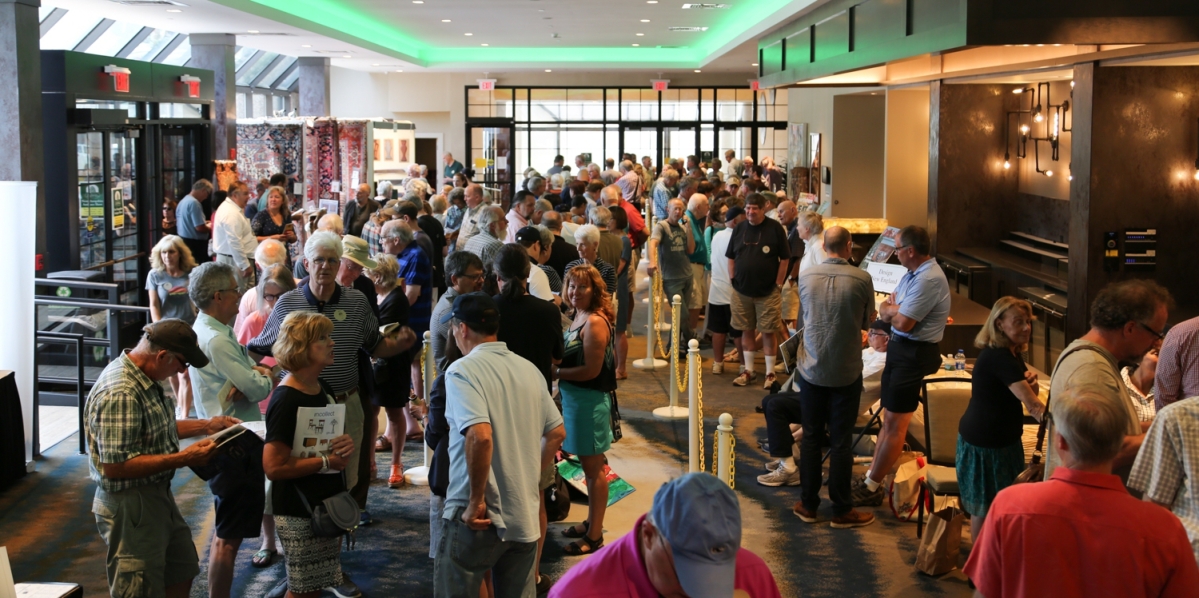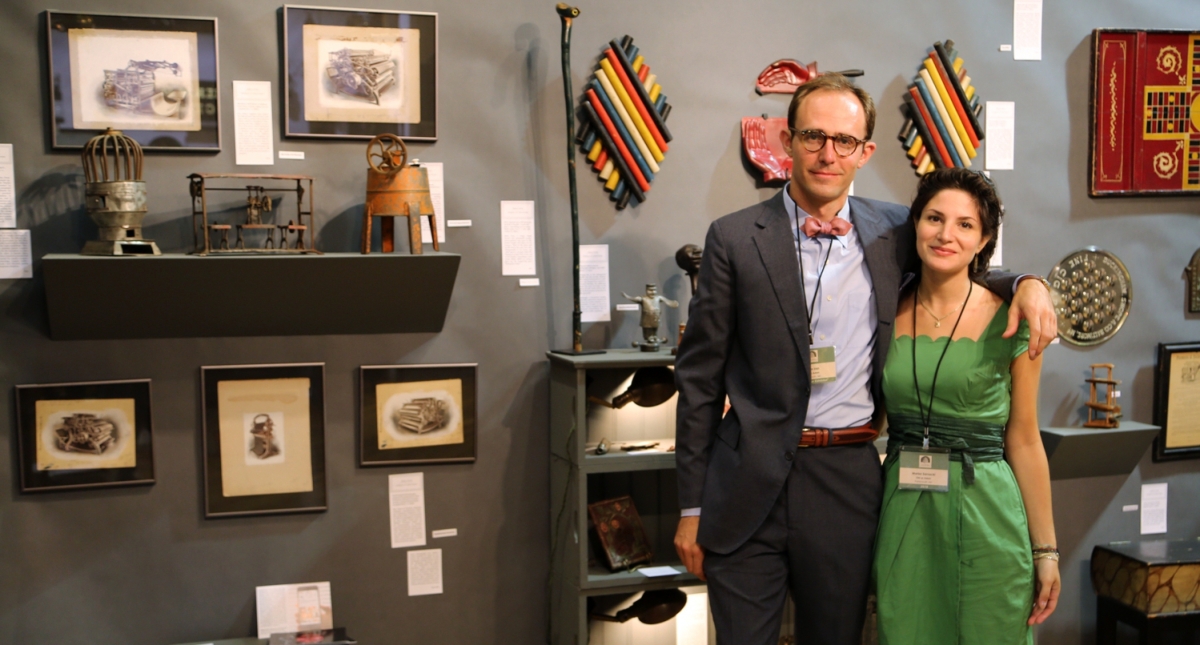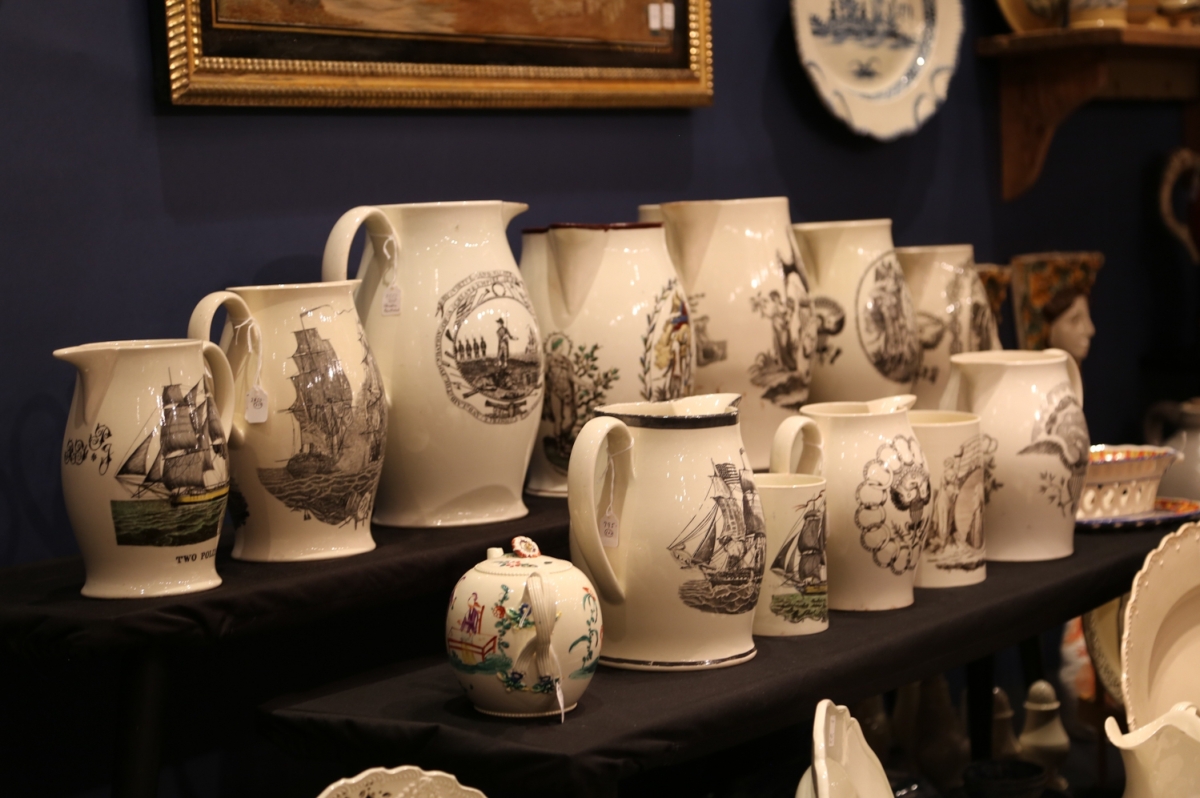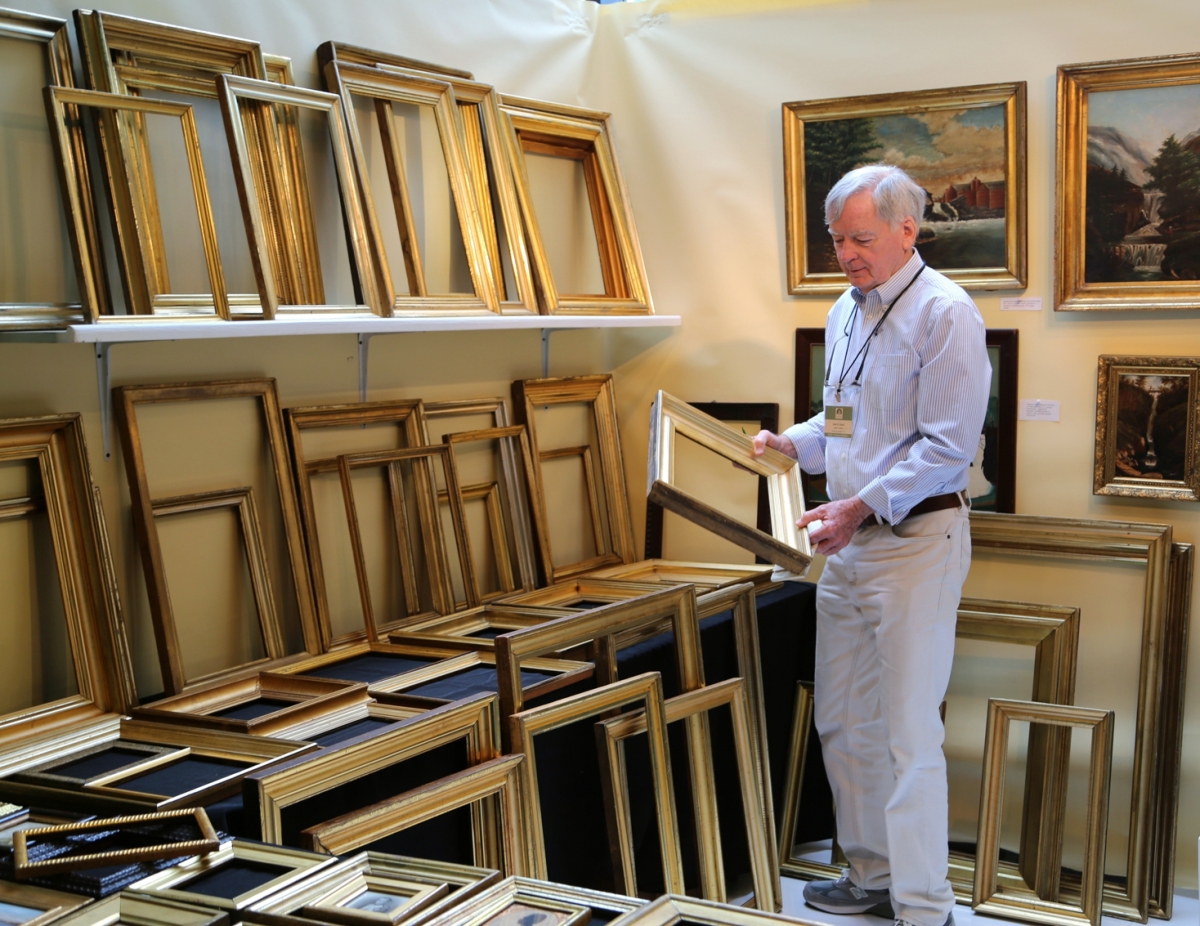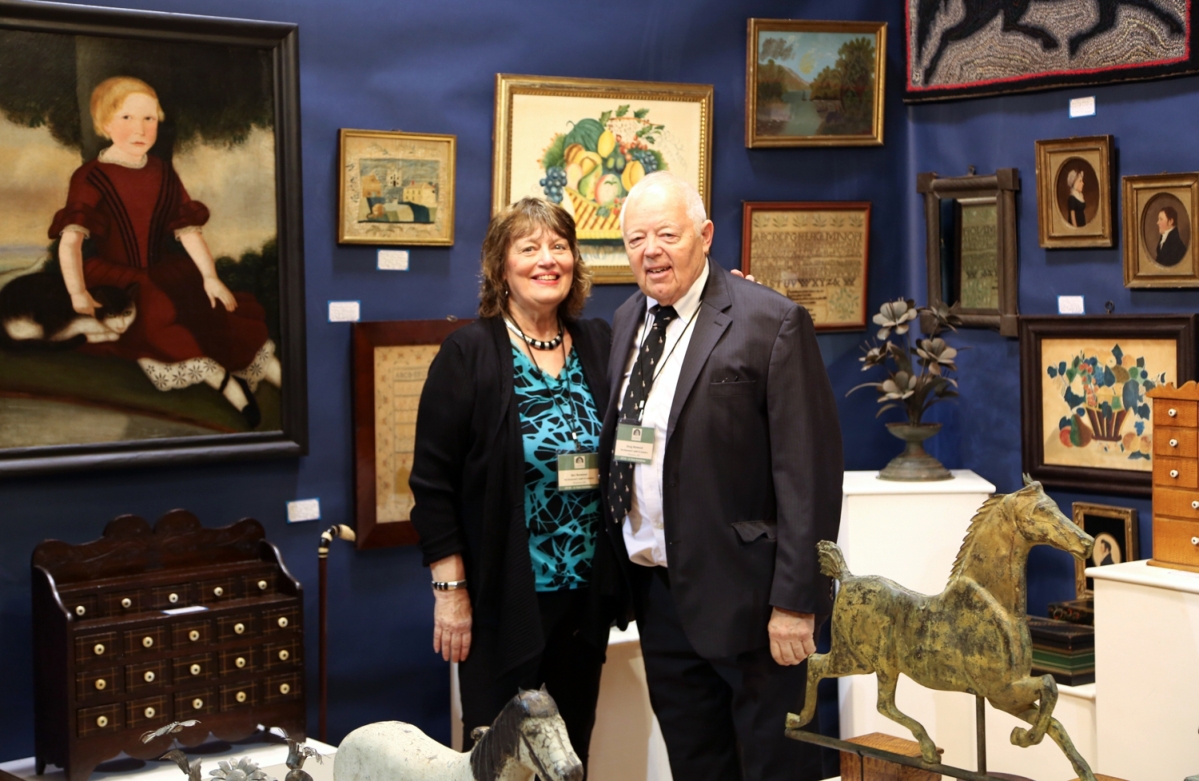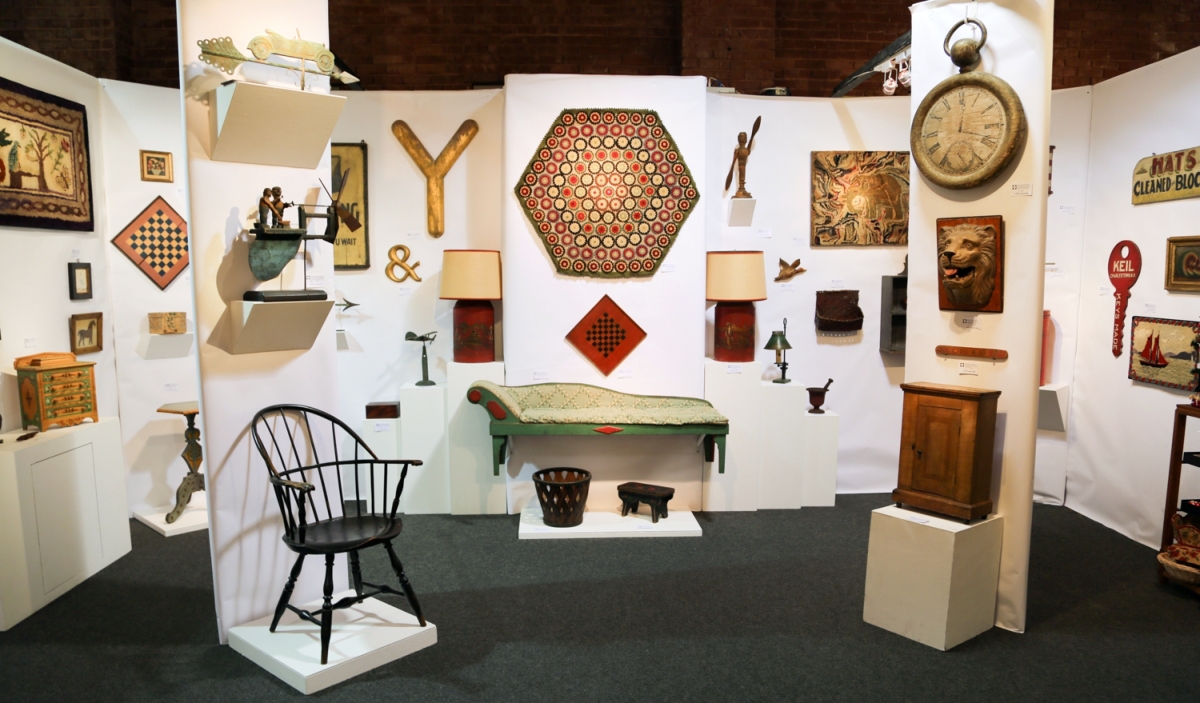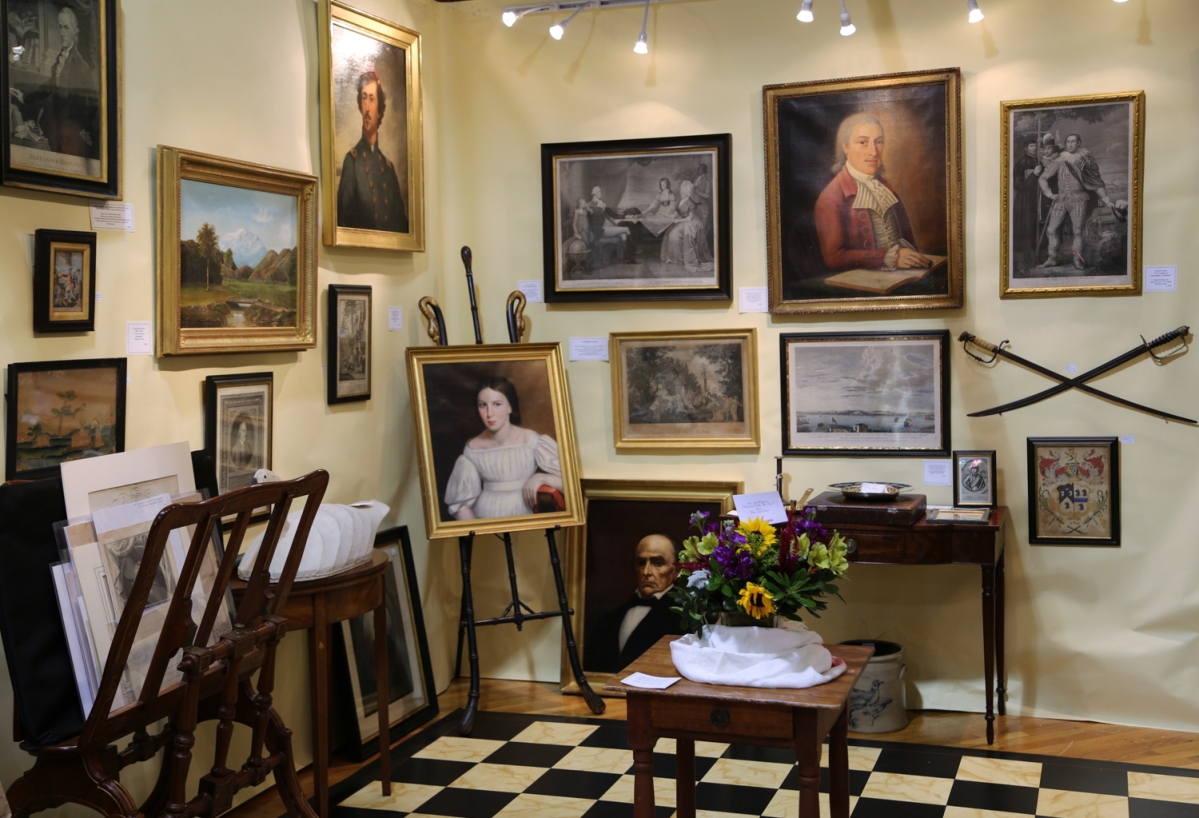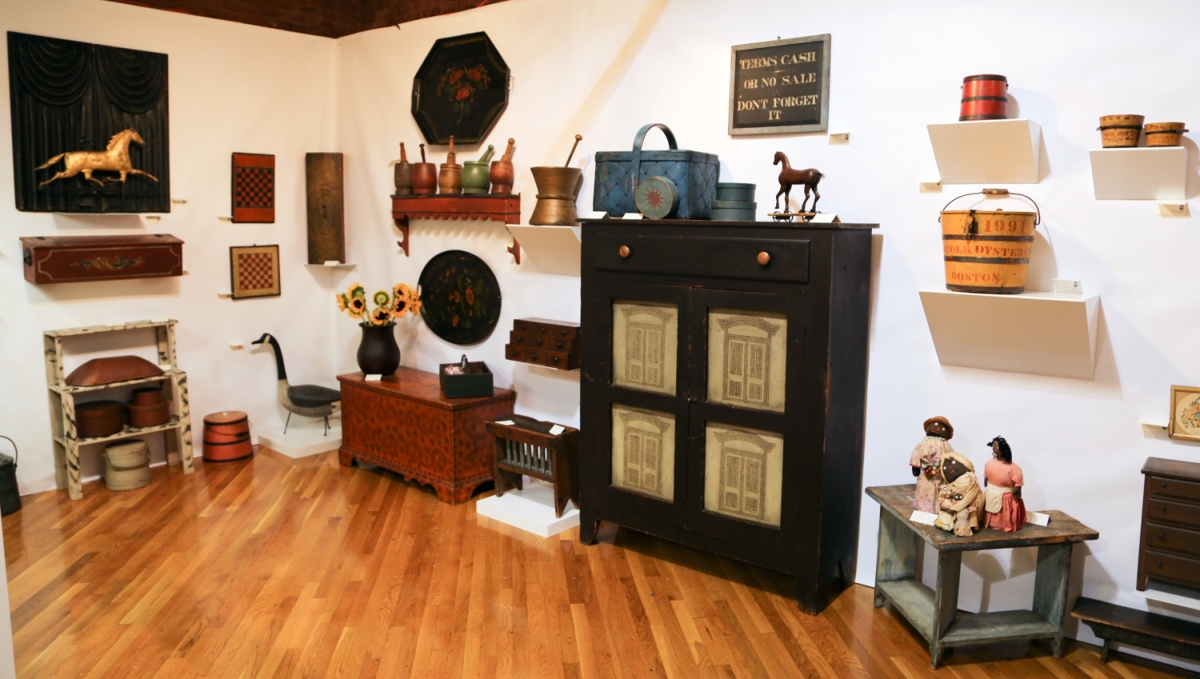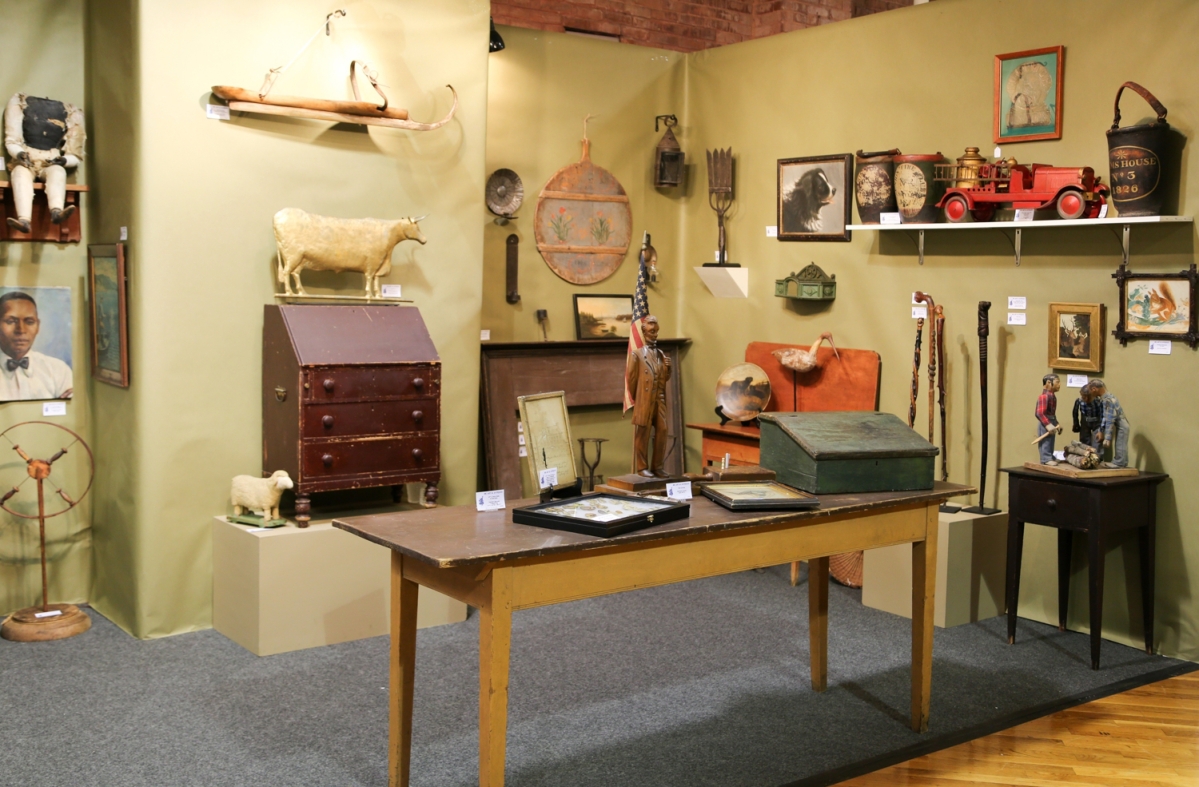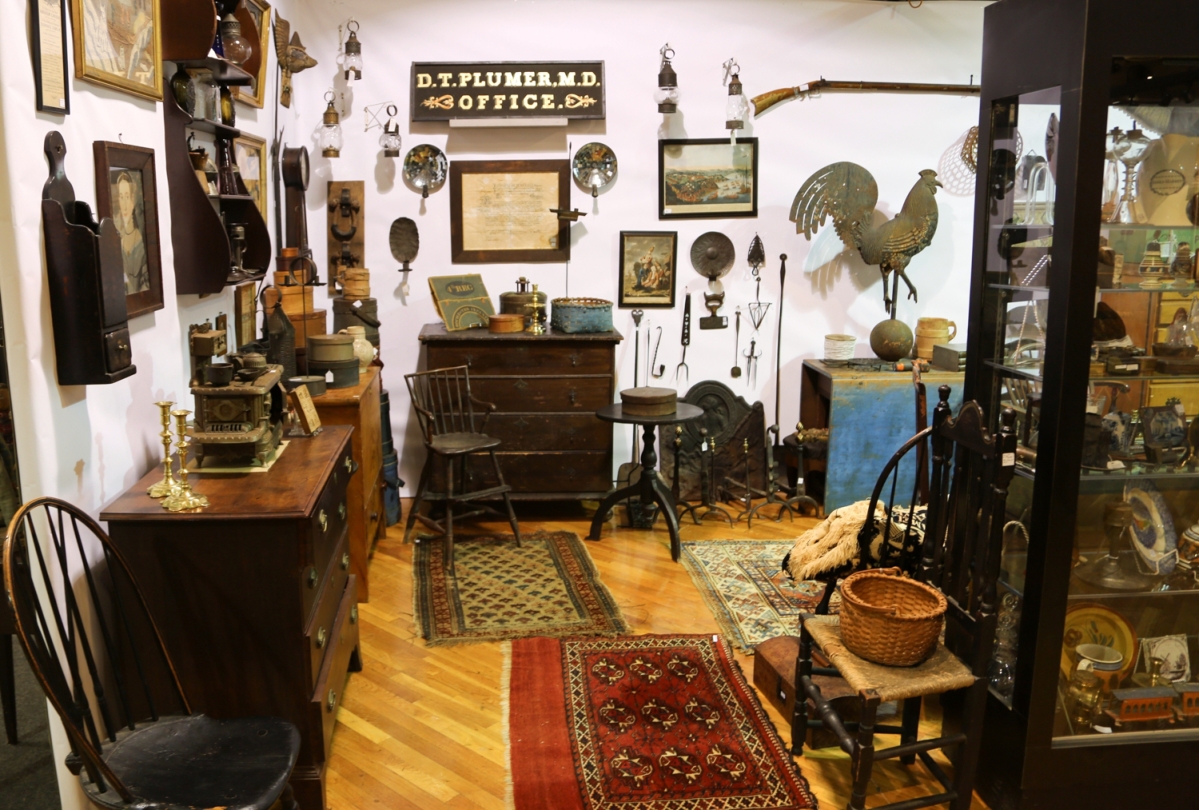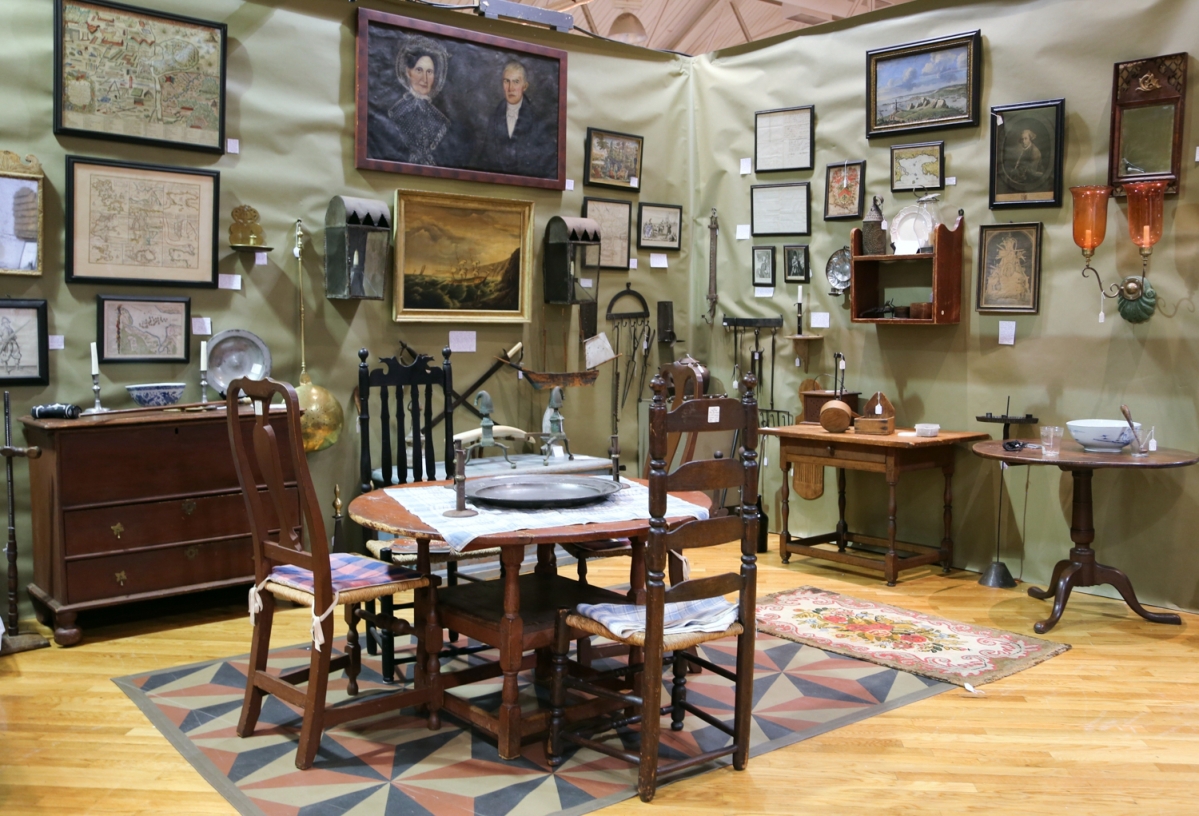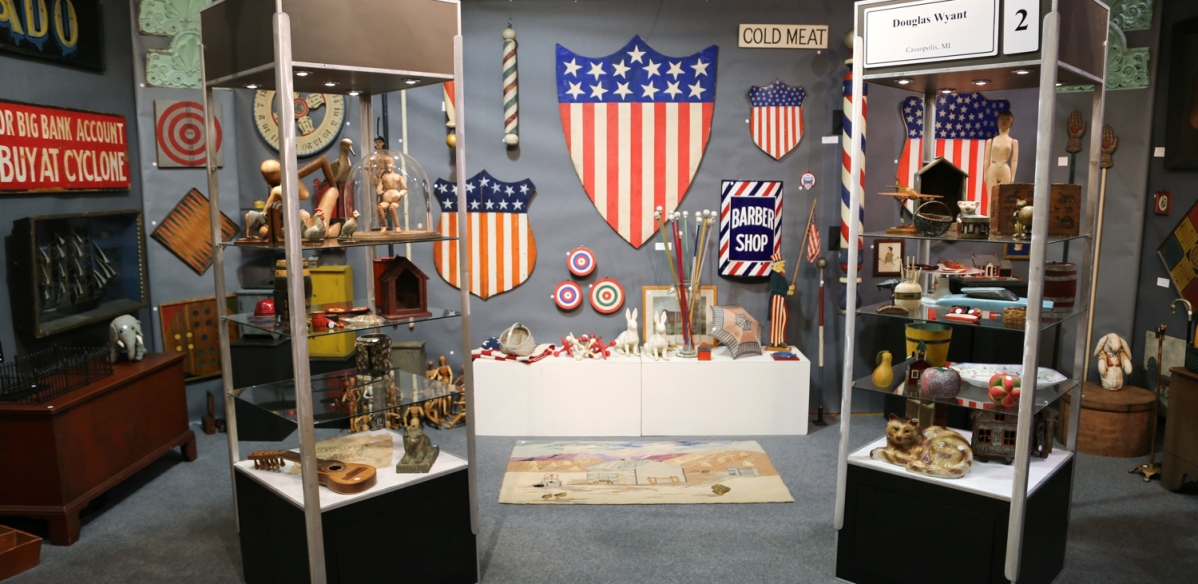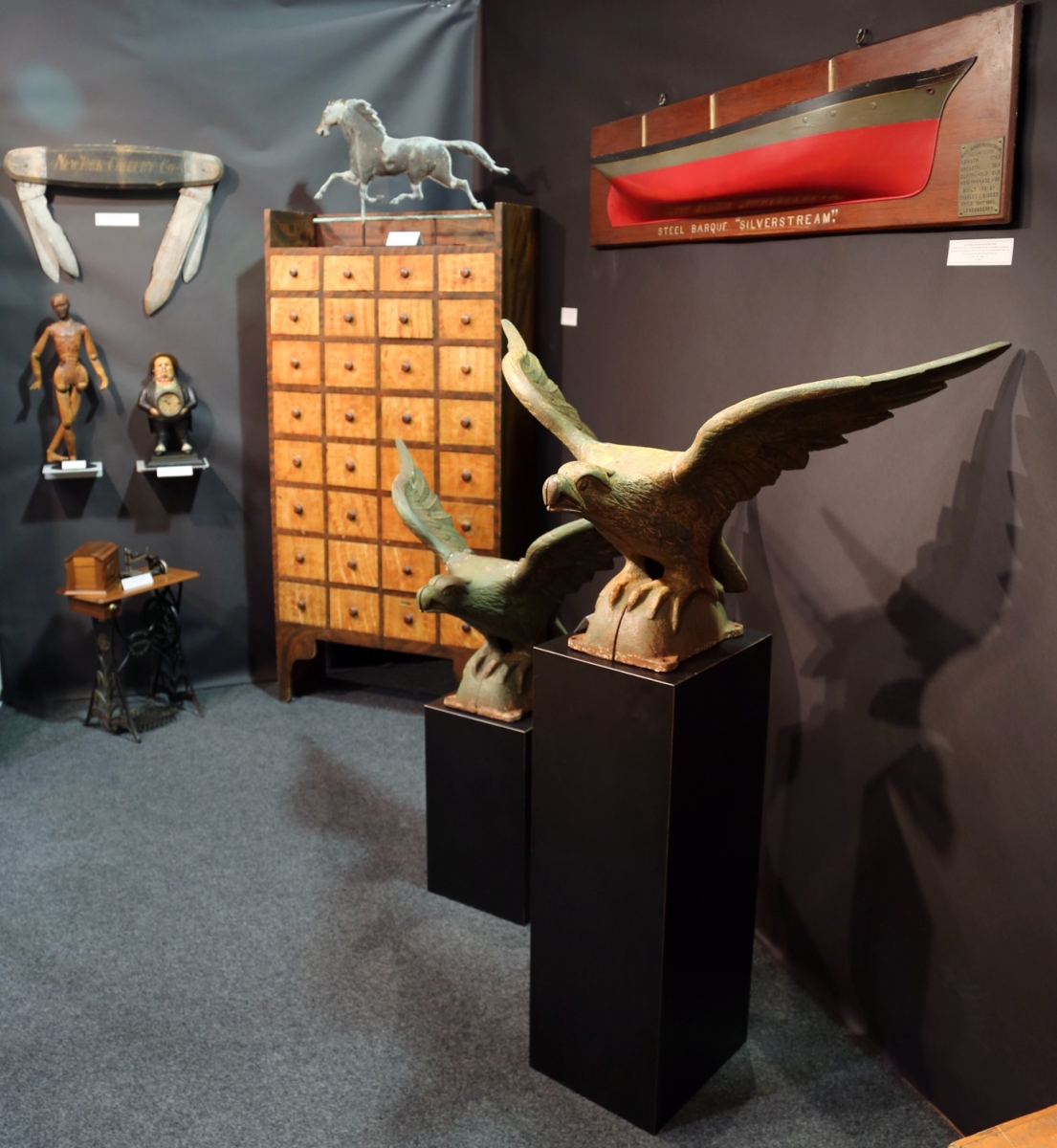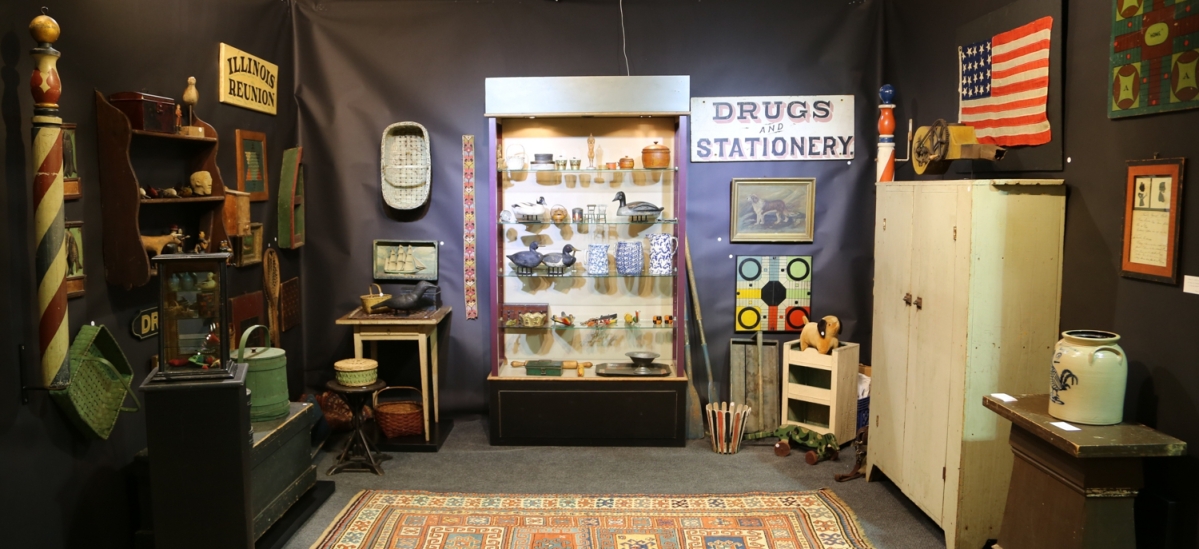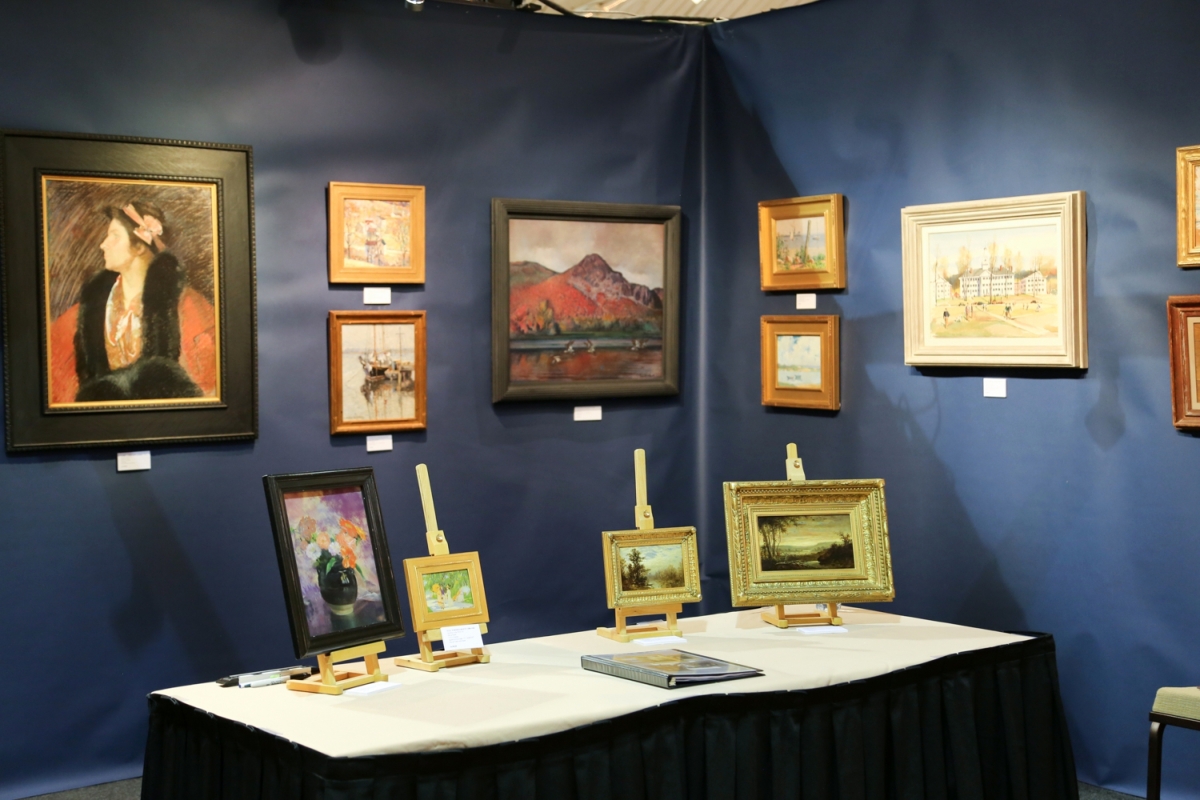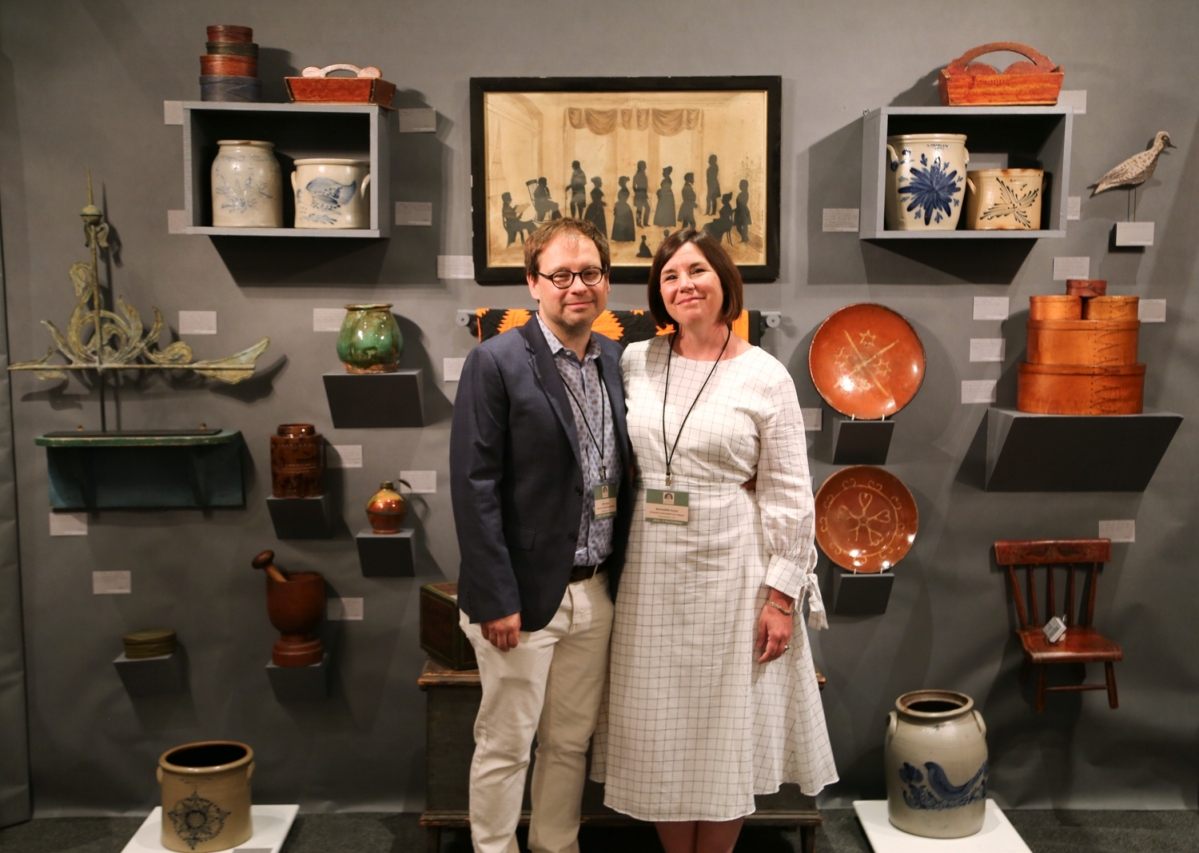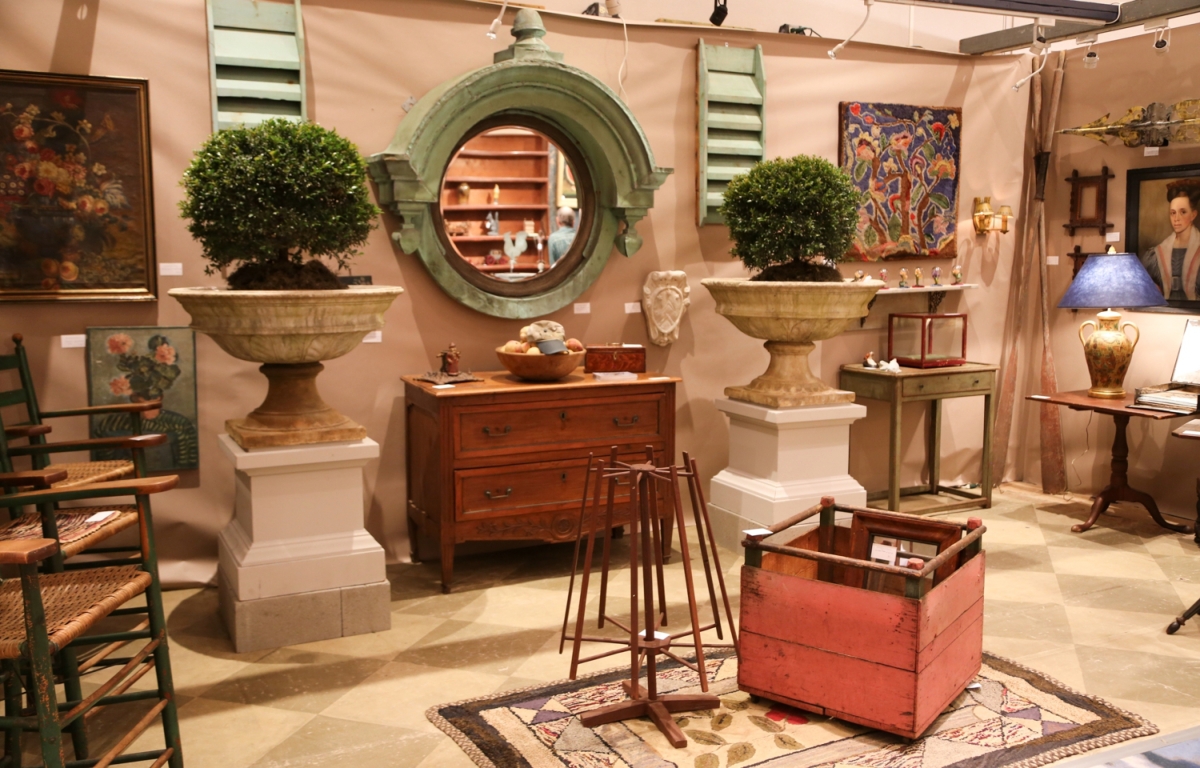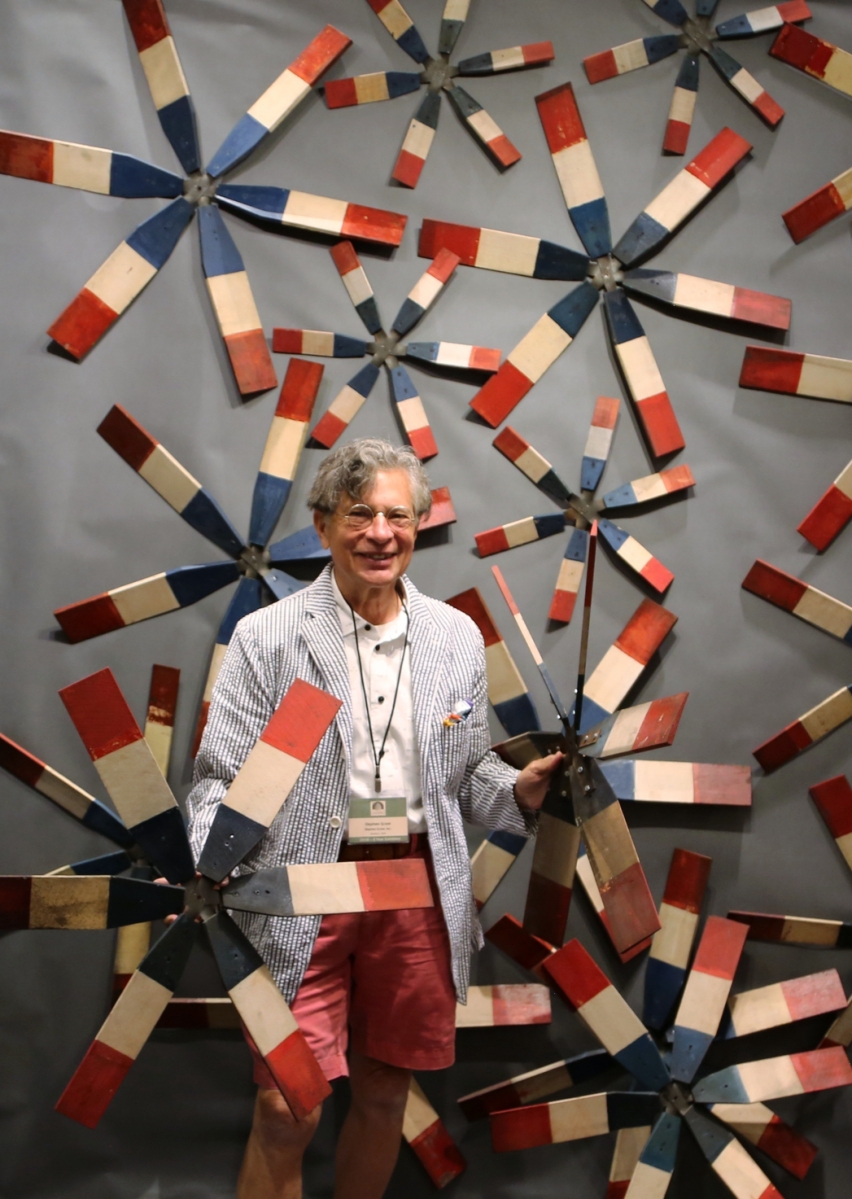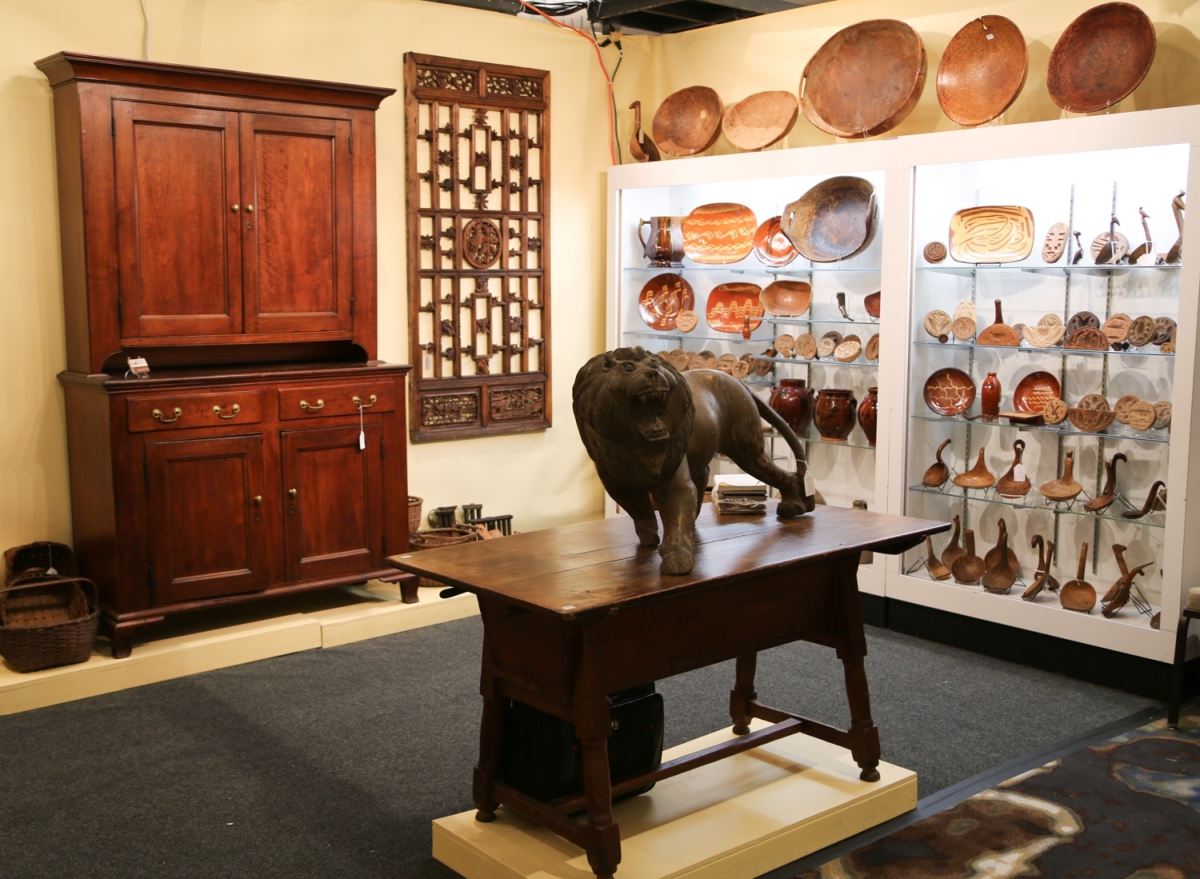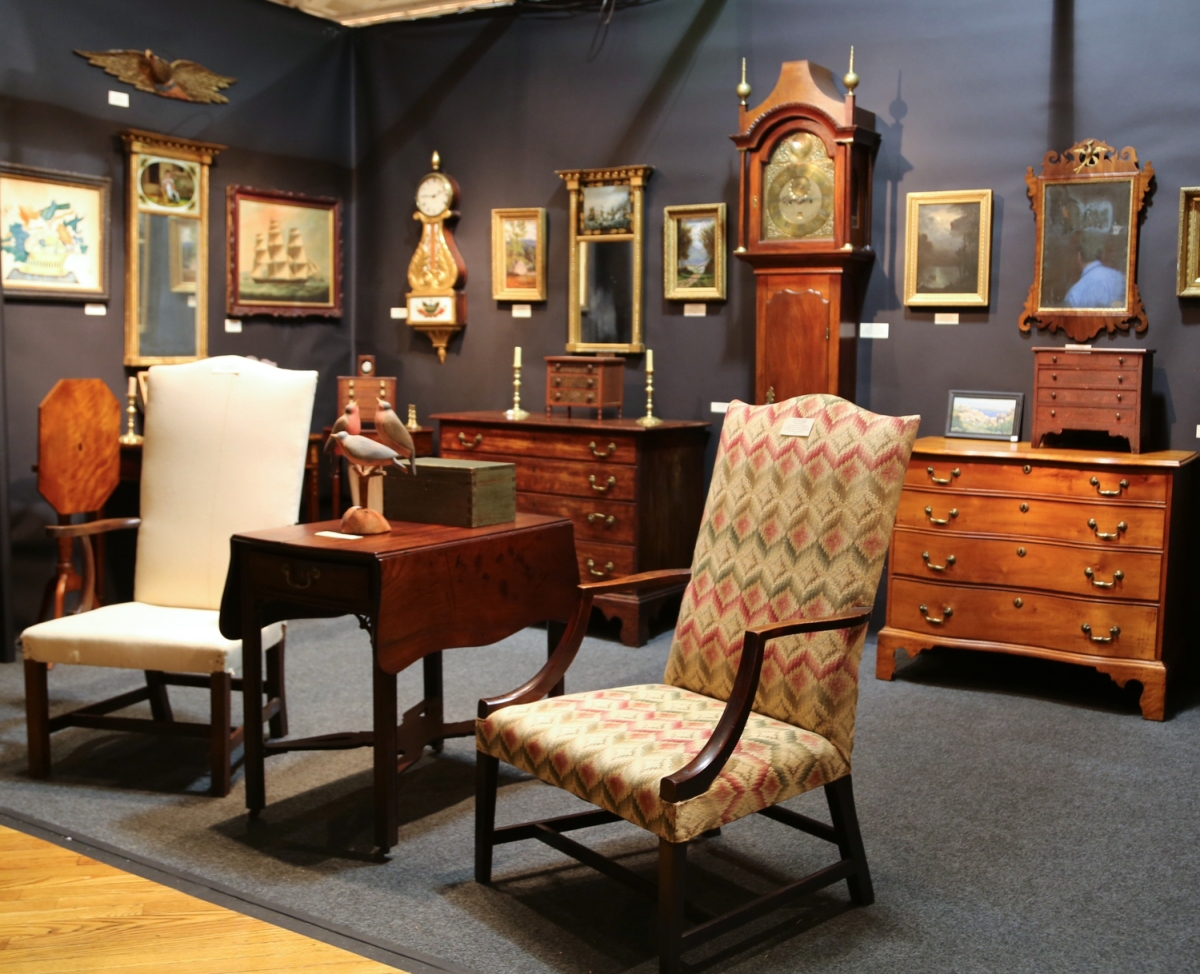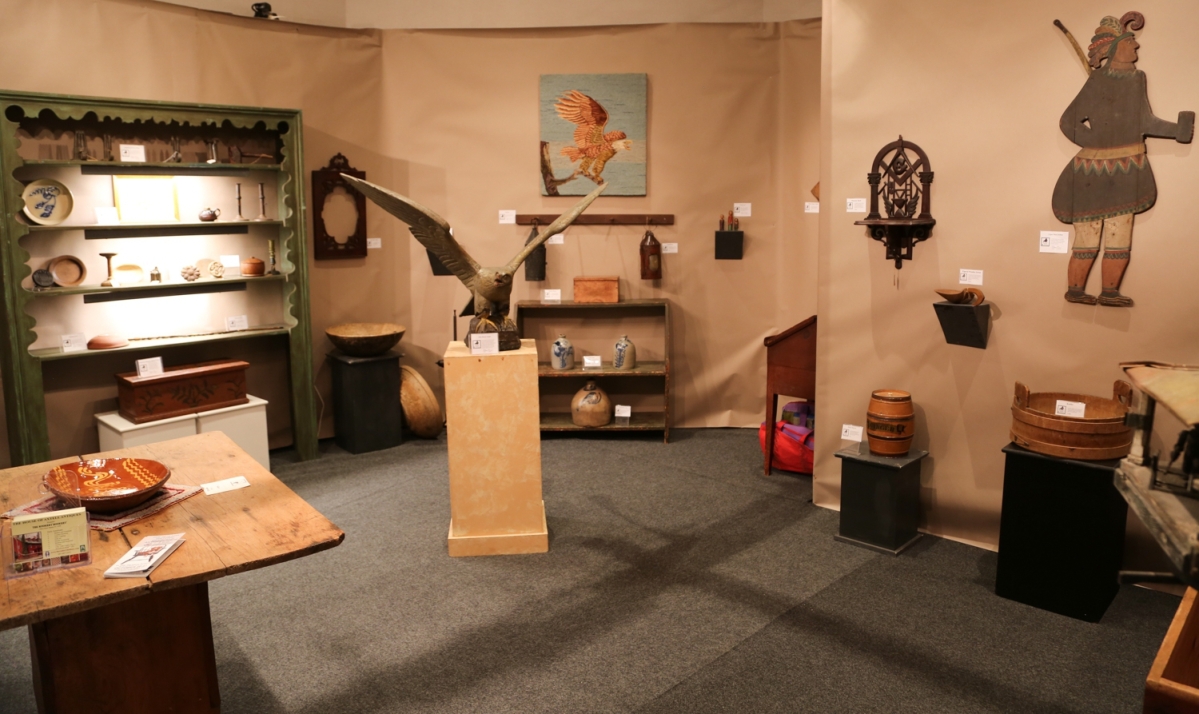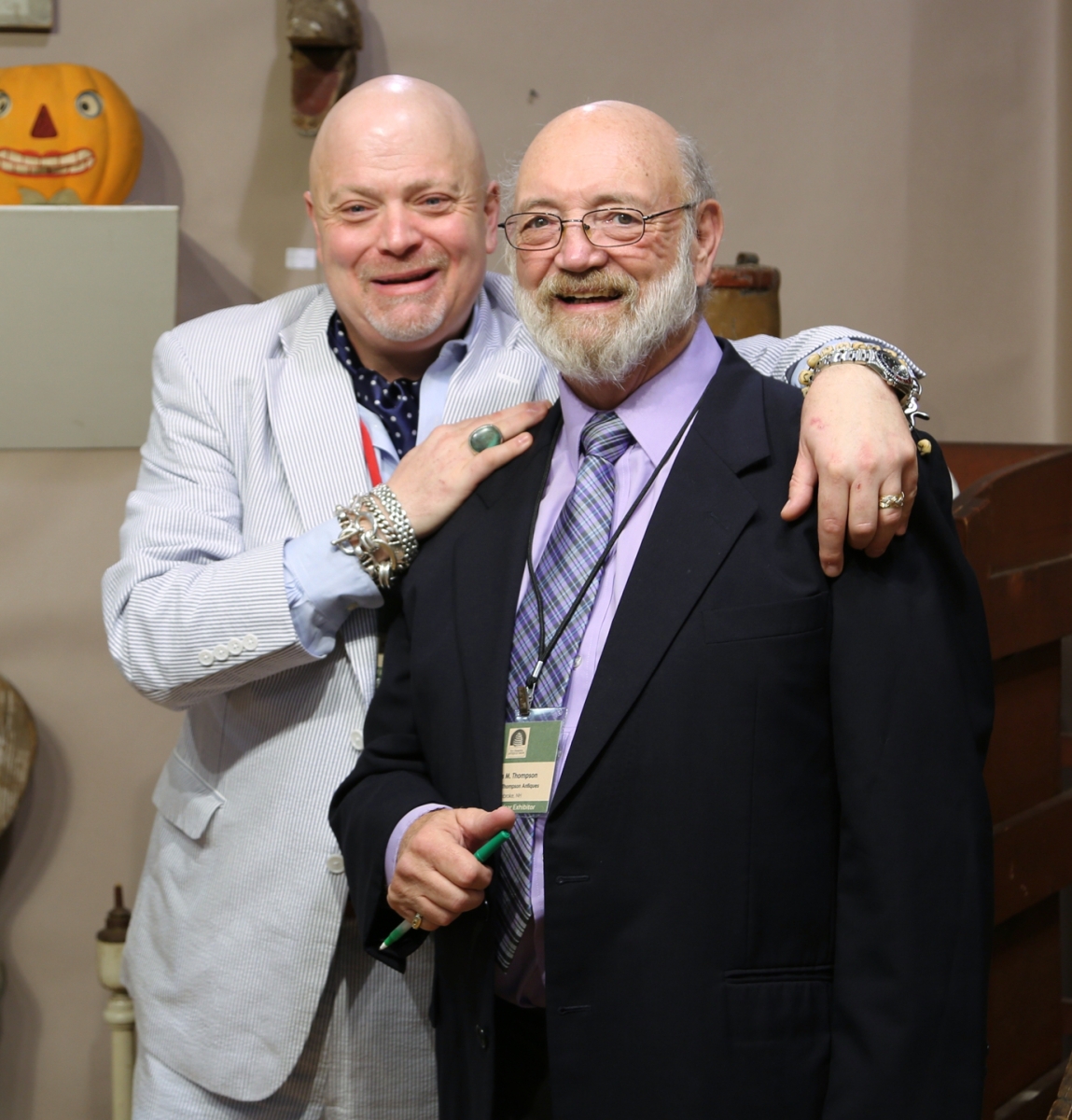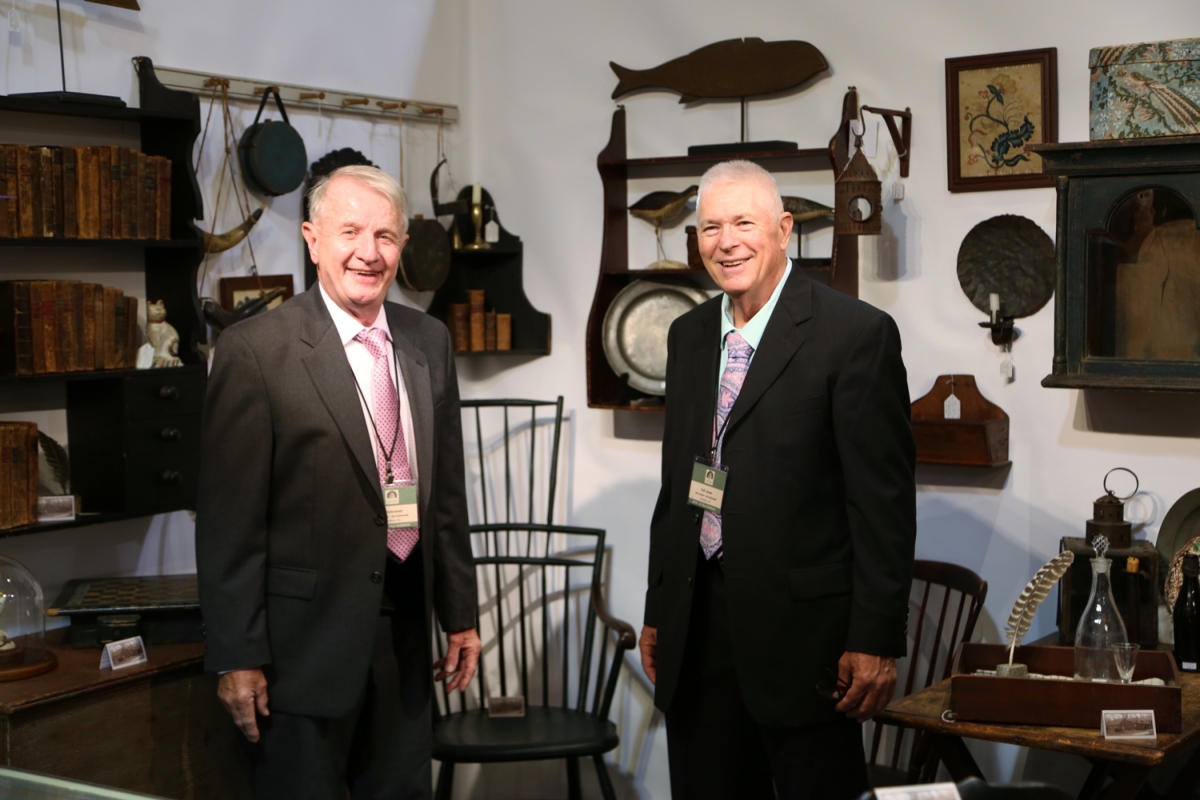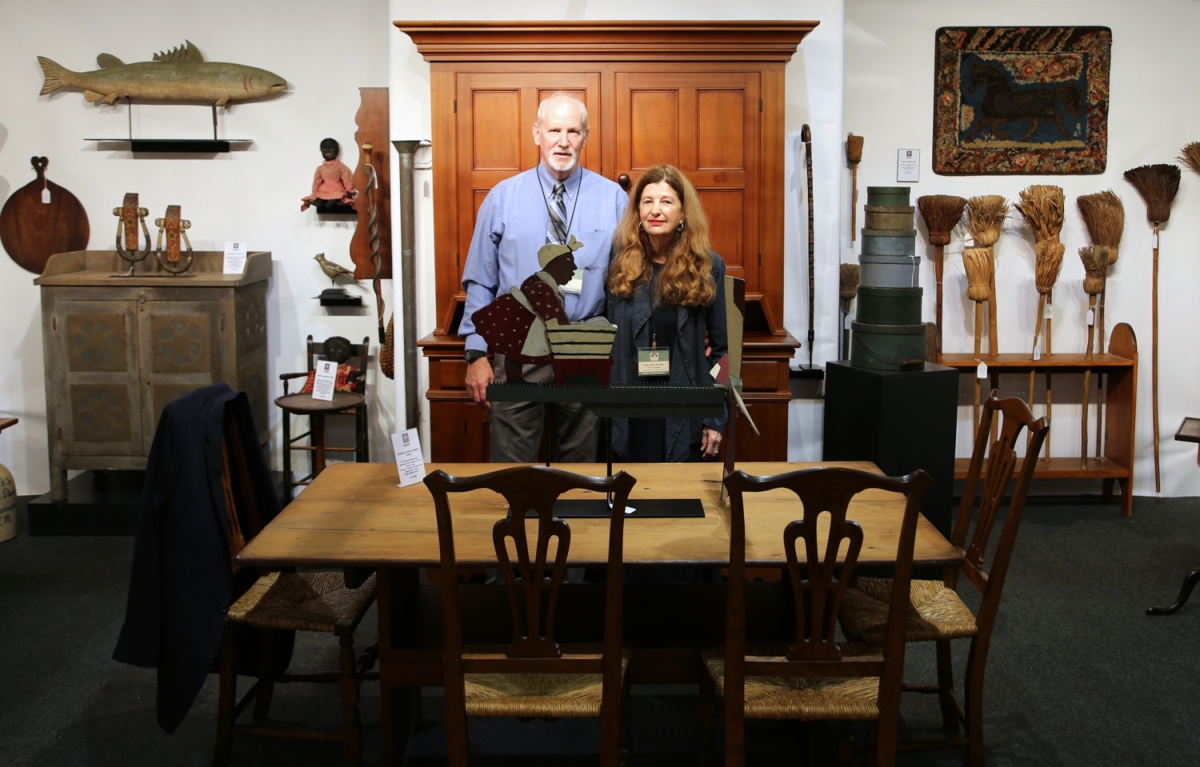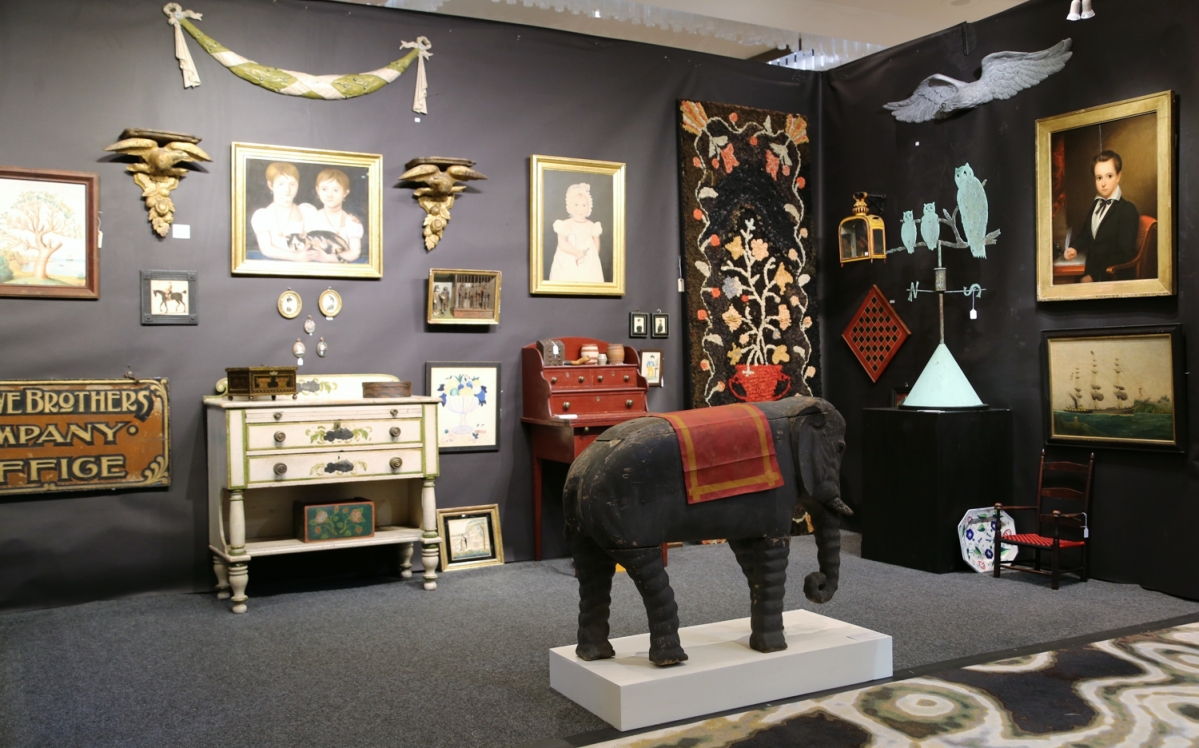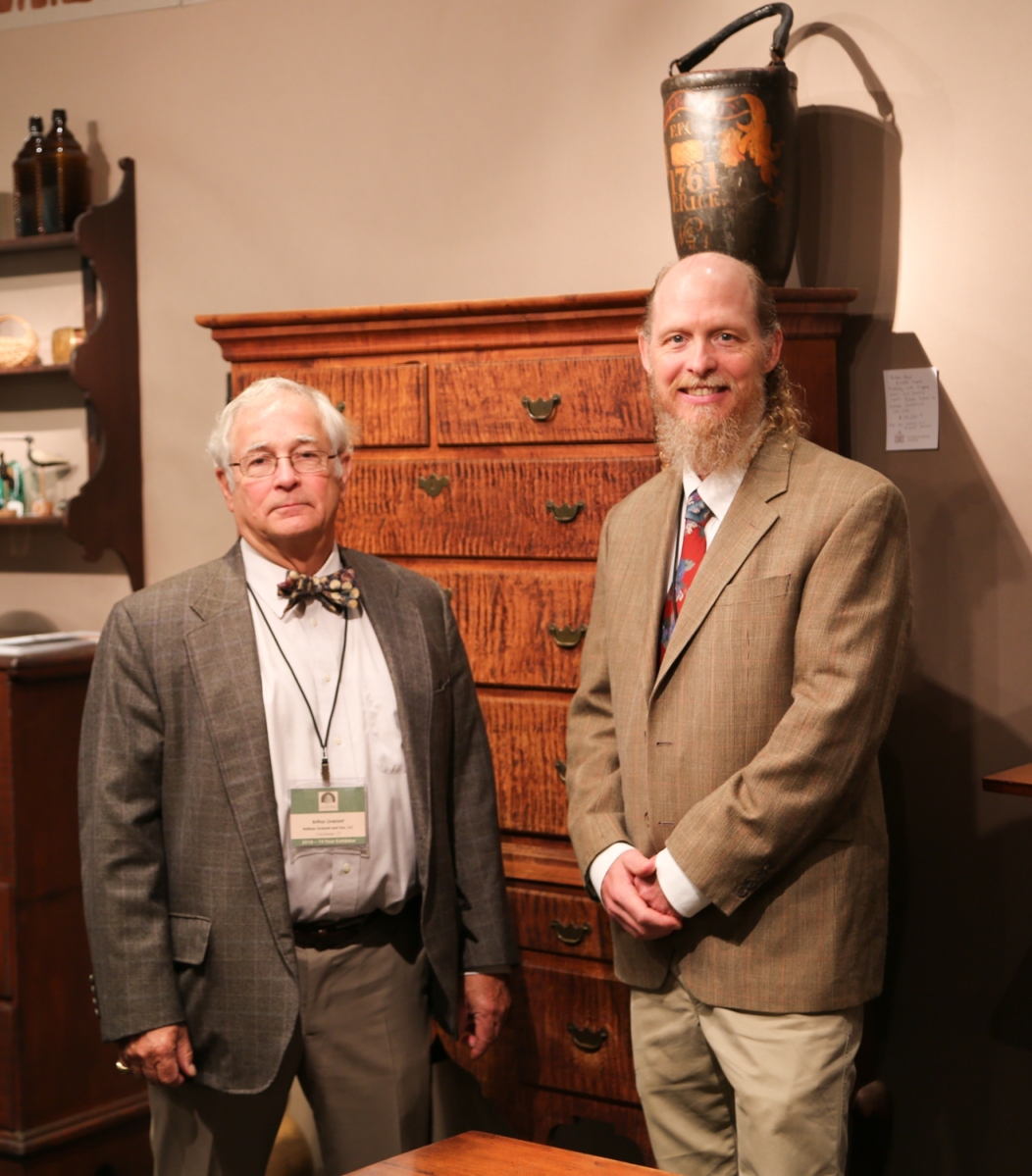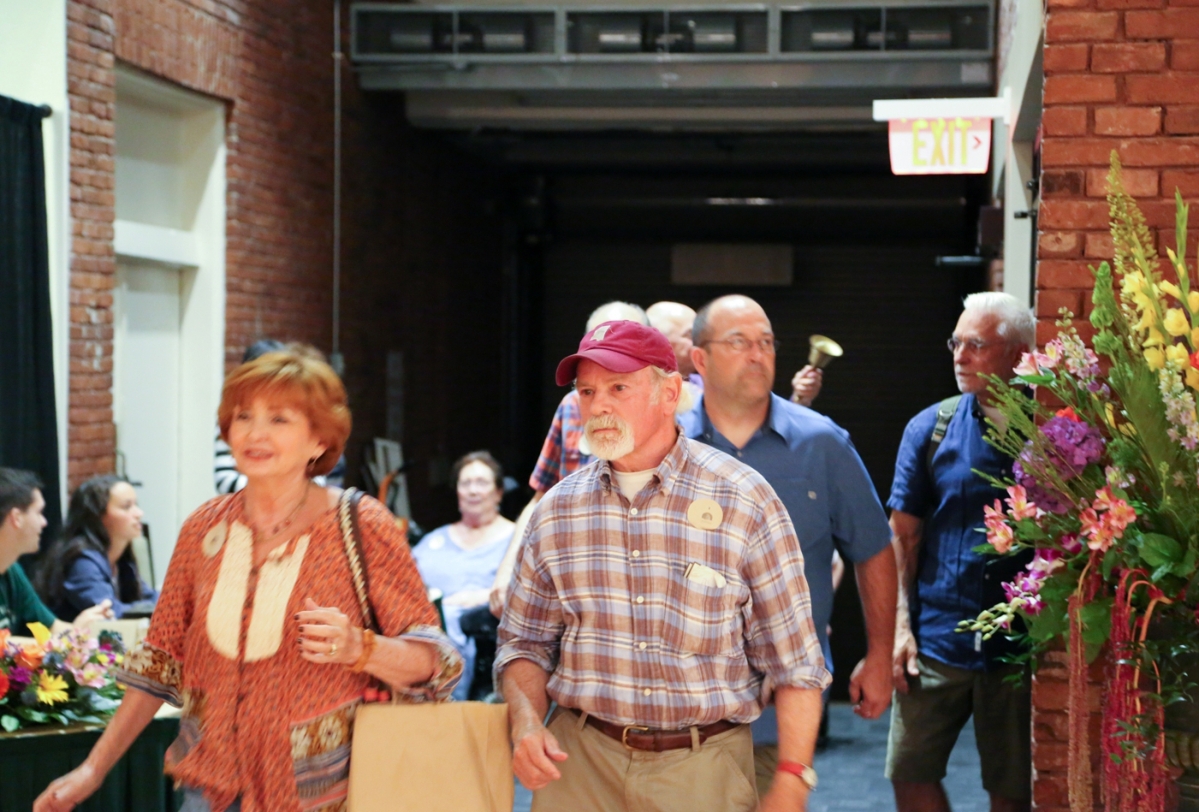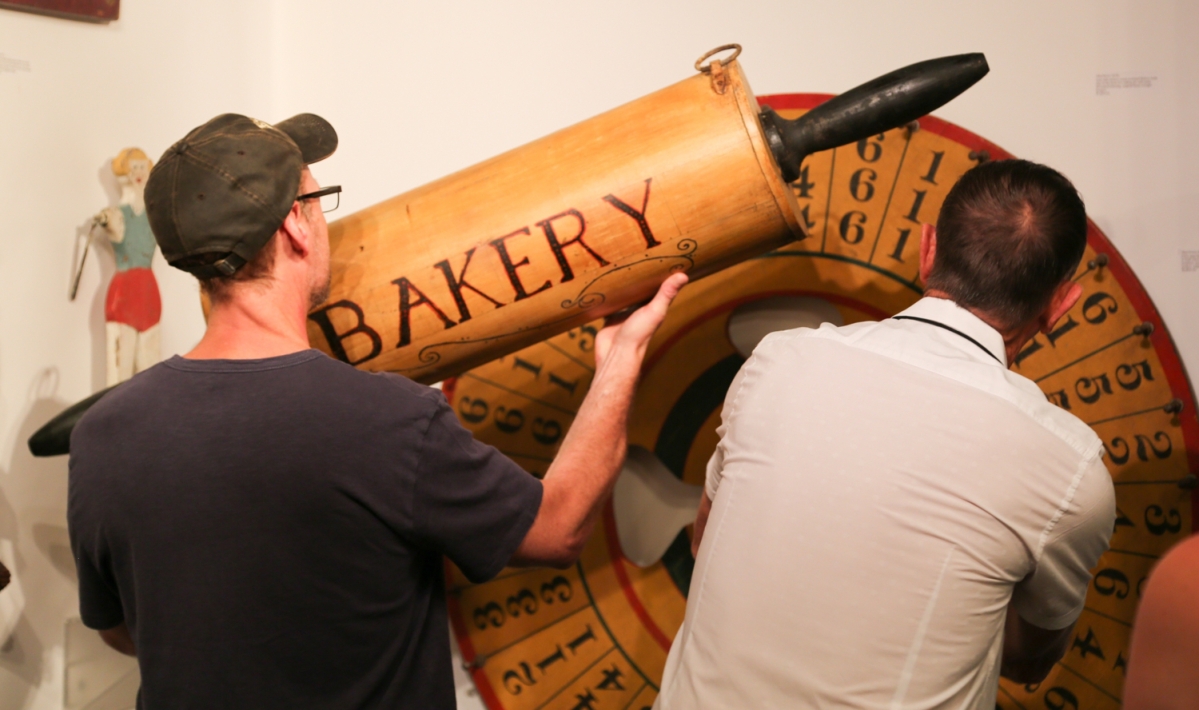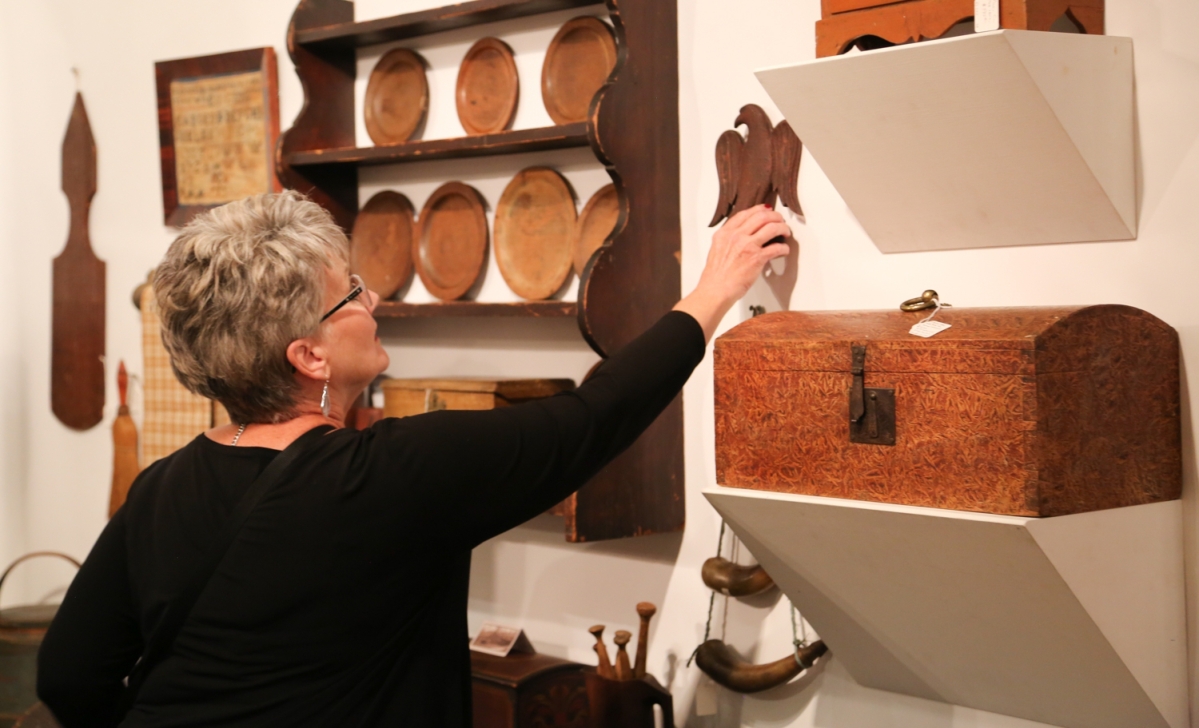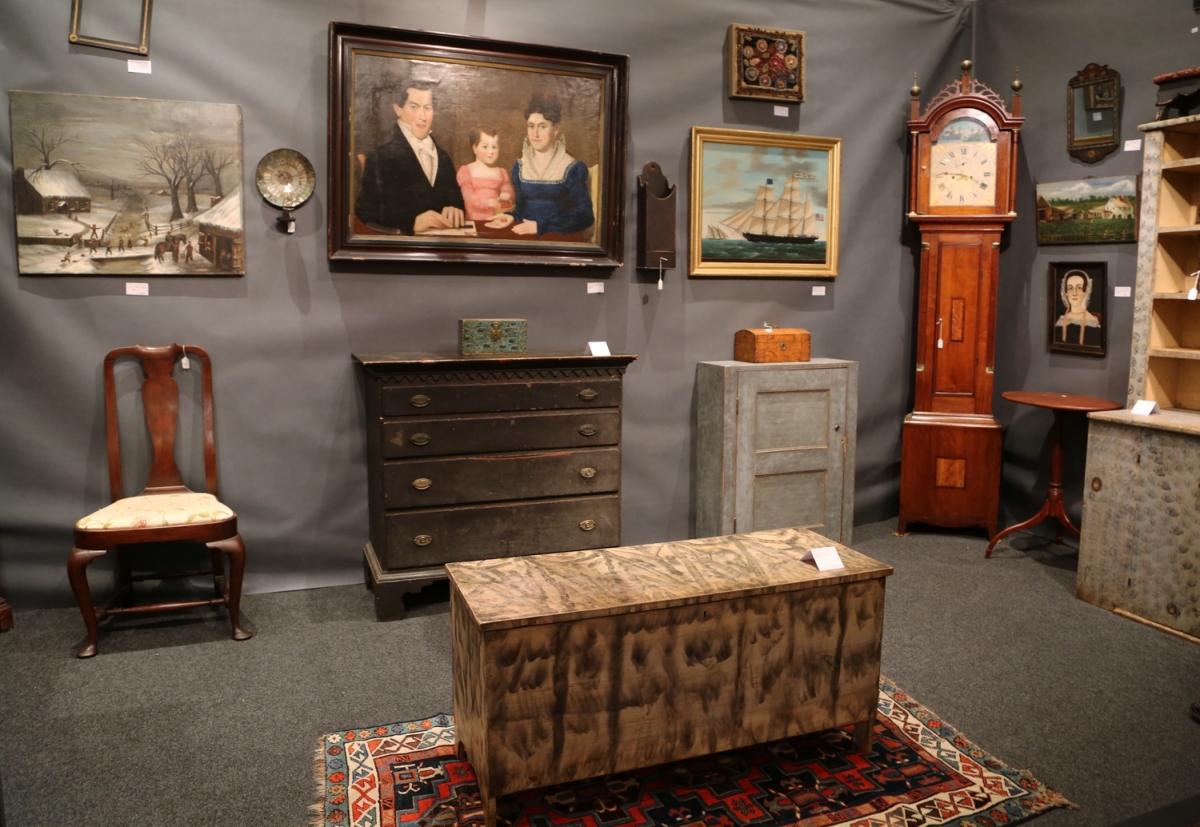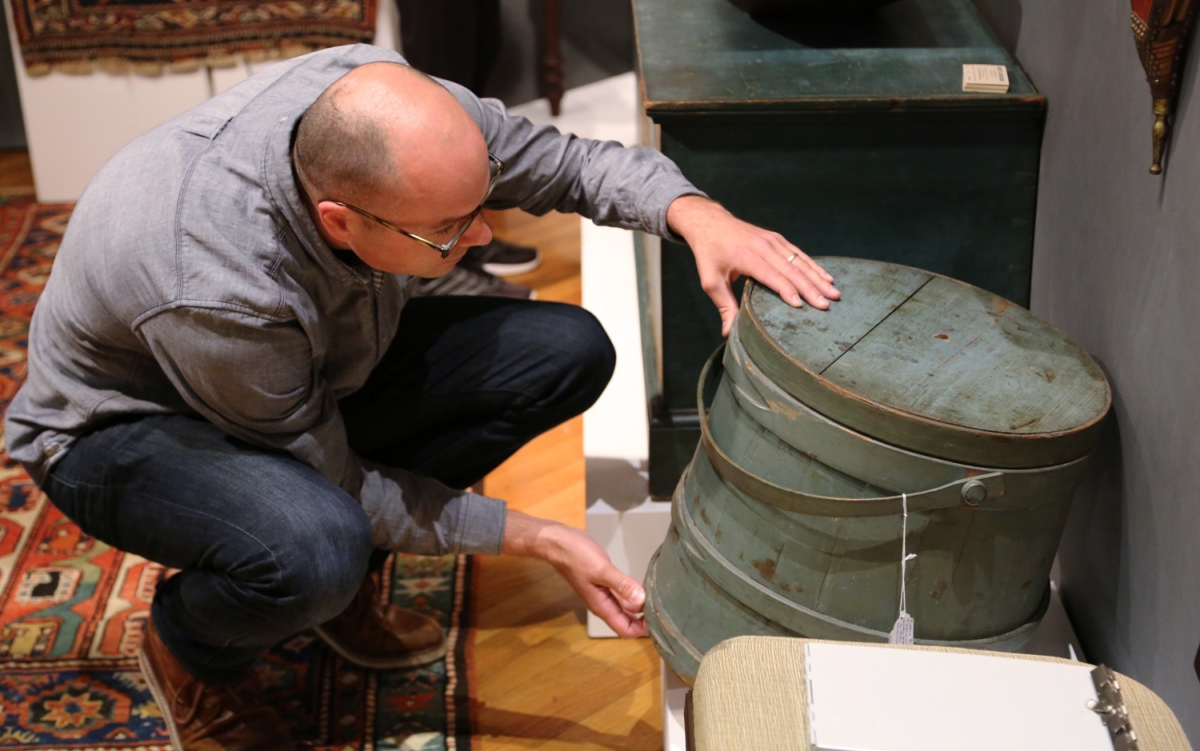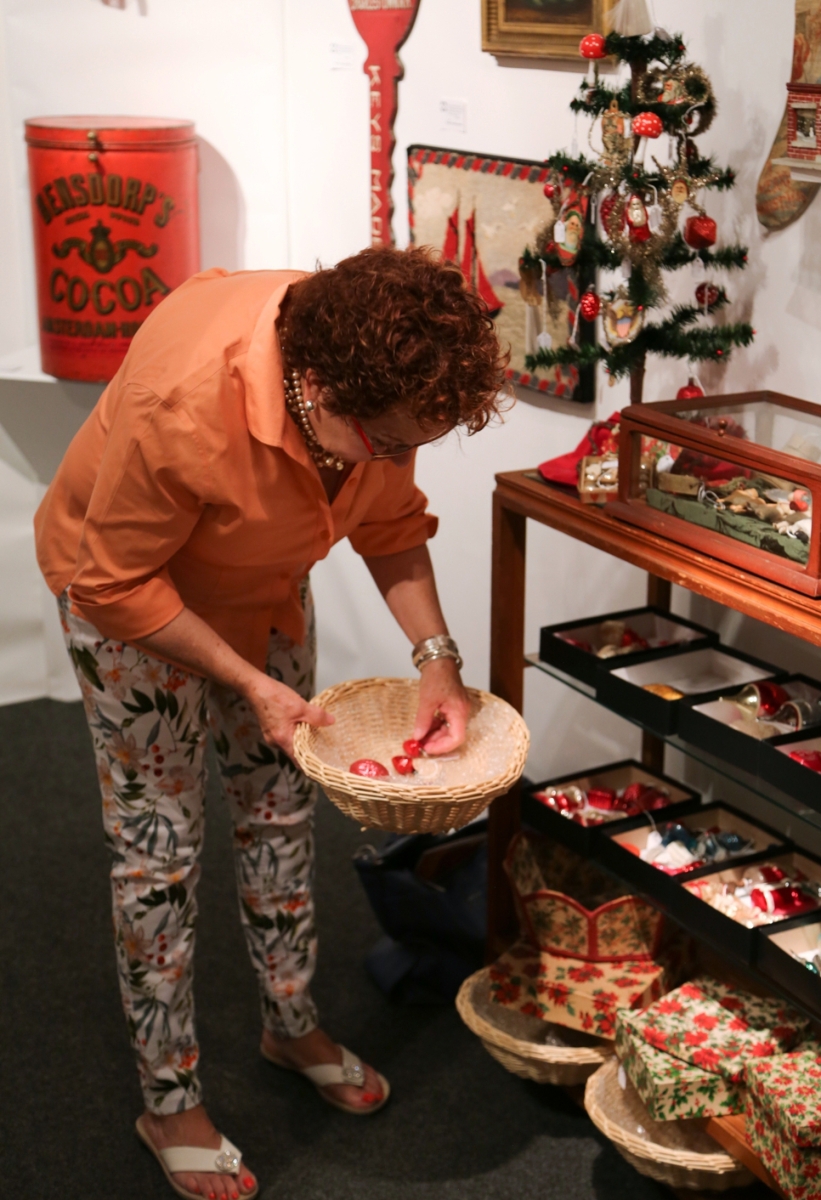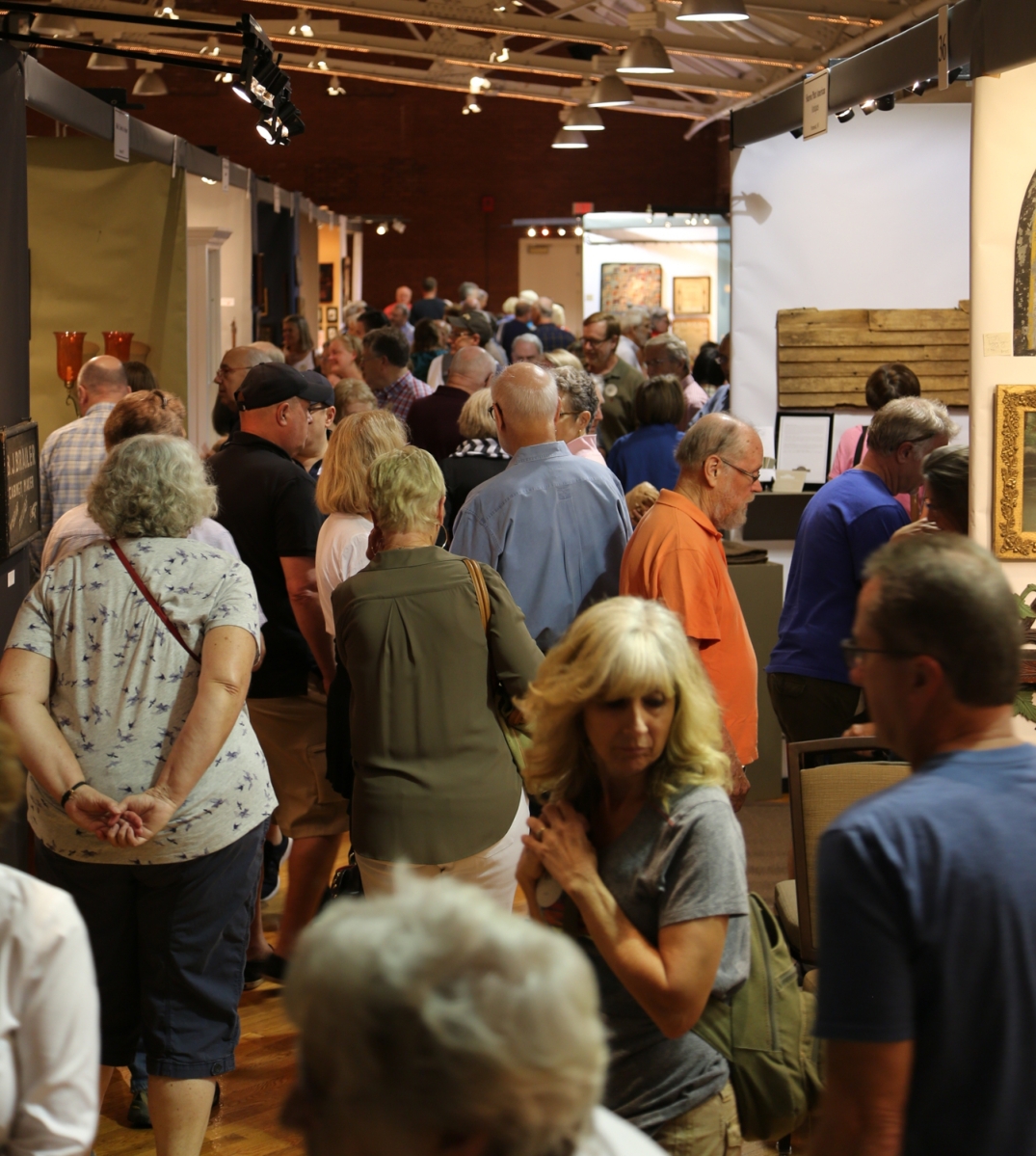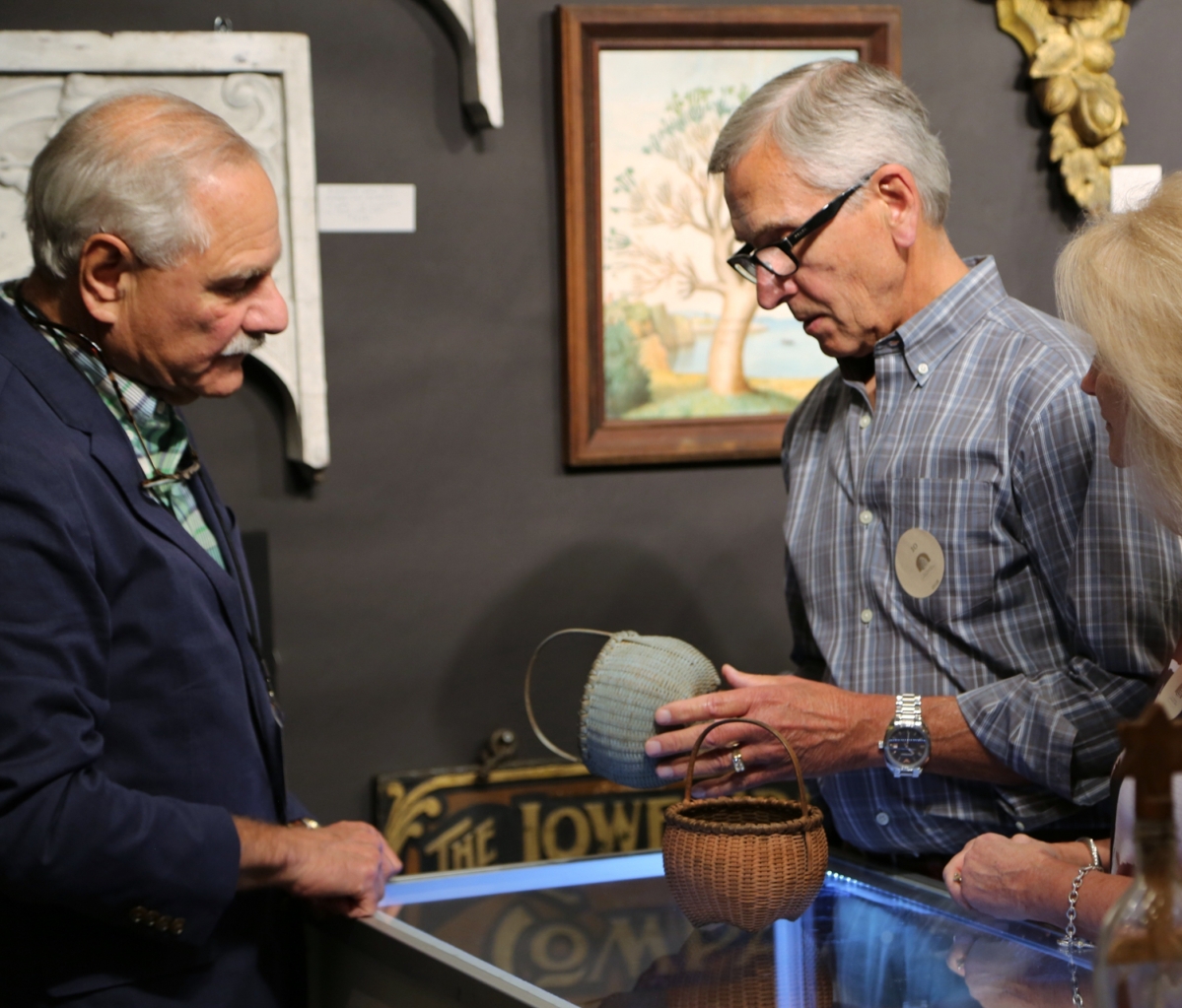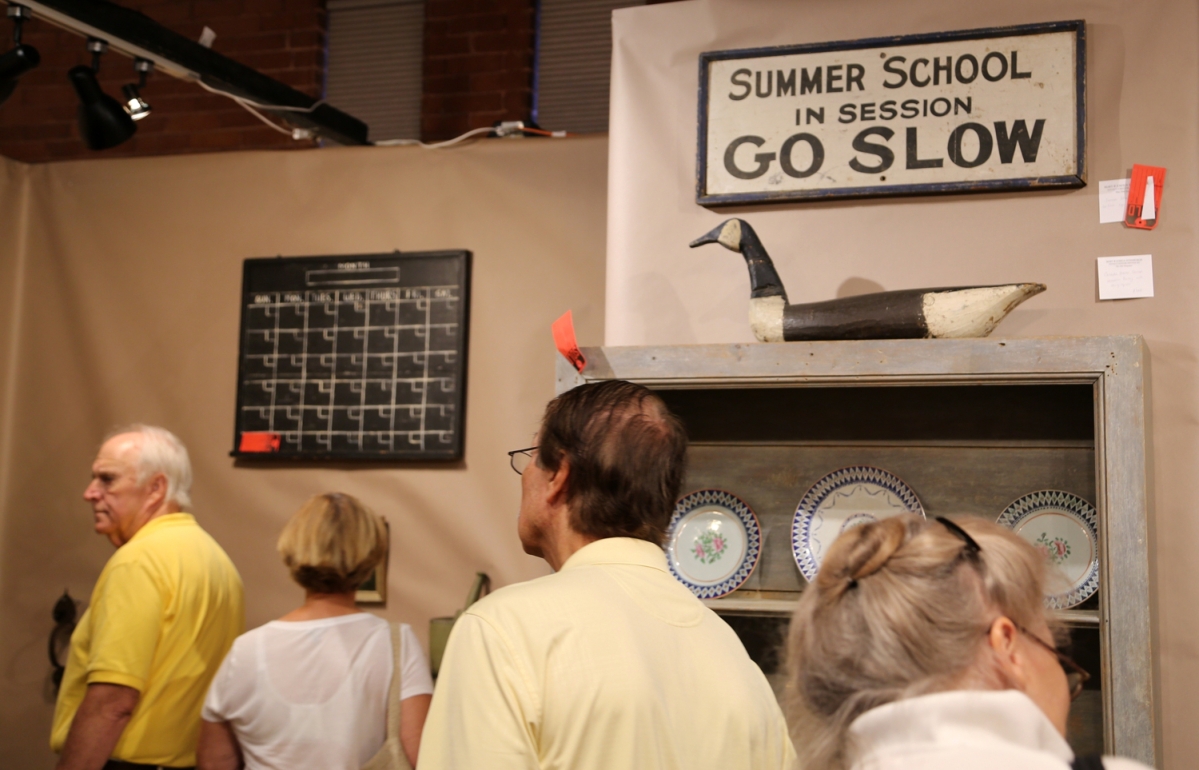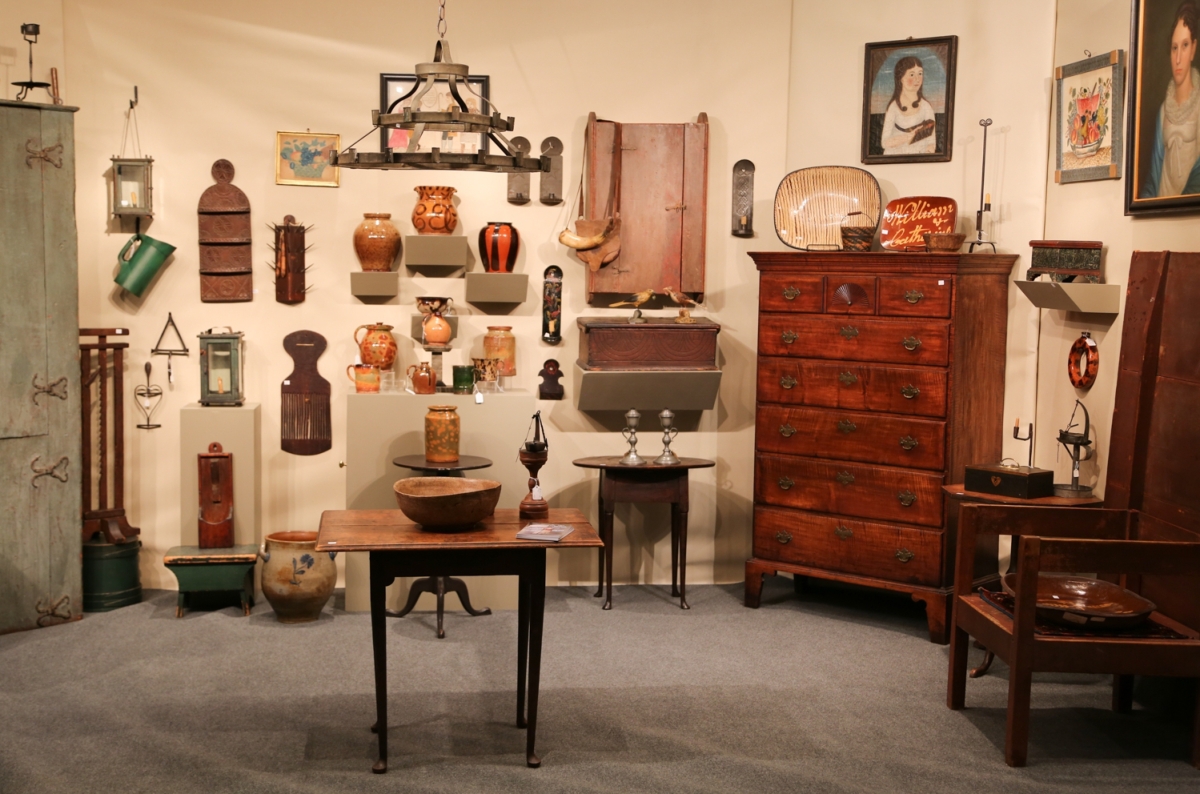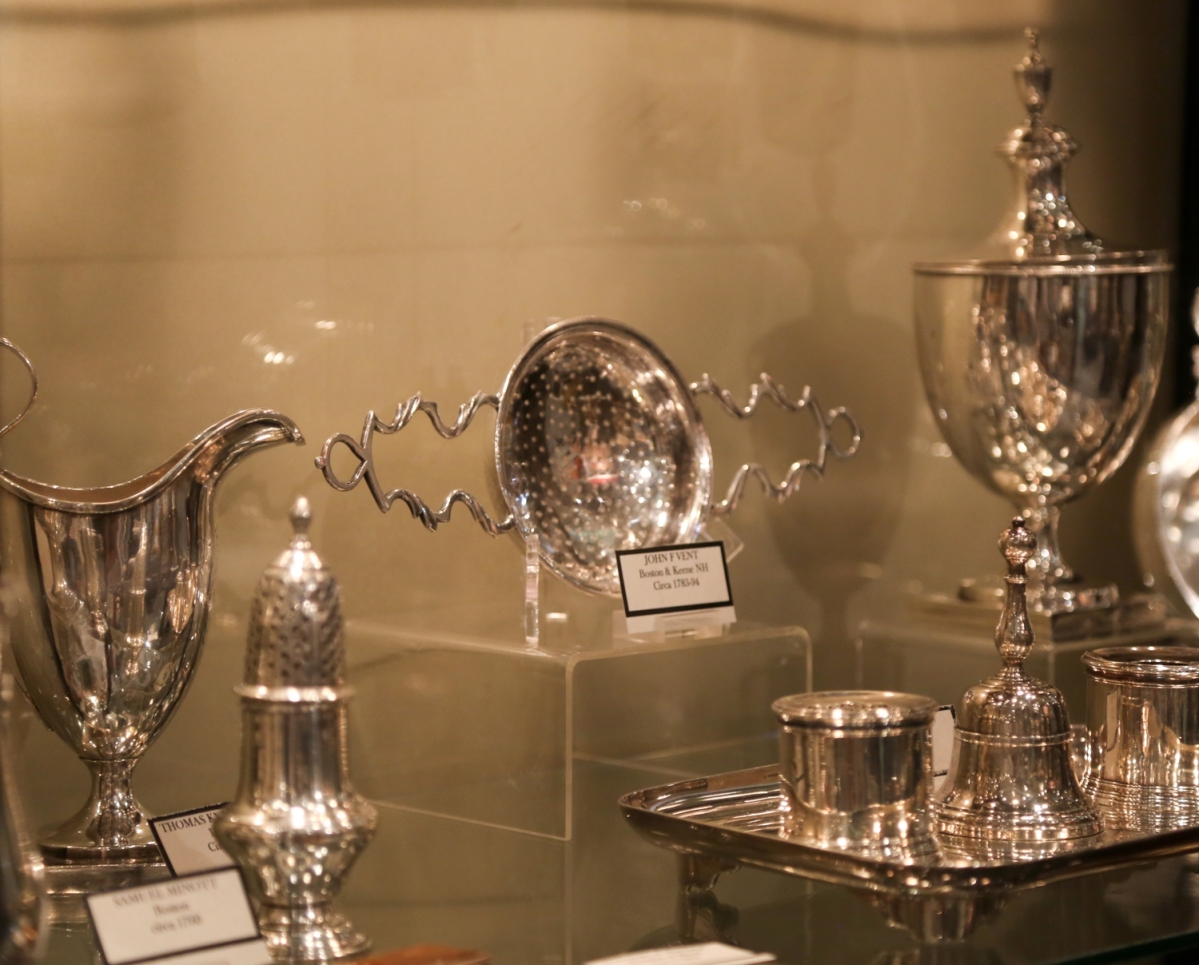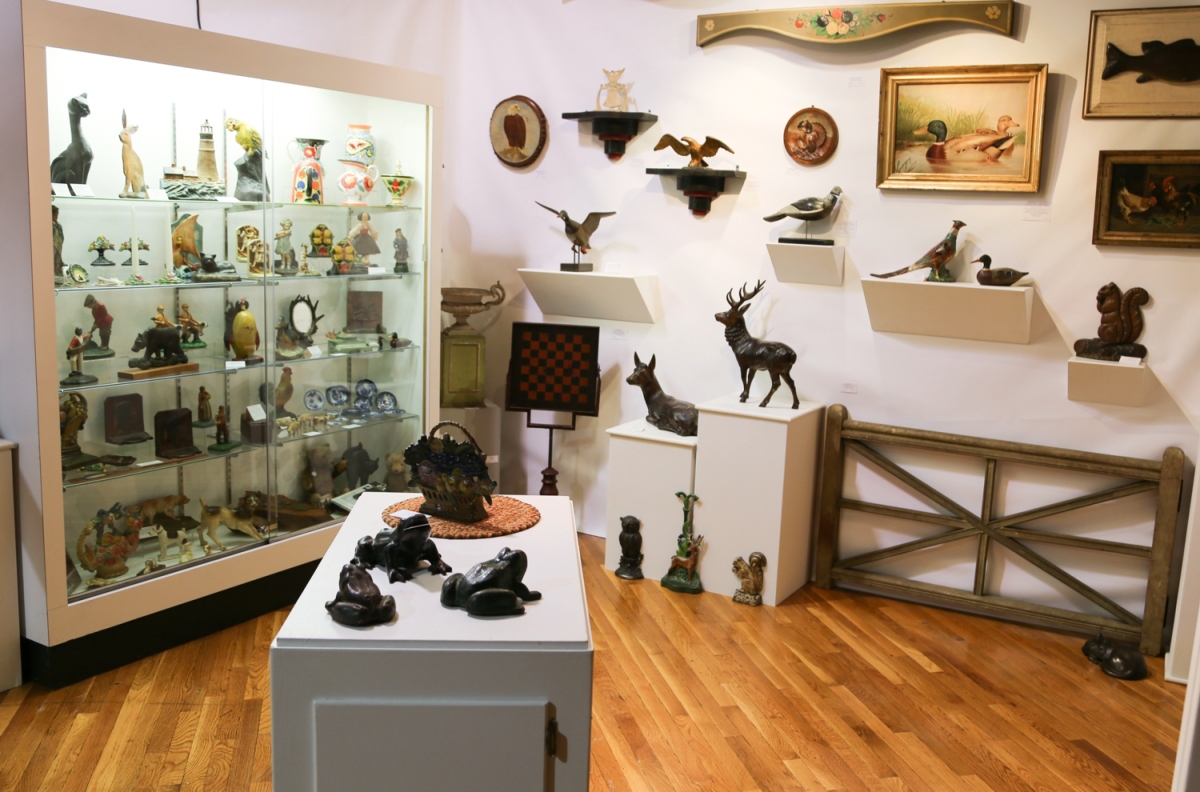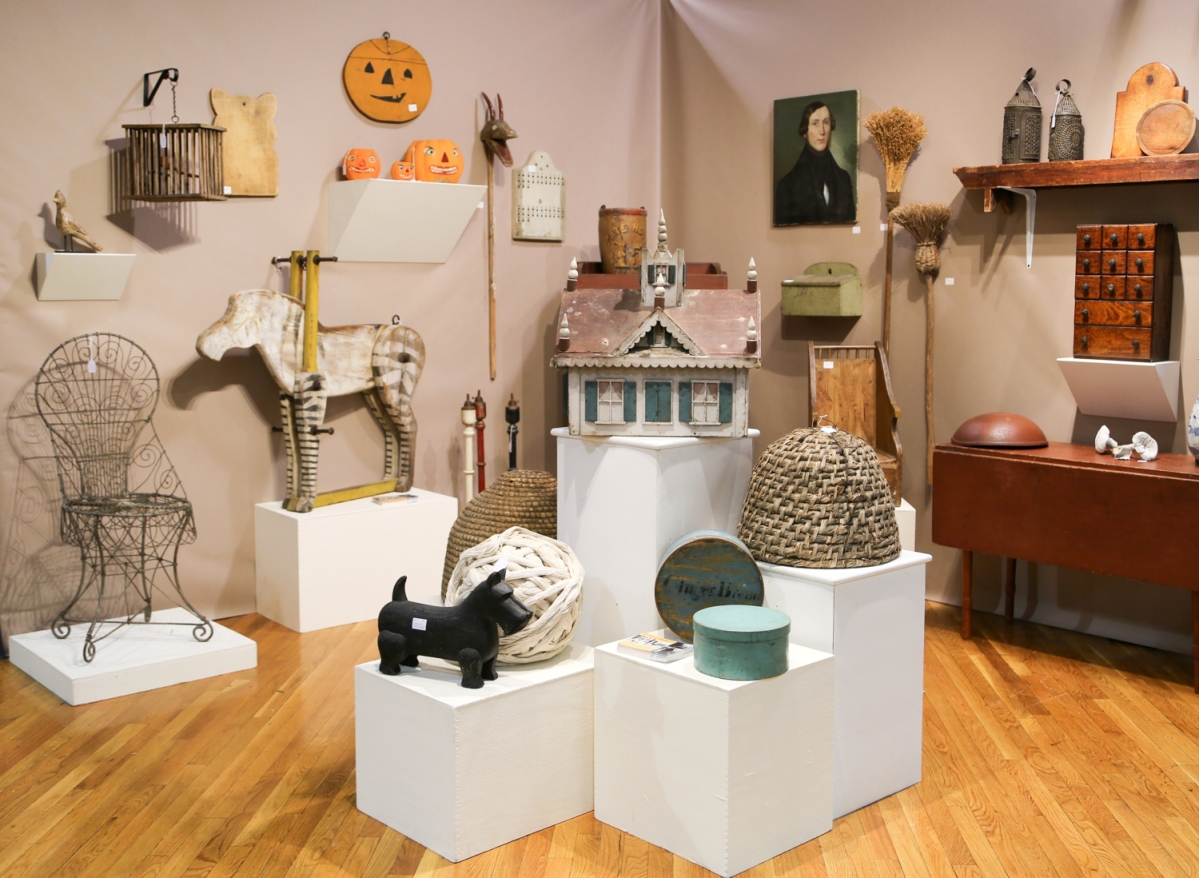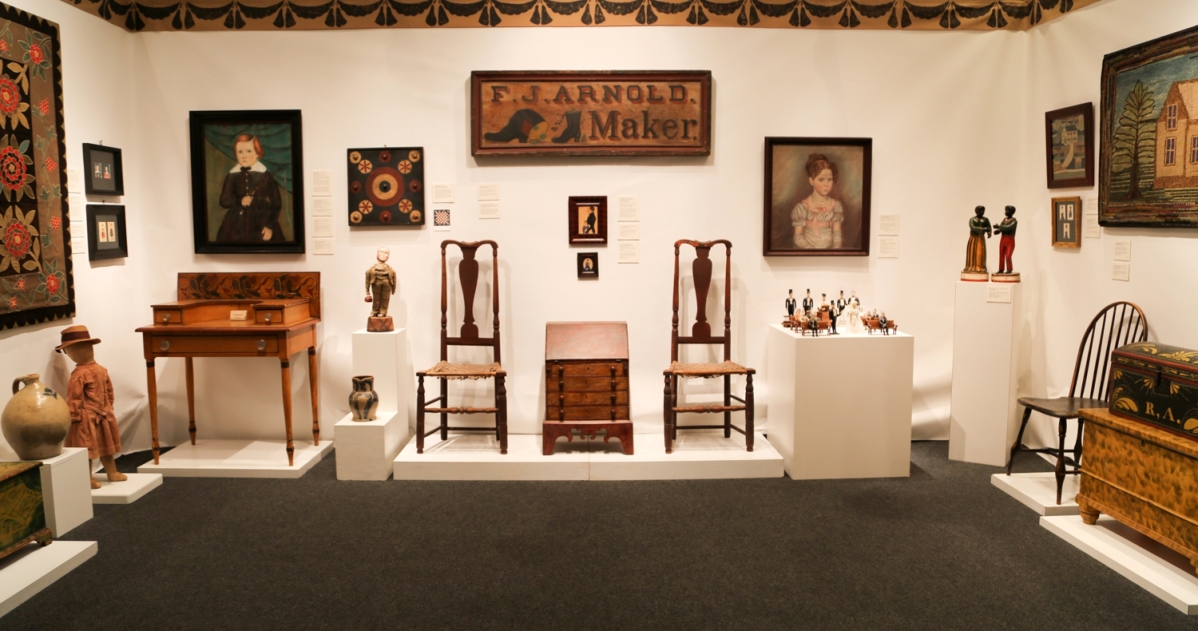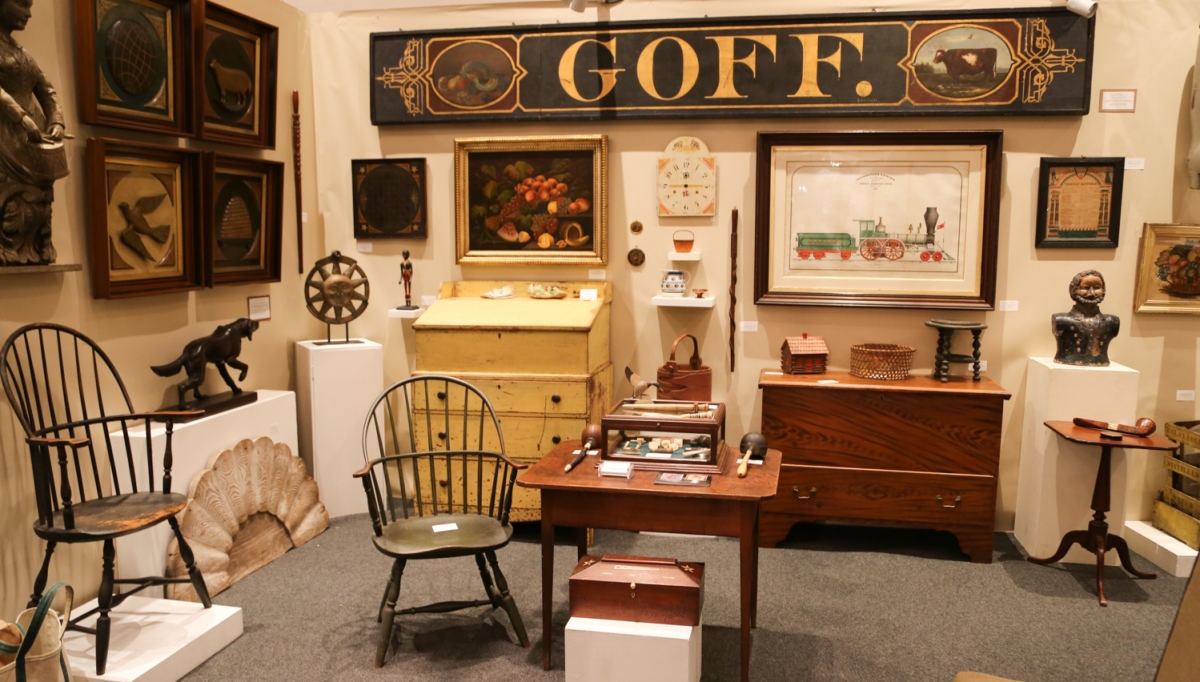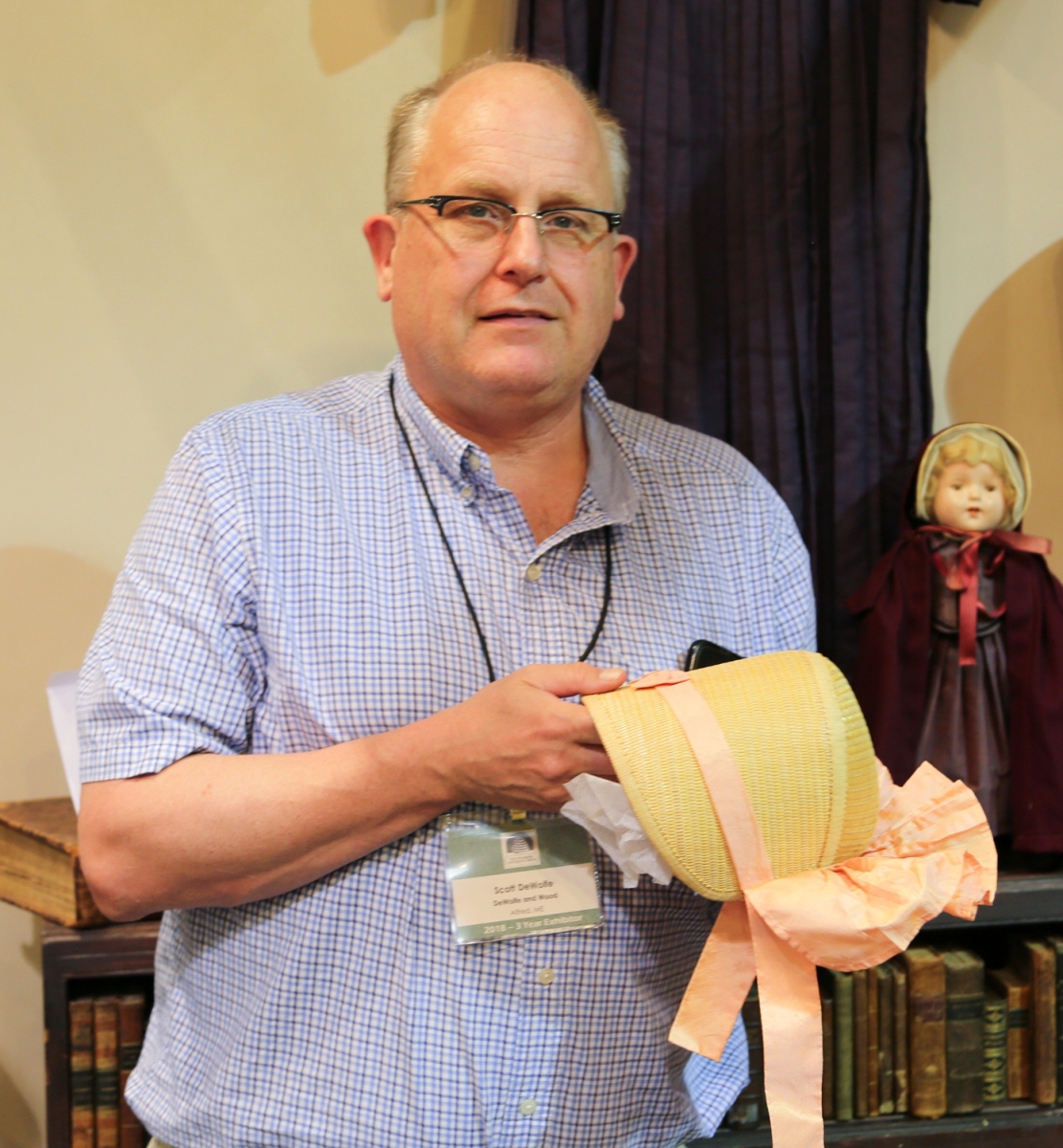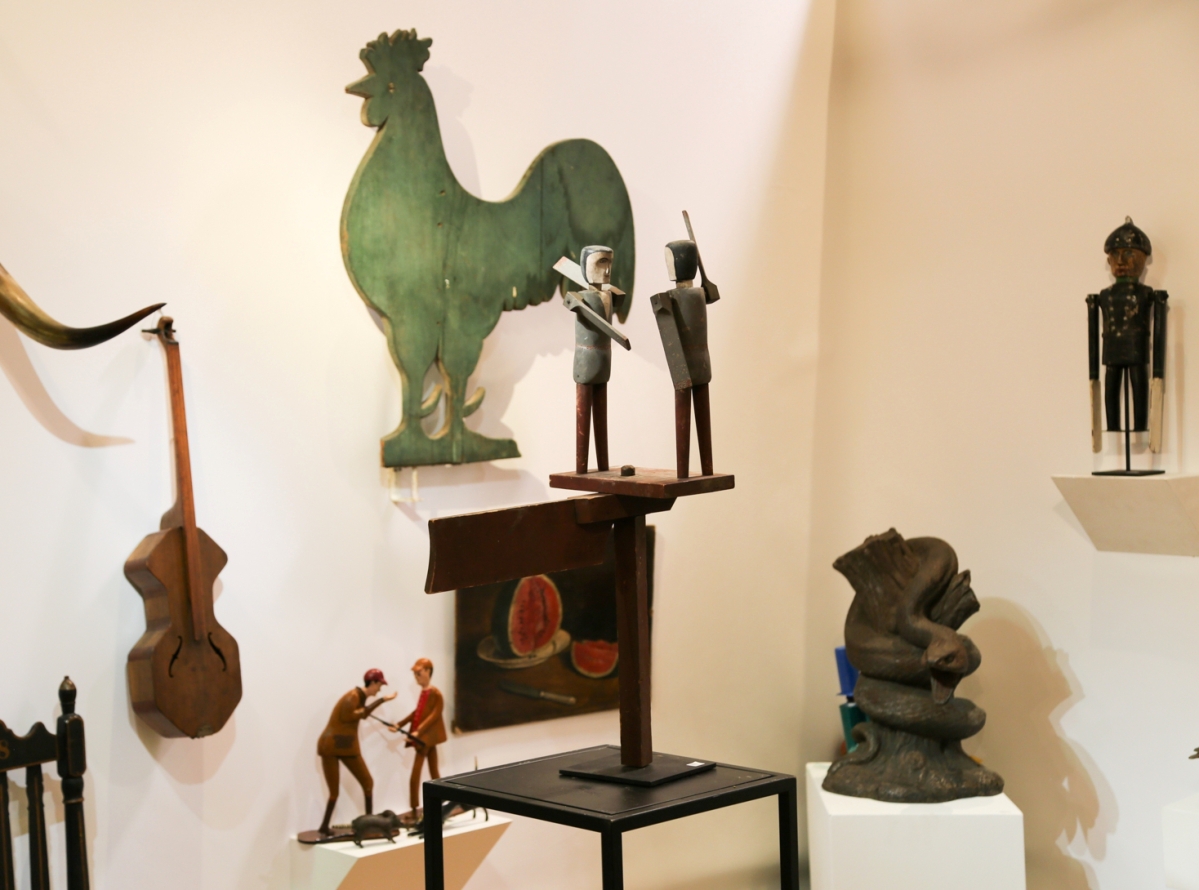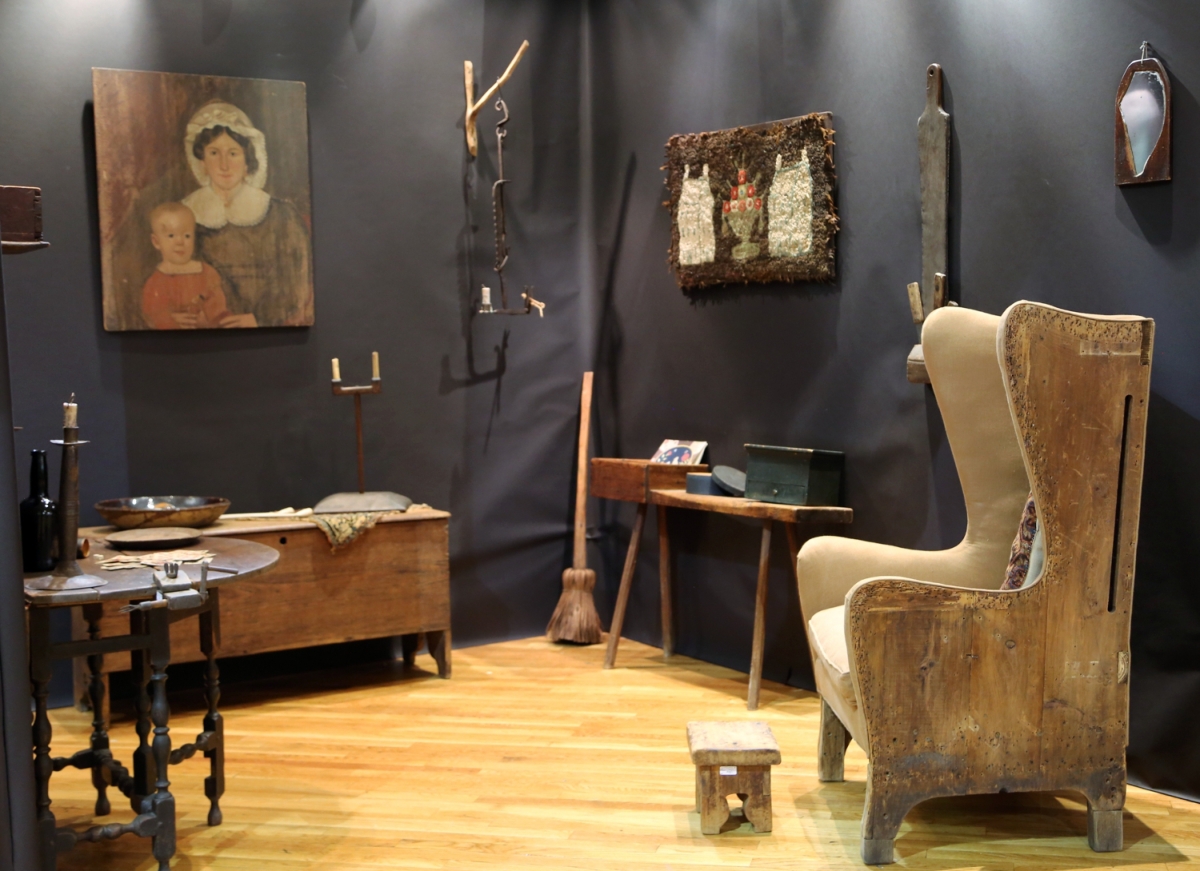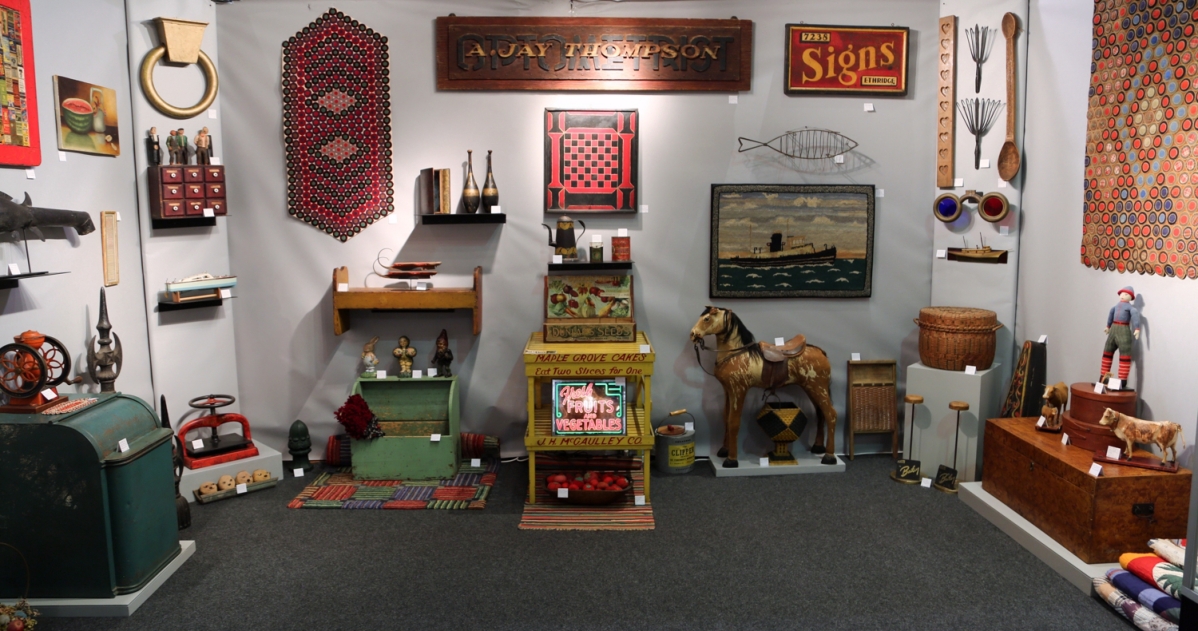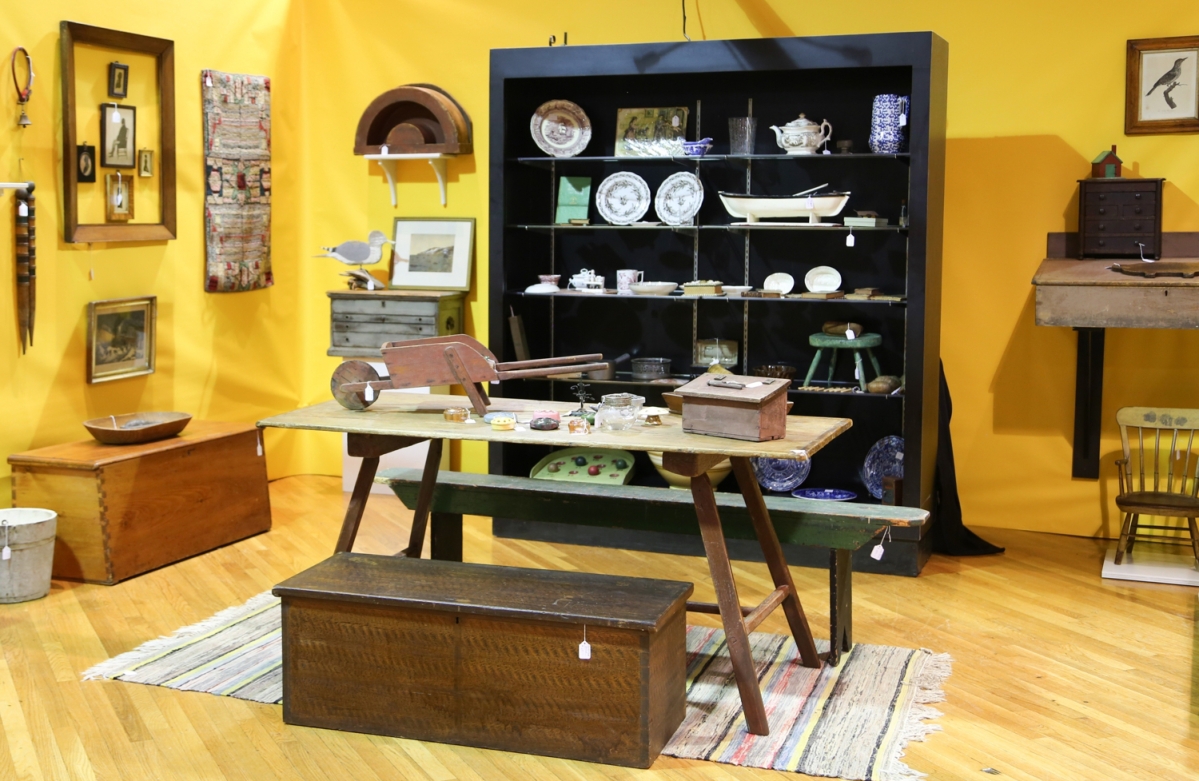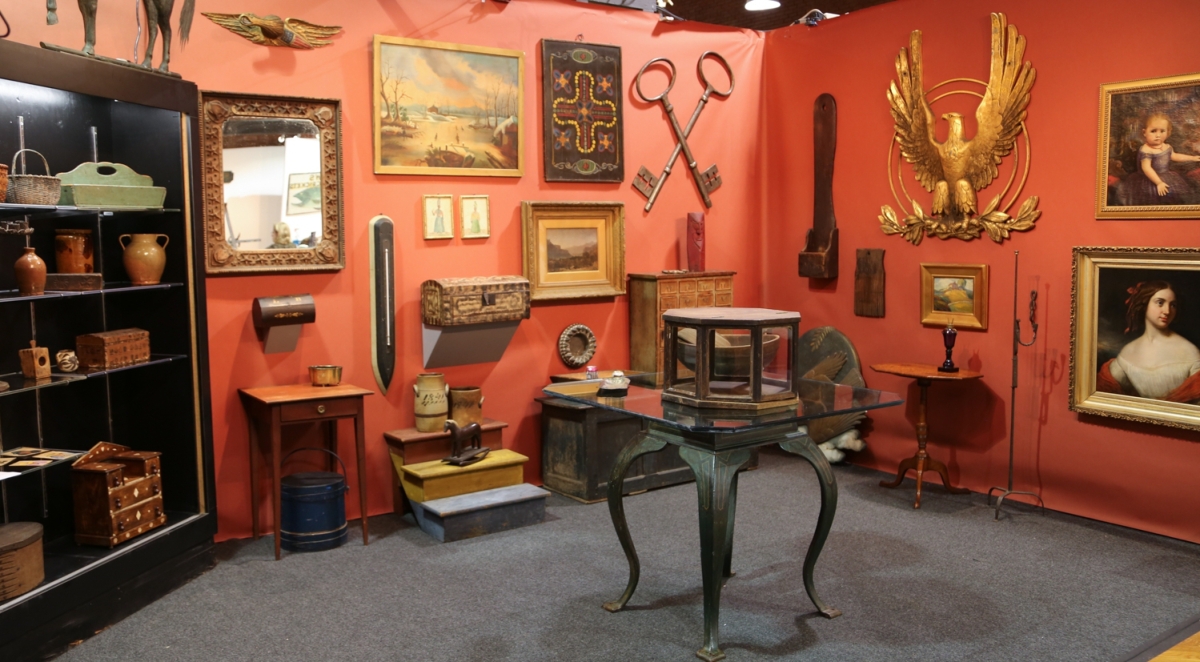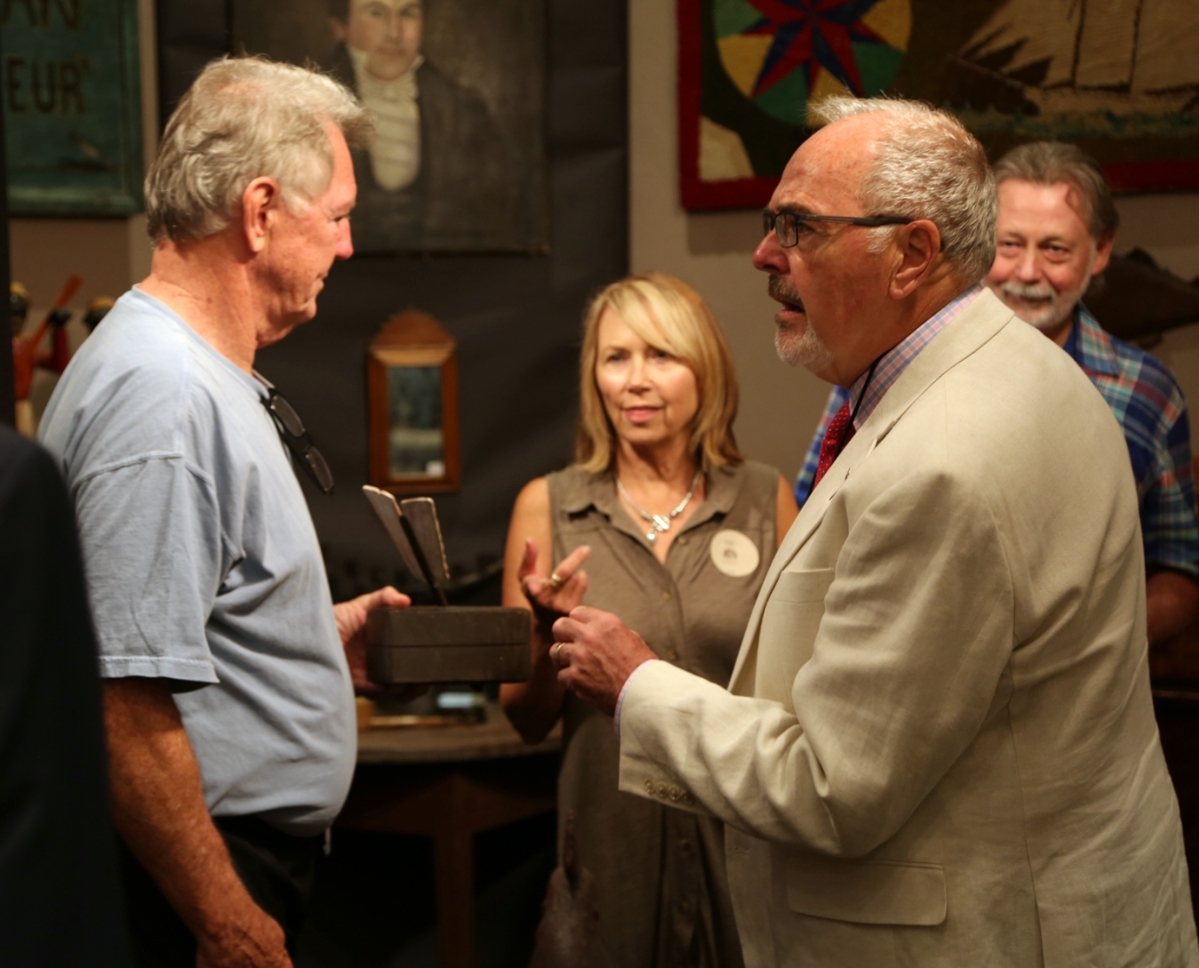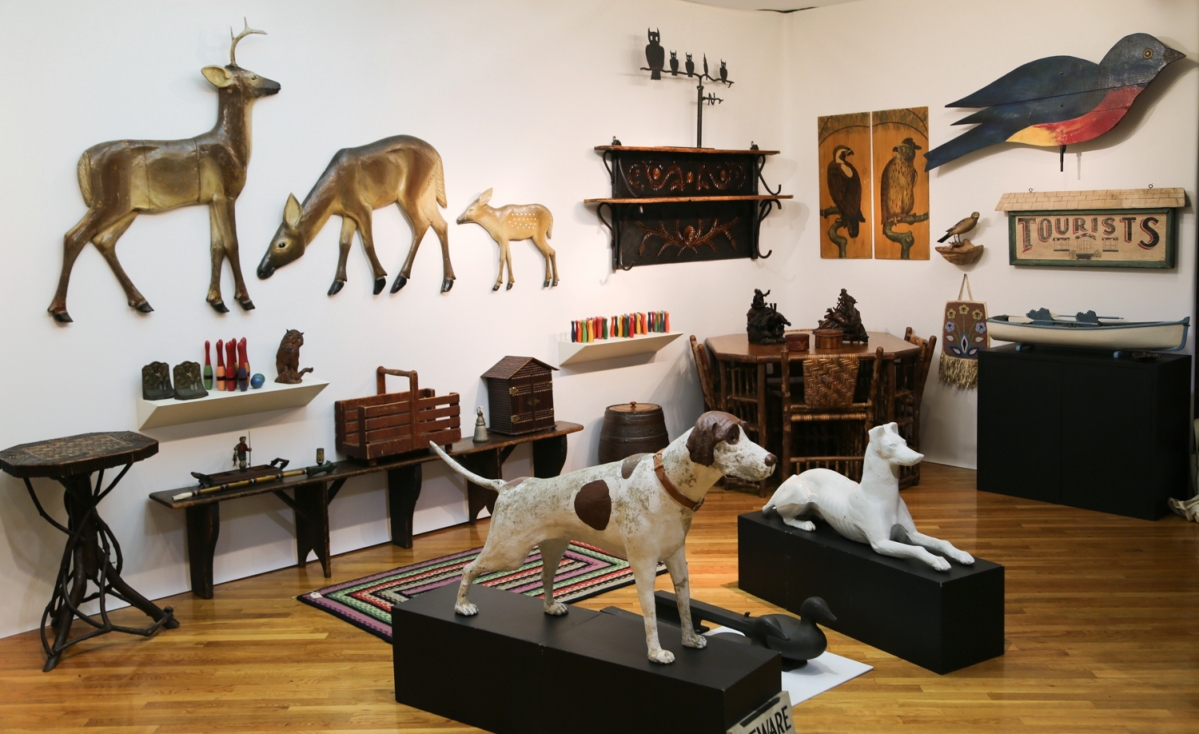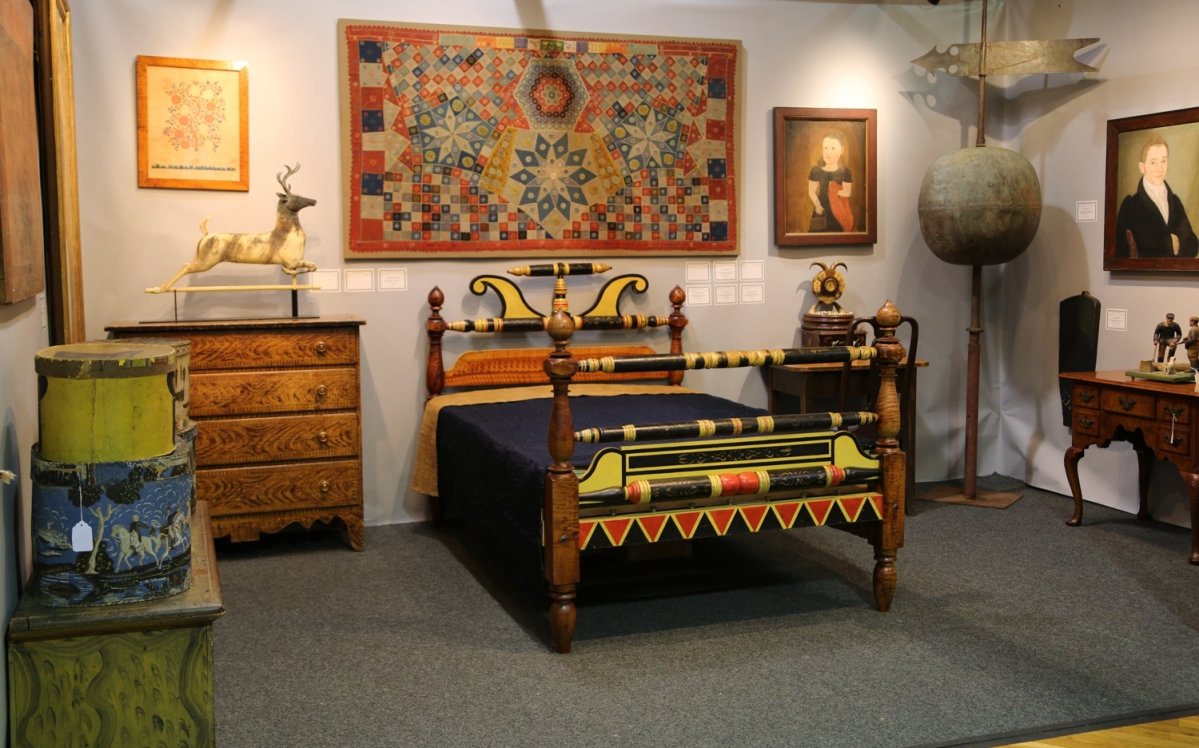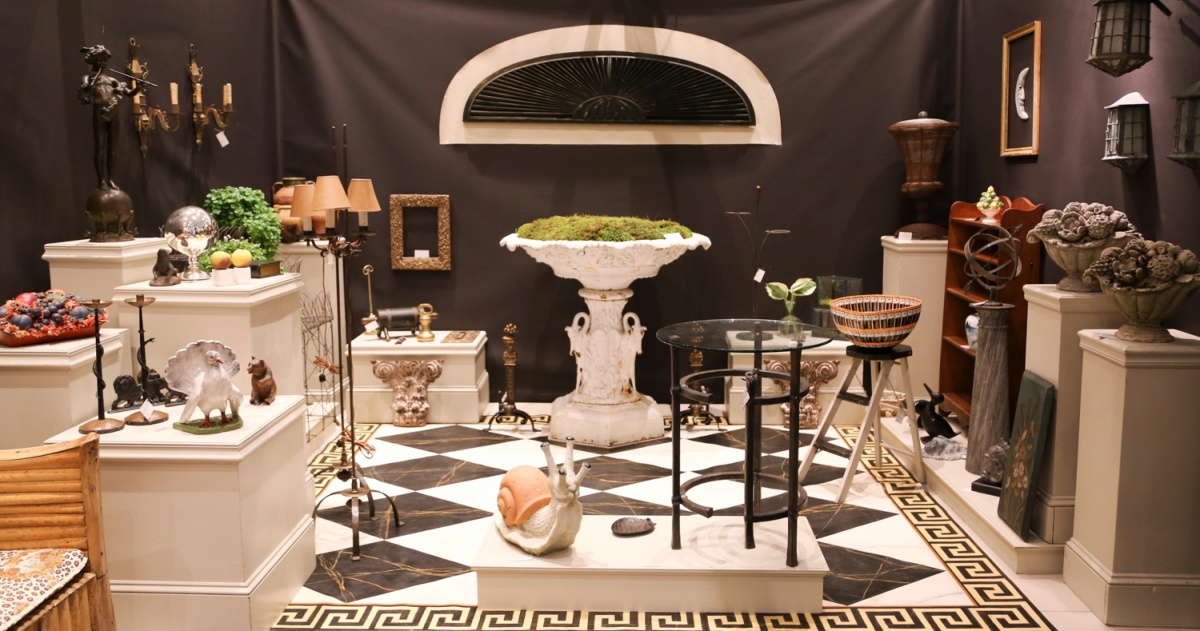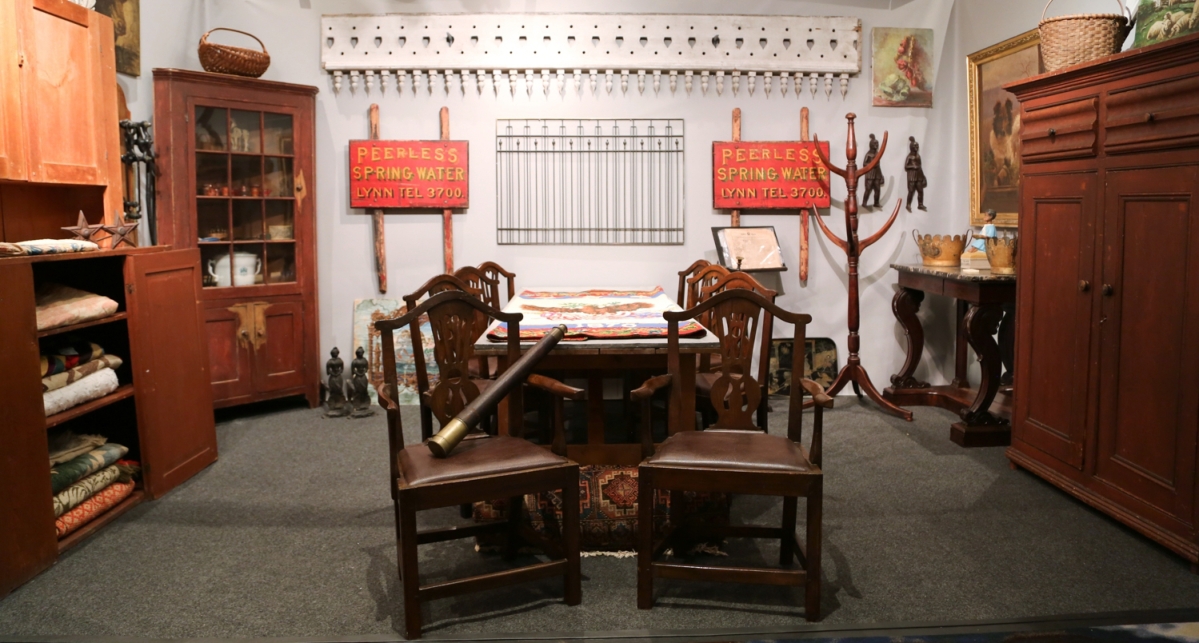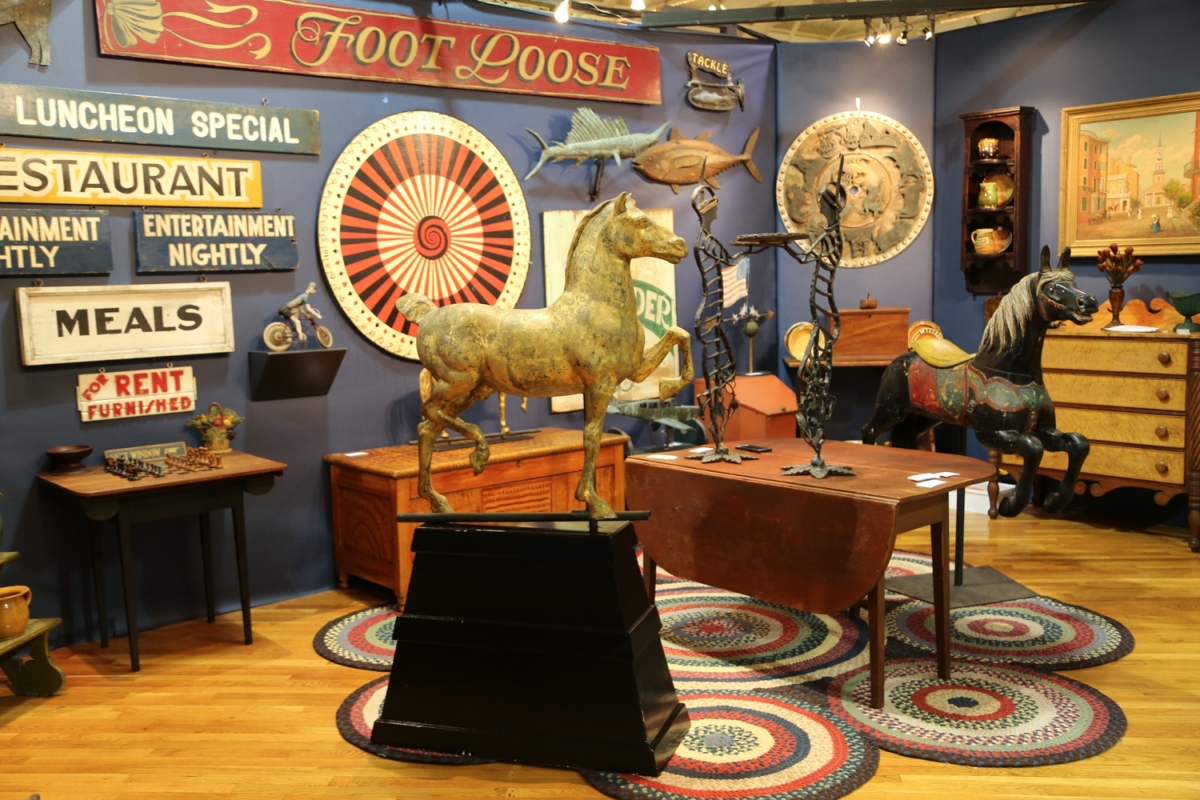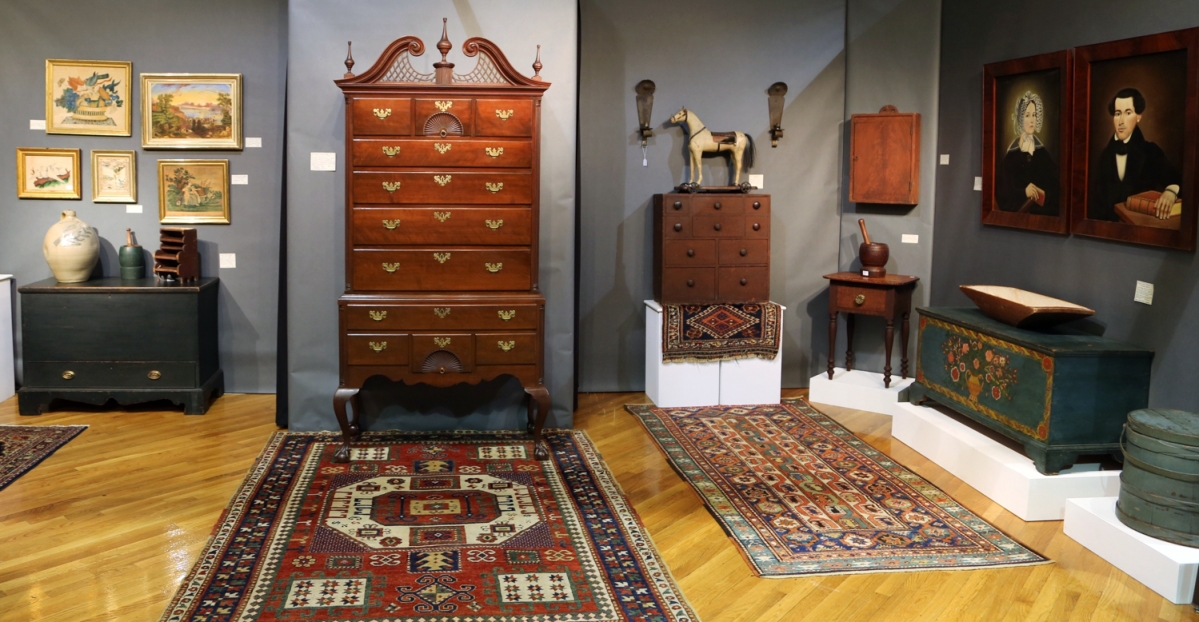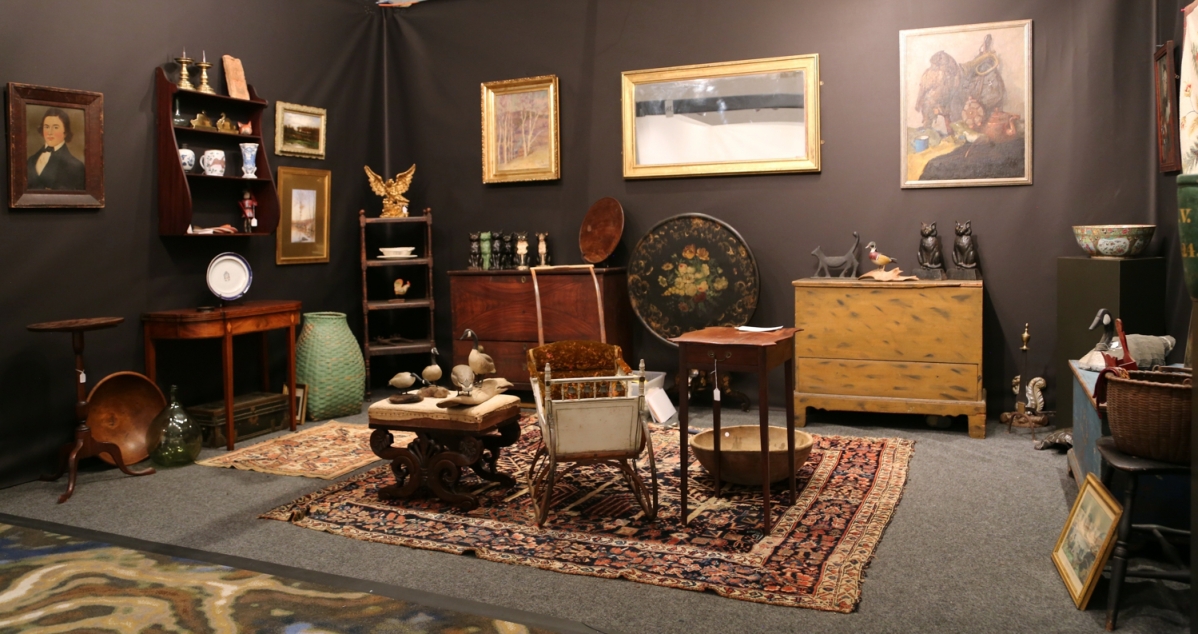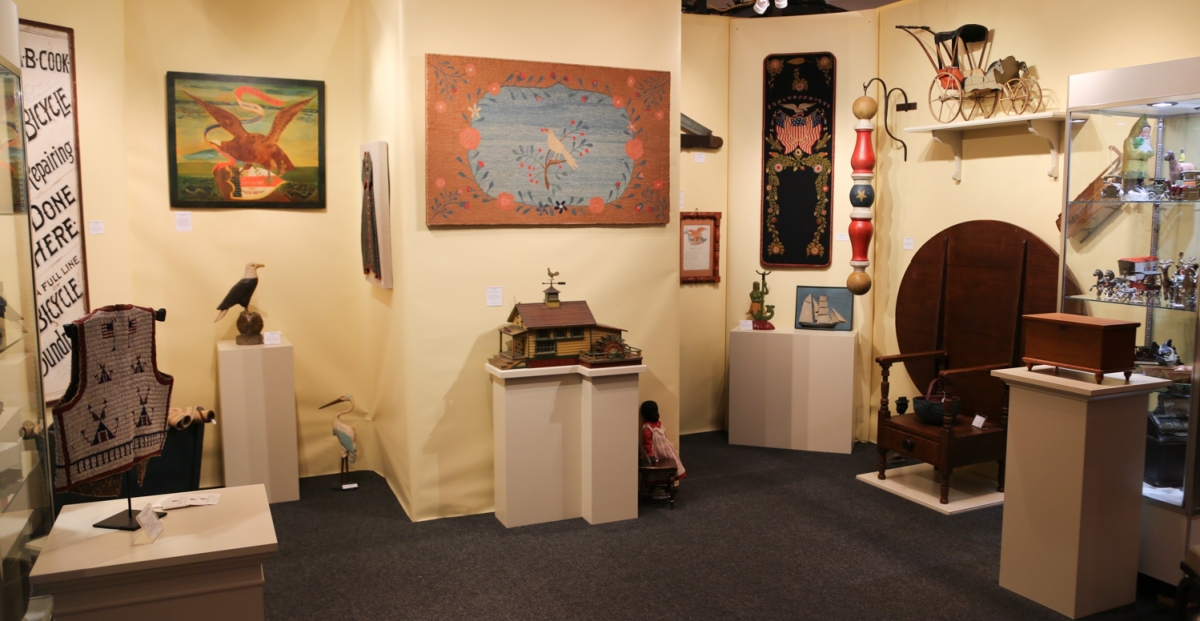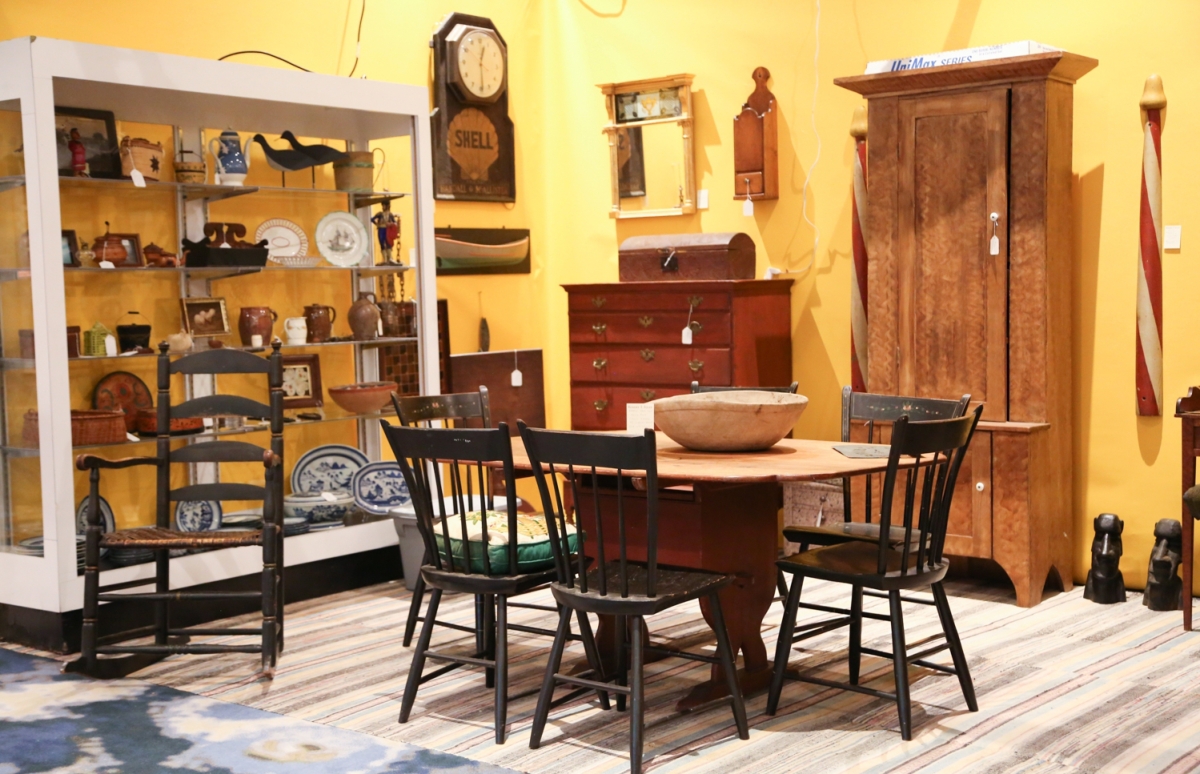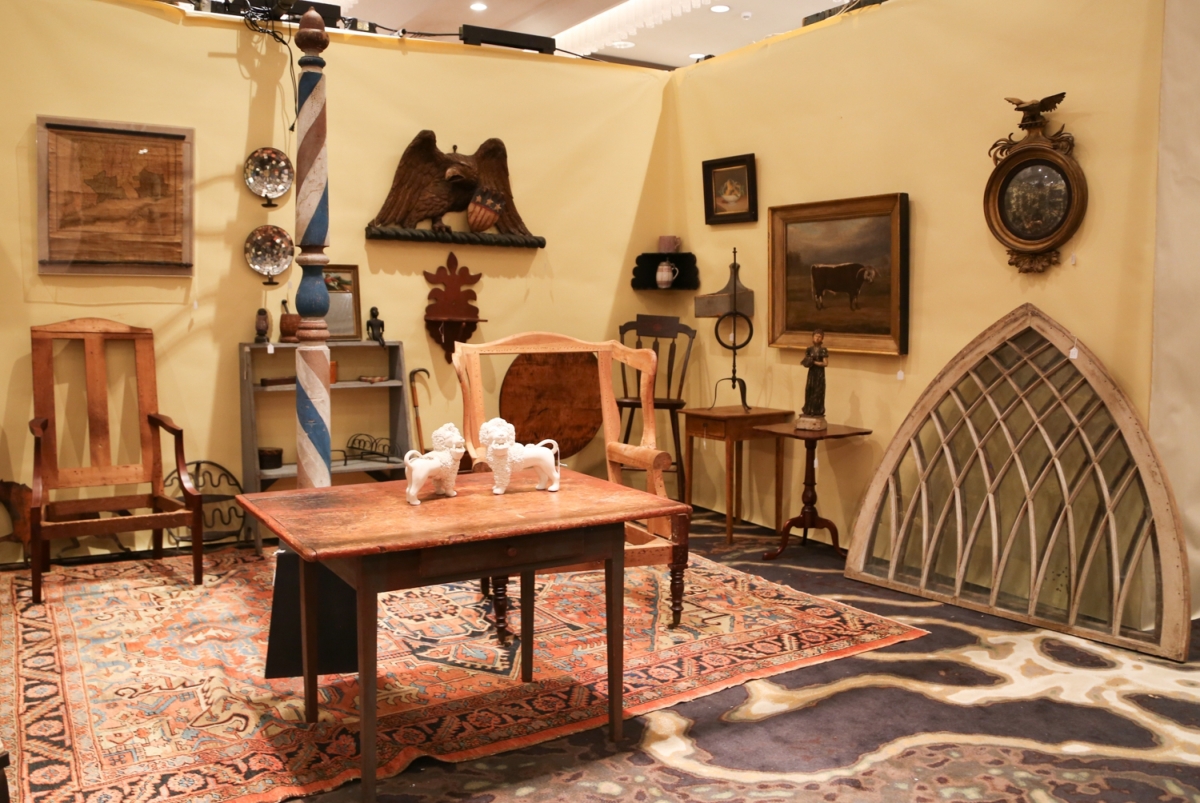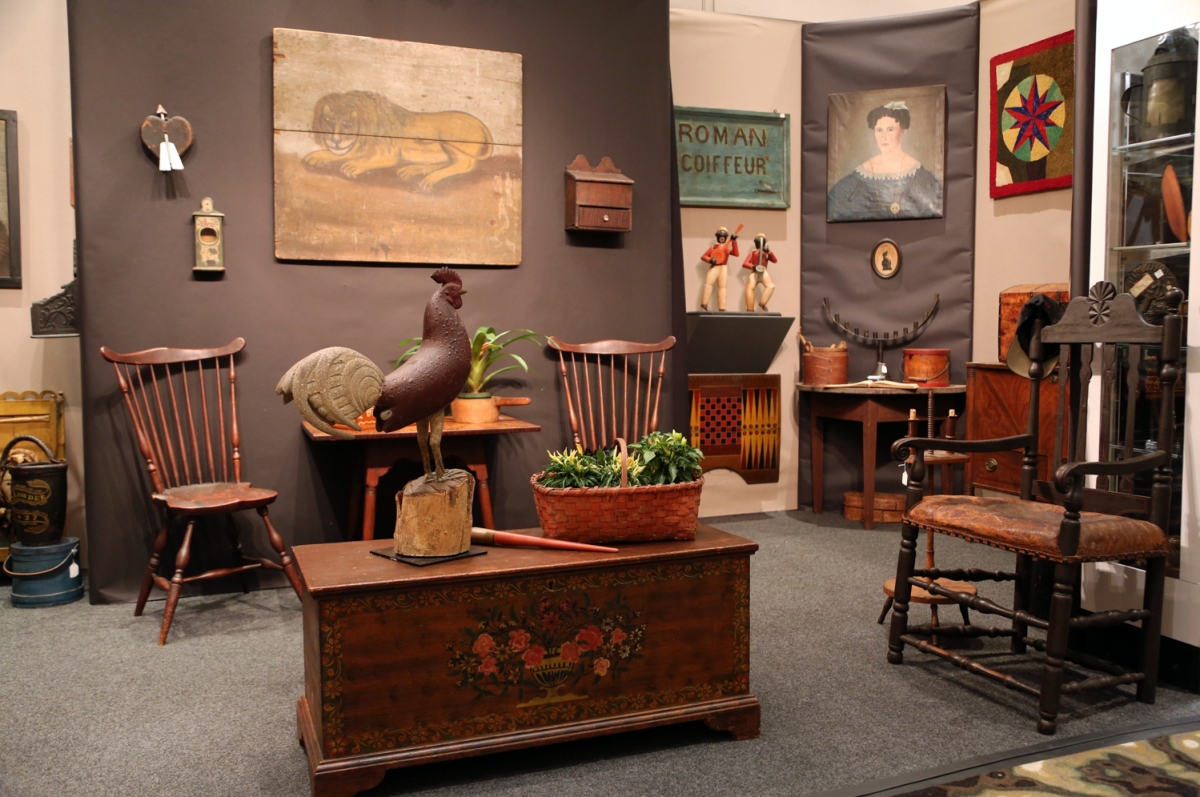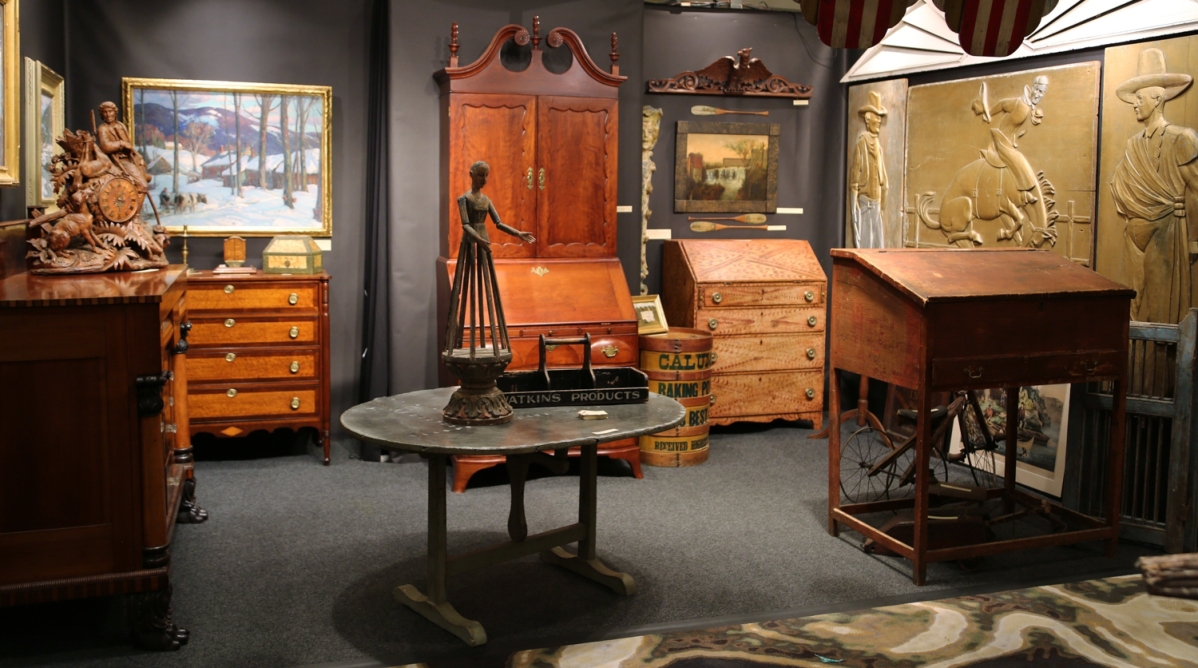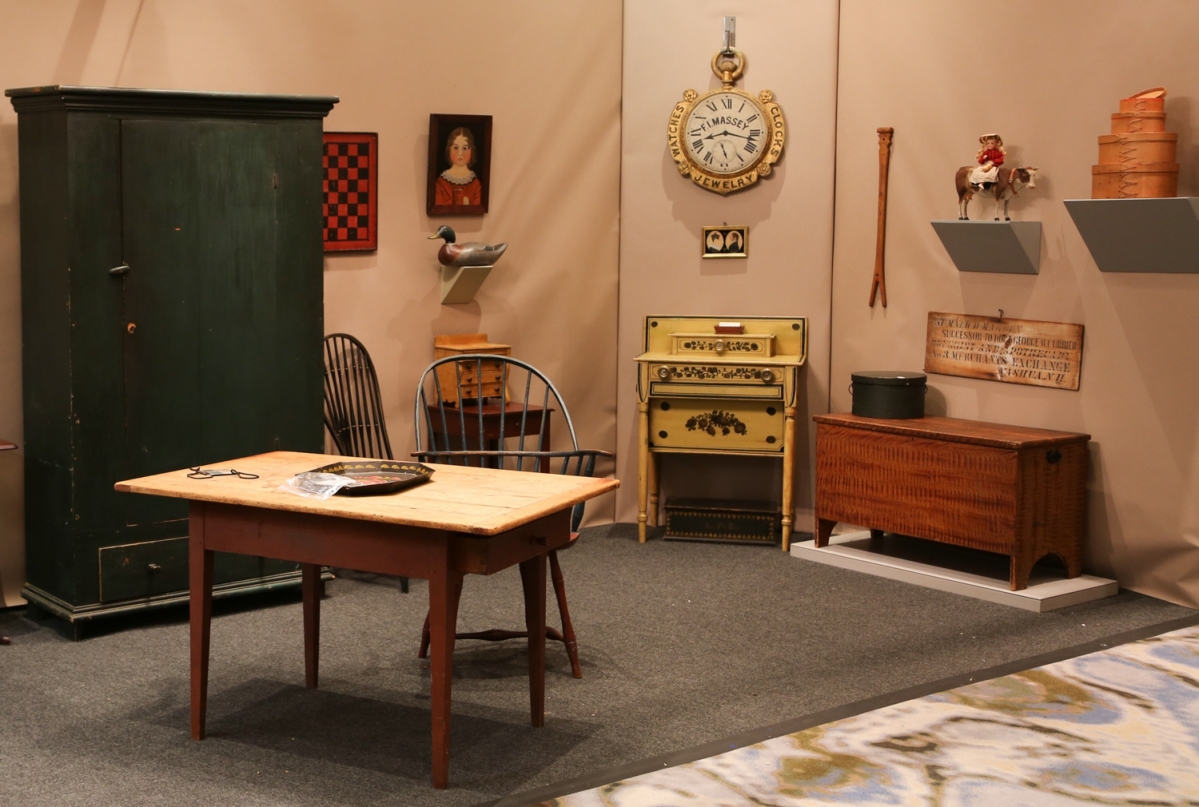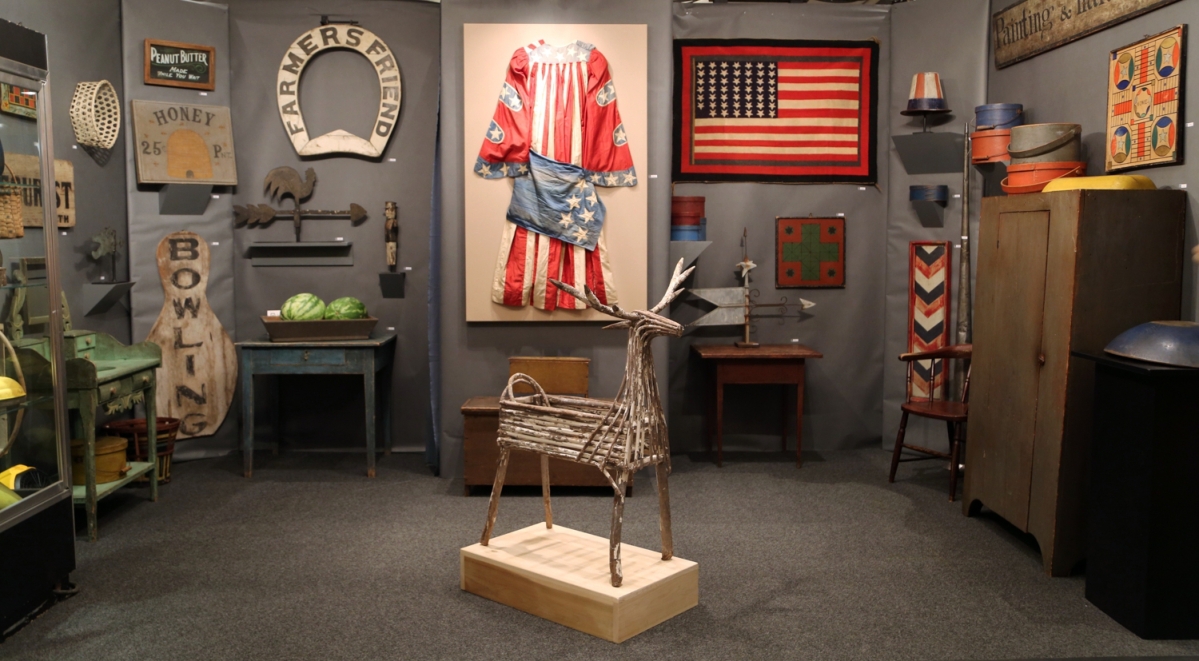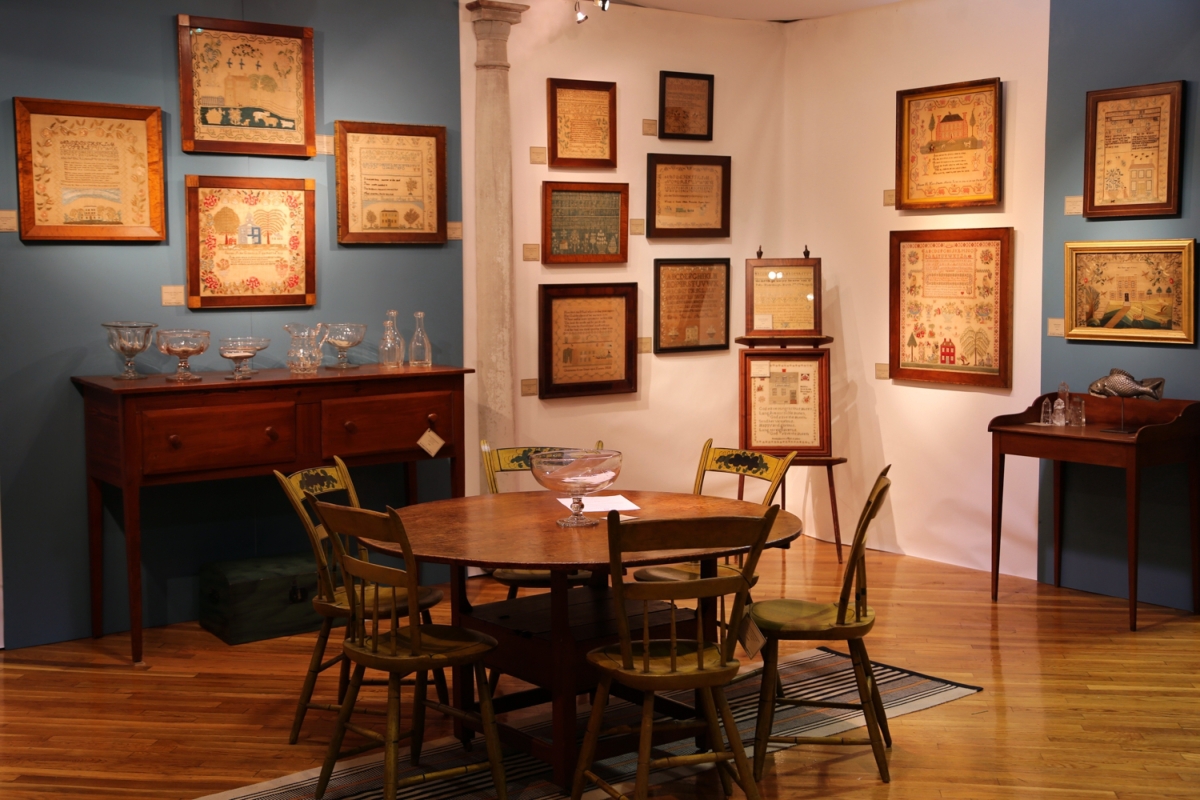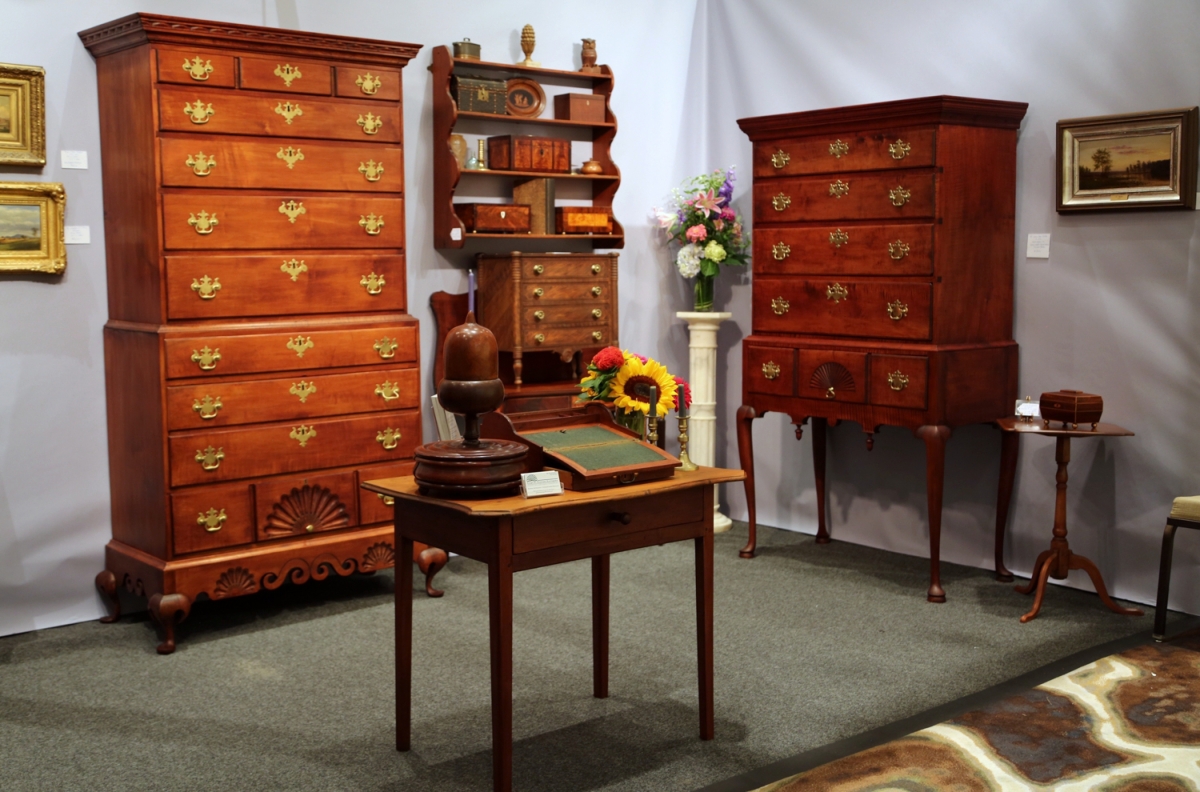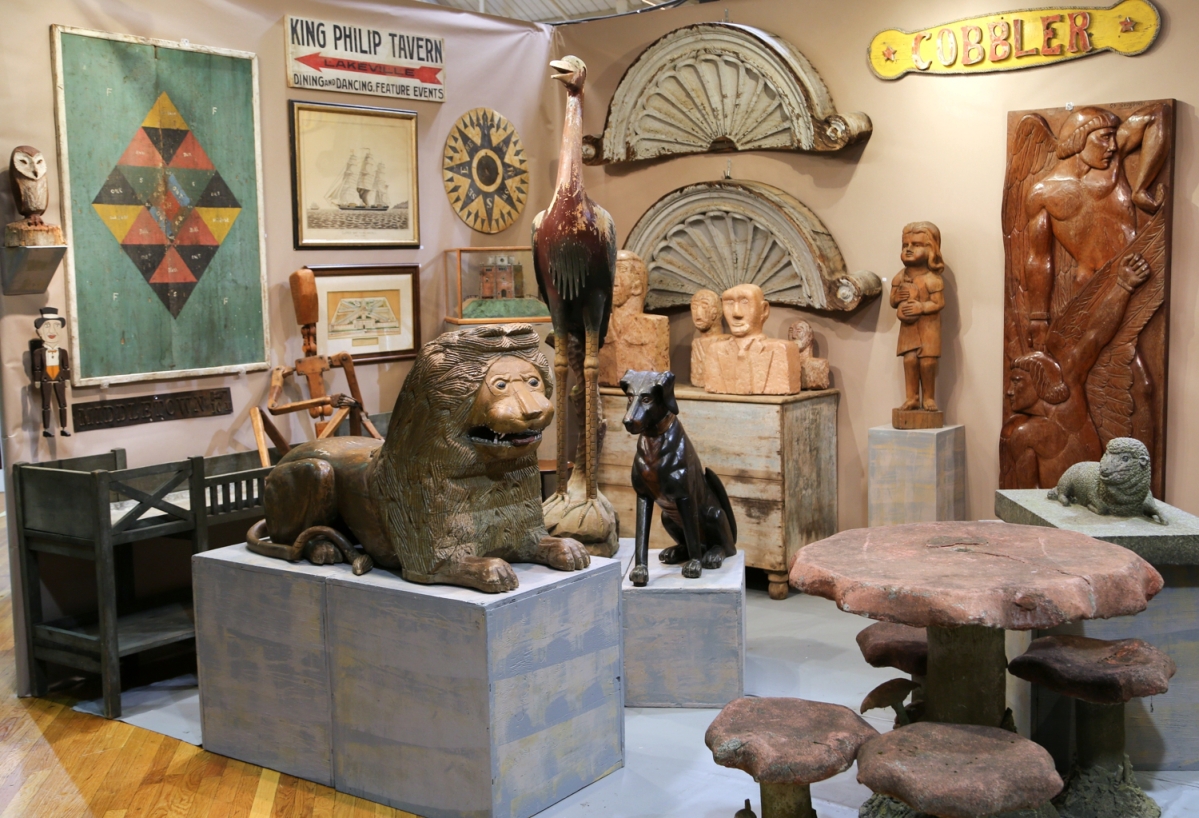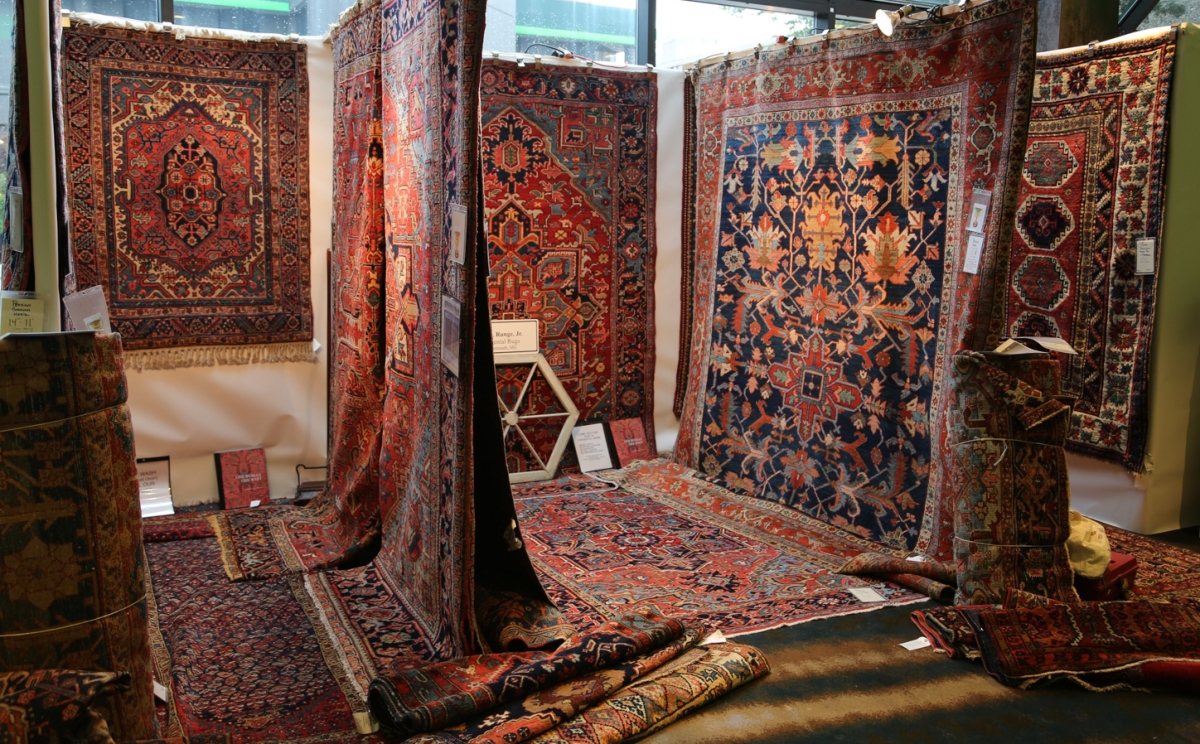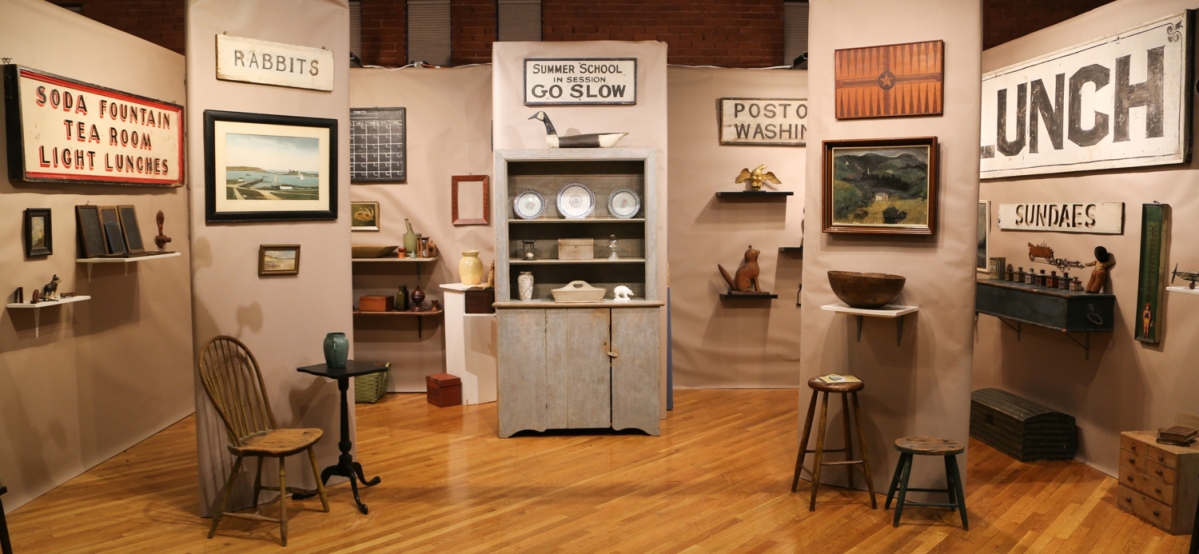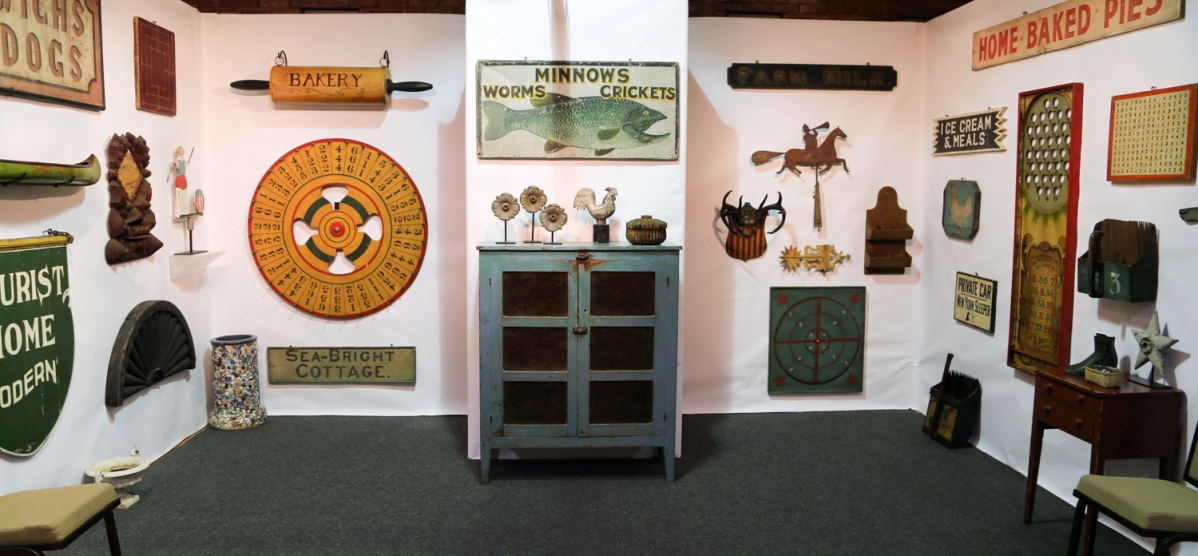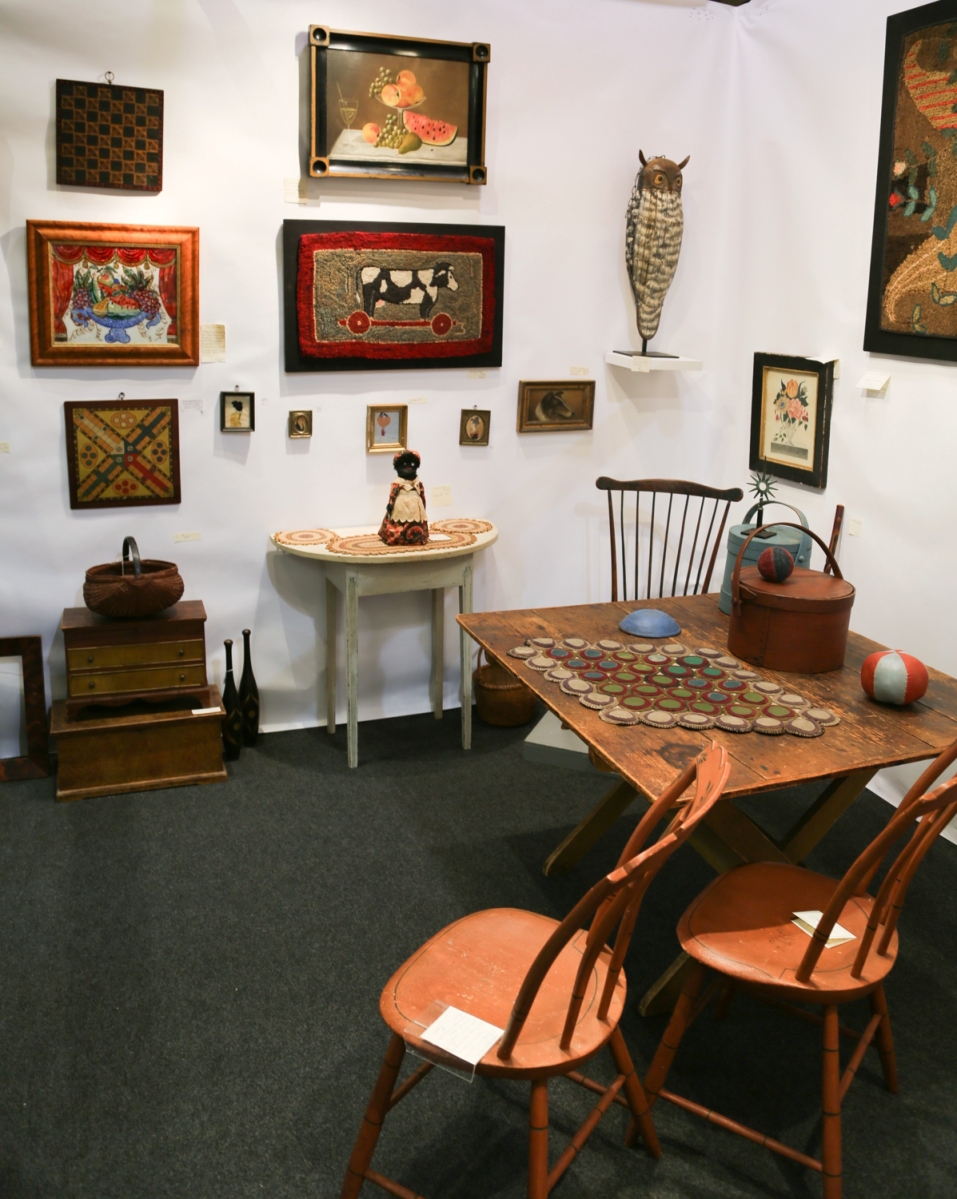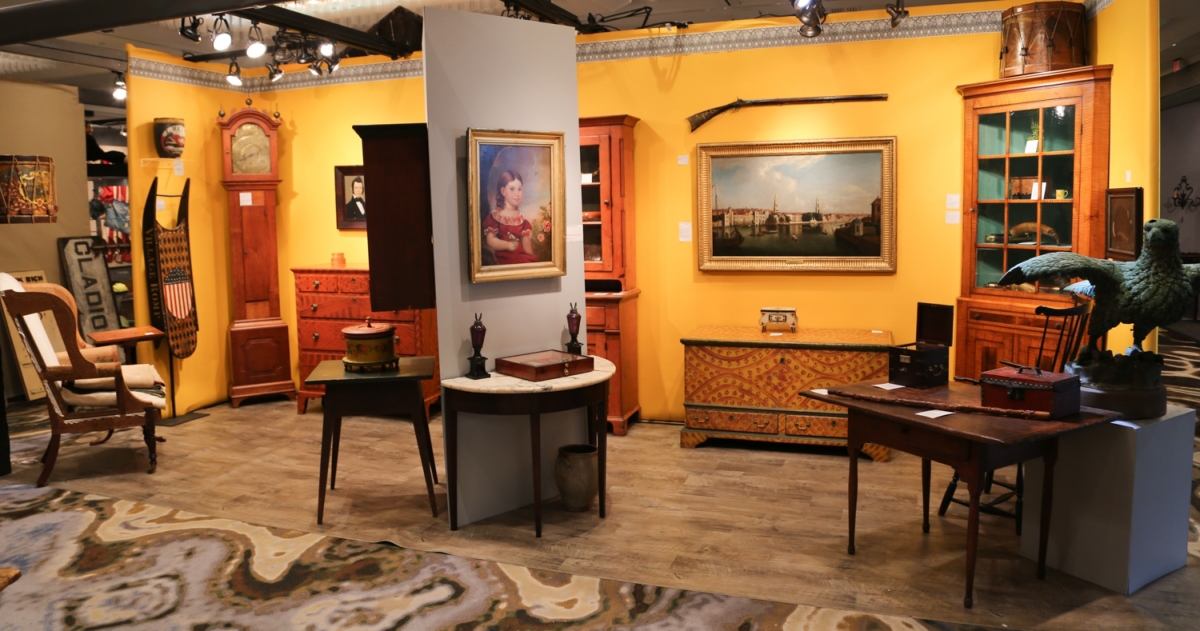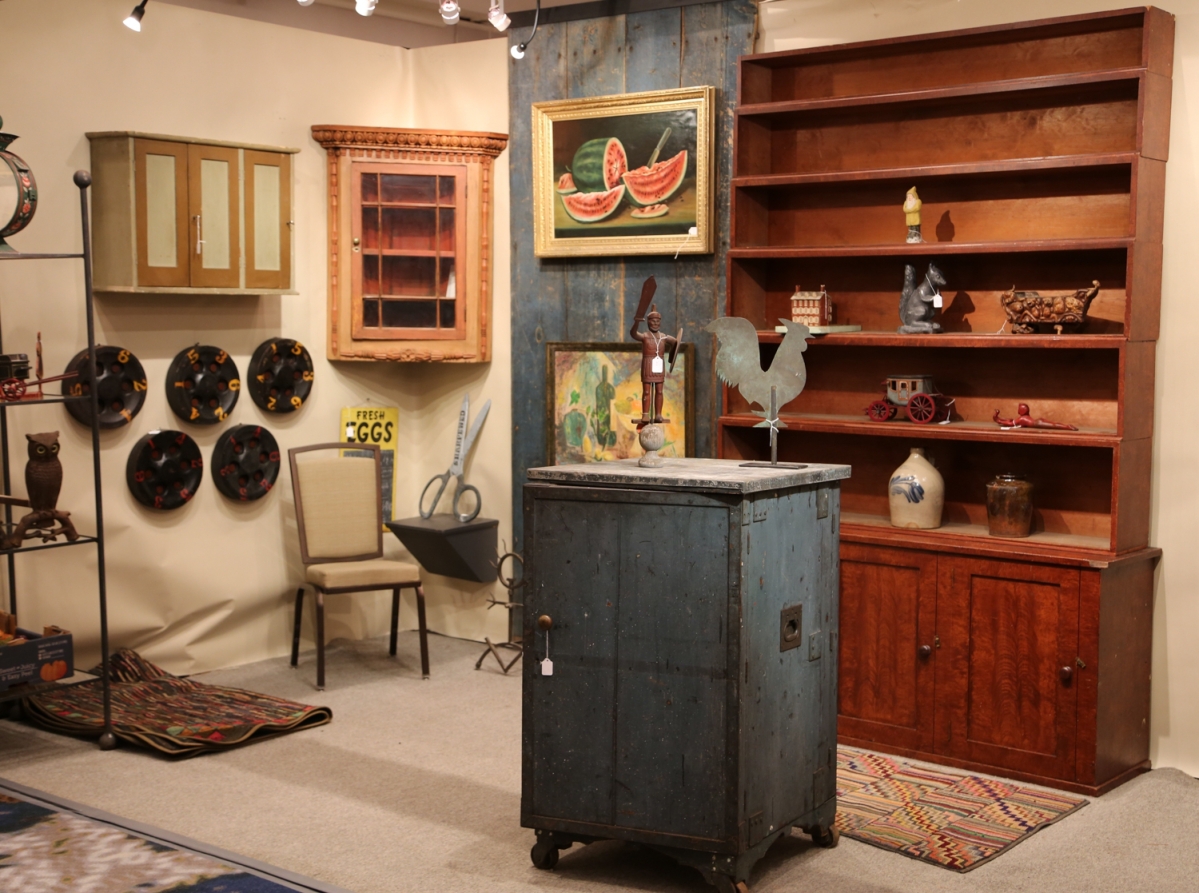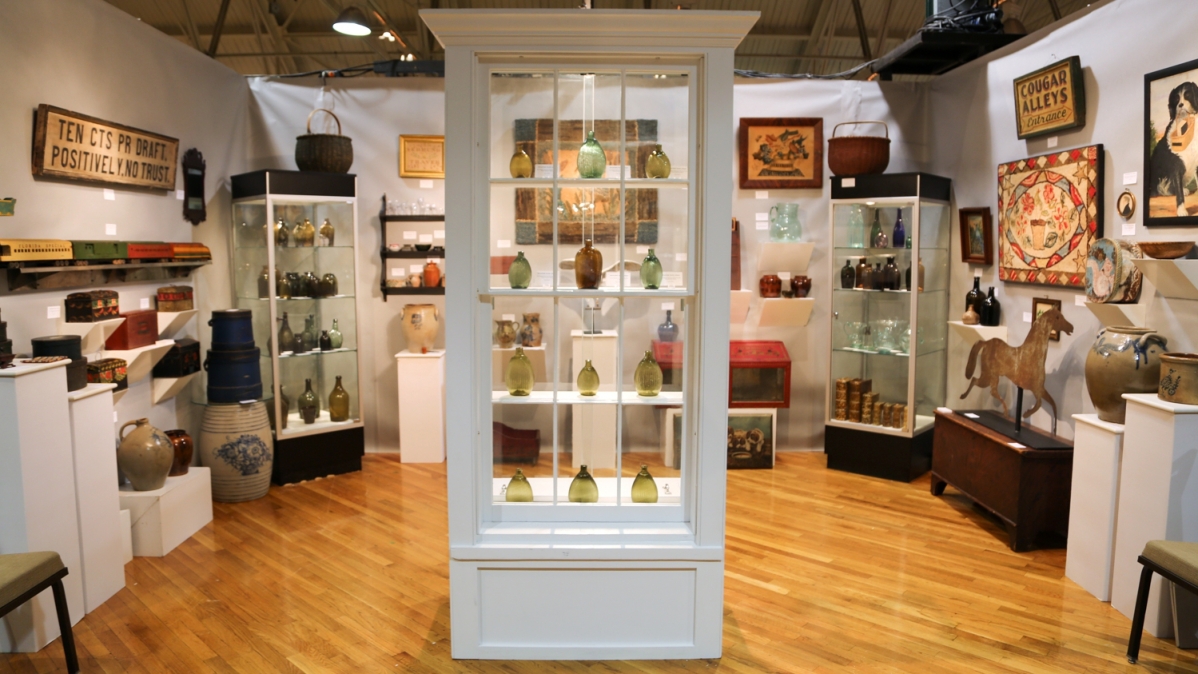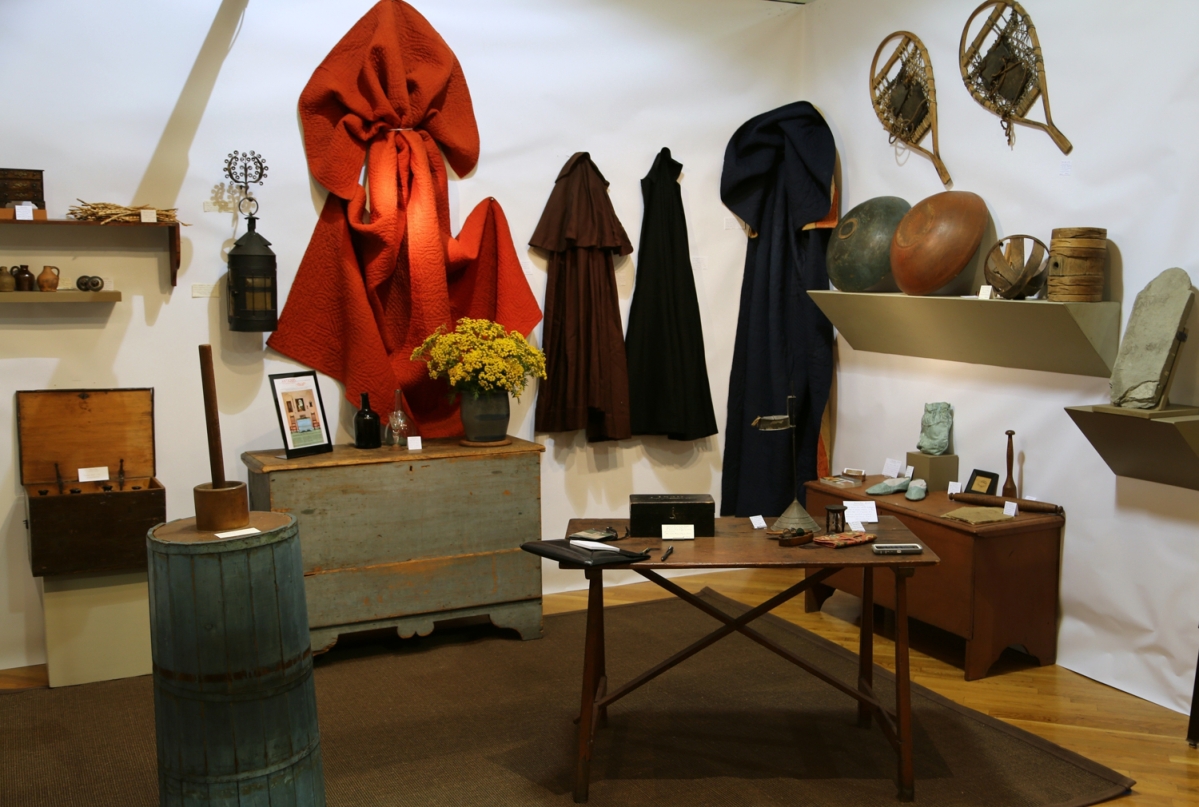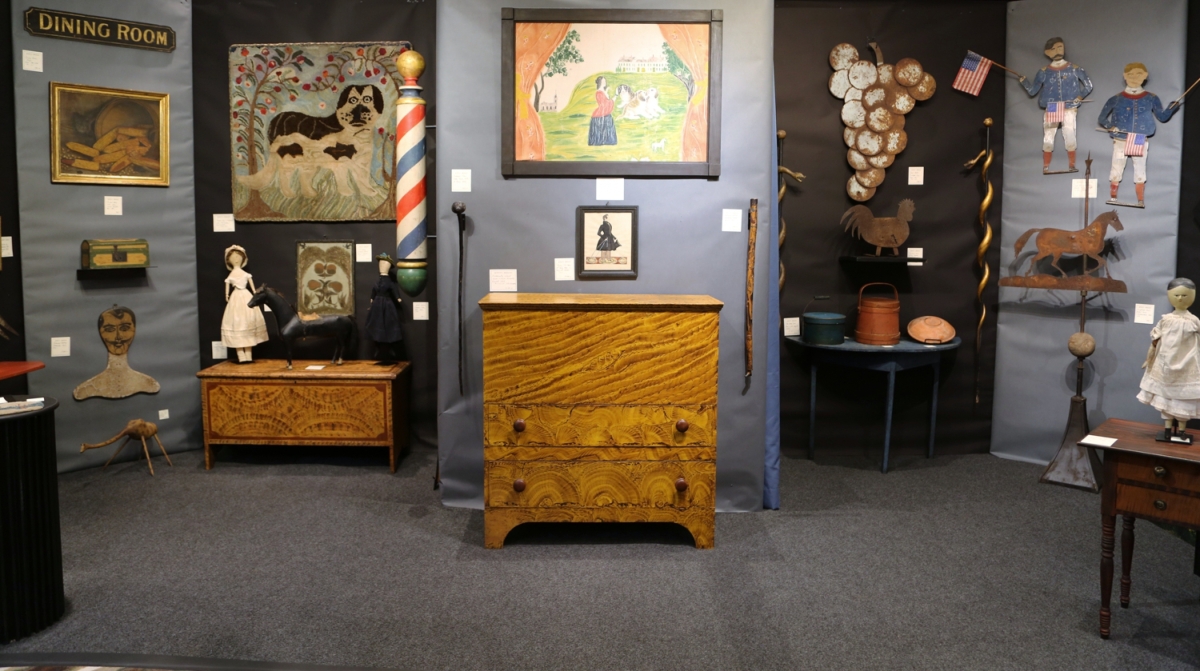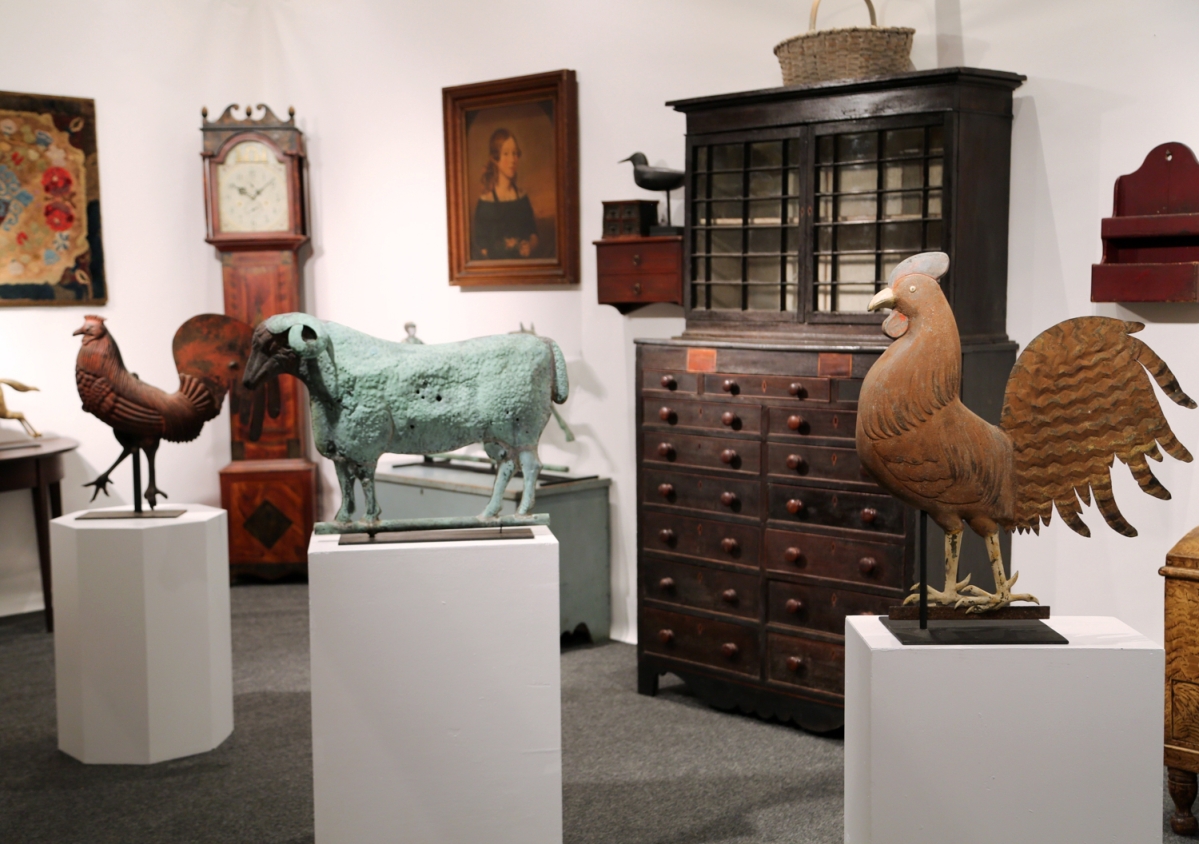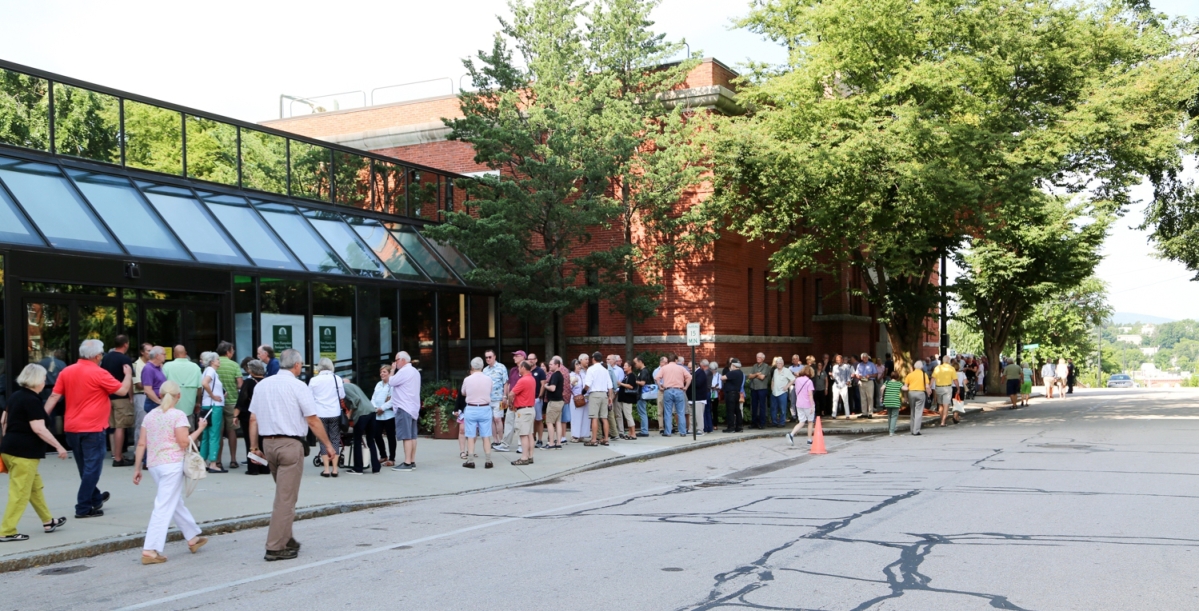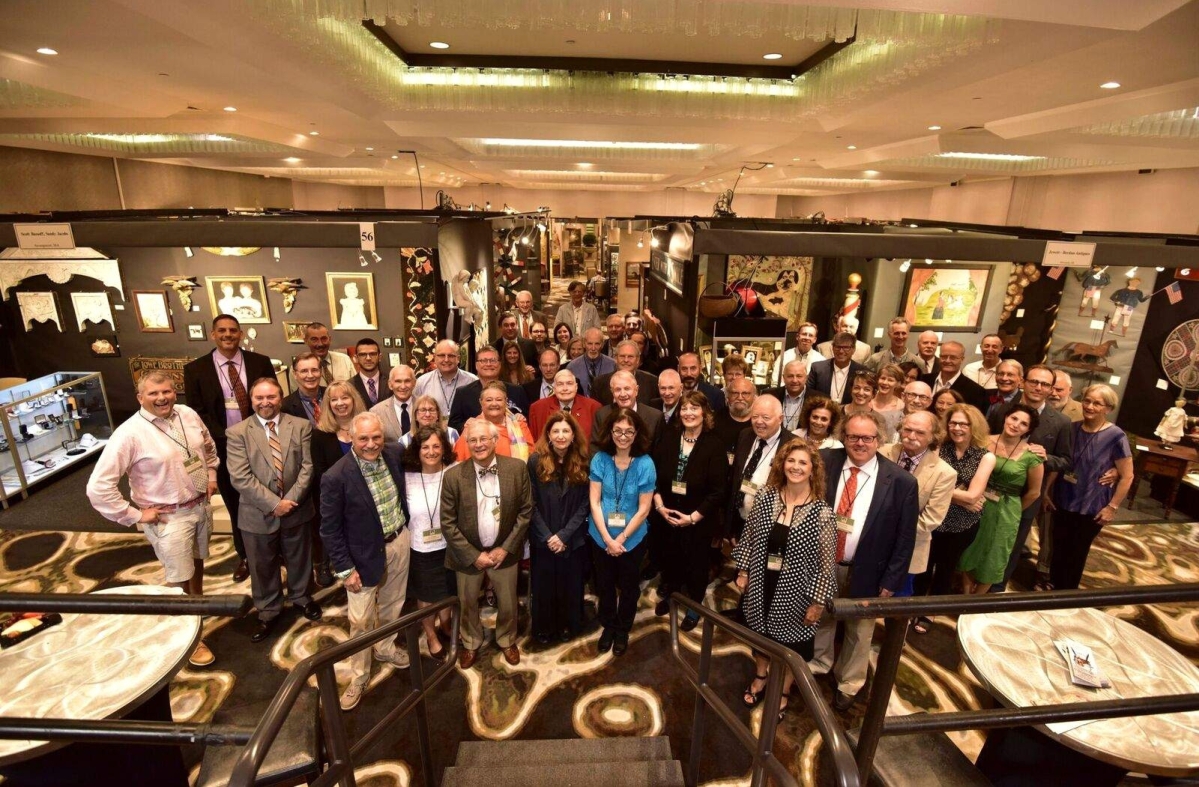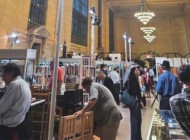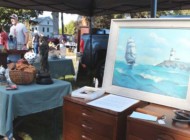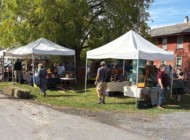Review by W.A. Demers, Photos by Greg Smith
MANCHESTER, N.H. – The Manchester Downtown Hotel is currently in the throes of a renovation and rebranding that will transform it into a Hilton Honors Hotel in October. For the crowds of shoppers that began lining up as early as 4 am for the 61st edition of the venerable New Hampshire Antiques Dealers Association (NHADA) Antiques Show, August 9-11, that meant doing so in an unair-conditioned lobby and forgoing breakfast from the former restaurant that had been located near the hotel lobby entrance. Inside the show, however, everything was peachy – cool, attractively lit and enlivened by the handsome exhibits of 68 antiques, fine art and folk art dealers. And at 10 am on August 9, the hordes of eager shoppers, who had snaked around the foyer of the ballroom and lined up at the street entrance, rushed inside to acquire the treasures on offer.
“There was a record gate at the show this year, opening day was up and both Friday and Saturday were up over last year, which was a record year,” said Tommy Thompson, NHADA’s president. “At the end of the show, Josh [Steenburgh], Bev [Weir-Longacre] and myself go around to thank the dealers and see if they have any comments. Everyone we spoke with had a great show and are already starting to save special items for next year.”
Sponsored, organized and operated by NHADA members, the three-day event is one among a septet of antiques shows that take place in the area during Antiques Week in New Hampshire. It culminates the week’s action, this year running August 5-11, so many consider it the “premier summer show.”
On the following pages, Antiques and The Arts Weekly provides just a small sampling of the vast array of freshly picked folk art, porcelain, country and formal furniture, paintings and prints, glassware, metalware, pottery and much more on offer by the show’s exhibitors.
One of the biggest battles of the War of 1812, the Battle of Lake Erie, sometimes called the Battle of Put-in-Bay, in September 1813 resulted in nine US Navy vessels defeating and capturing six vessels of the British Royal Navy and ensuring American control of Lake Erie for the rest of the war. That scene of Perry’s victory is depicted in the original glass panel of a gilt Sheraton mirror shown by Peter Sawyer, Exeter, N.H. Also on offer here was a lolling chair from Massachusetts or New Hampshire that the dealer had purchased from a family in Milford, N.H., with great form and proportion and in excellent condition, as well as a rare cherry dwarf clock from Massachusetts, late Eighteenth Century. Sawyer believes there are perhaps only six clocks like this one known, with an identical one illustrated in Nutting’s 1924 clock book and another in the collection of the Metropolitan Museum of Art. Retaining its original pierced fret, the eight-day clock strikes a bell on the hour.
This show has no shortage of folky hooked rugs, but none put all the elements of Americana together in one depiction as well as Newsom & Berdan’s early Twentieth Century example in which the folk artist created a scene of a house, an American flag, dogs and people. The Thomasville, Penn., dealers found the 48-by-26-inch rug in Pennsylvania. Also from Pennsylvania, Buck’s County, to be exact, was a bench table with mortised through the base and a two-board top. Of pine, the circa 1840 piece measured 66 by 38 by 28 inches. A diminutive pie safe on offer featured old paint, dovetailed gallery and exuberantly punched tins. The dealers found the Nineteenth Century piece in Frederick, Md., and it measured 33 by 43 by 20½ inches.
This was the first time out for the Village Braider’s Bruce Emond at this show, the dealer’s outside-the-box sensibilities seen by the show’s organizers as a desirable addition to the more traditional displays lining the aisles. Sure enough, Emond did not disappoint, showcasing an English turn-of-the-century sculpture of a lion that, while crafted across the pond, looked every bit like the “Peaceable Kingdom” beast made iconic by American folk painter Edward Hicks (1780-1849) with some Sendakian qualities thrown in. French sculptor Louis Féron (1901-1998) was represented by a tall bas-relief sculpture of two mythical figures crafted from a single panel of wood. Ferone immigrated to Costa Rica during the Great Depression, living and working there from 1934 to 1945, where he ran his own workshop. He left Costa Rica for New York City in 1945, and he became an American citizen in 1951. The New Hampshire connection came when he married the dancer Leslie Snow in 1962 and established a workshop in Snowville, N.H. Also out of New Hampshire was a series of 69 various 4-by-5-inch watercolor maps that had been hand painted by Helena Fairbanks in the 1830s-40s. The maps were varied, ranging from the North American continent to various areas of the world. Consignor-supplied information states that Helena was the child of Mary (Whittlemore) Willard who later remarried to Captain Joseph Fairbanks (1722-1802).
At Brock & Company, Concord, Mass., fine art was abundant, with a handsomely framed in ebonized oak “Study of a Head,” by Laura Coombs Hills (1859-1952) pastel on board, 28 by 21½ inches. William Keith’s (1838-1911) “Mount Tamalpais, Marin County, Calif.,” circa 1880, an oil on board, 23 by 27 inches, was displayed in a period Nineteenth Century “Orientalist” frame. Displayed in a Milch-type frame was an impressionistic scene of “Venice” by Jane Peterson (1876-1965), an oil on canvas measuring 6½ by 9-3/8 inches, signed lower left.
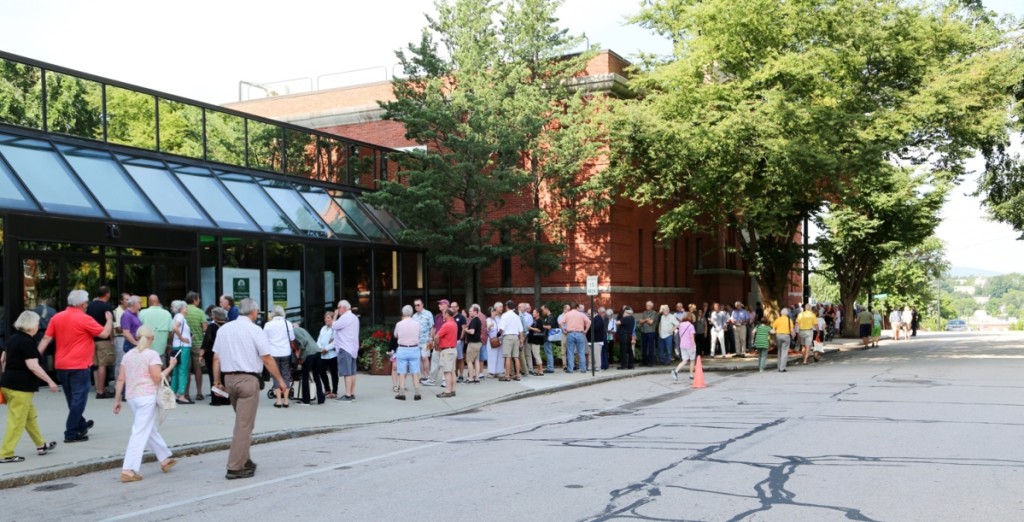
Like every year, the line spilled out of the building and down the road as far as the eye could see.
Nathan Liverant and Son, the Colchester, Conn., dealer of American furniture and decorative arts, had plenty of the desirable case pieces the dealer is known for, such as a folk art cupboard, possibly African American, 1850-75, attributed to North Carolina. Its most compelling feature was an unusual geometric scrolled pediment and, of course, an undisturbed surface. Also on offer was a Queen Anne figured maple highboy from Rhode Island or eastern Connecticut, 1735-50, with slipper feet and scrolled apron. Two other more whimsical pieces here bear noting, however, one a large (24½ by 60 inches) folk art painting attributed to Annie Mural Tolliver (b 1950) depicting “Mother Going to Heaven” from the collection of Eugene and Avis Robinson, and a decorated chamber pot with ribald verse on the outside and an applied frog clinging to the inside.
Back for their third year at this show, Scott DeWolfe and Frank Wood, Alfred, Maine, dealers doing business as DeWolfe & Wood Rare Books, are, as the name implies, primarily booksellers, but they also collect and show Shaker material, and there was plenty of it on offer this time around. A remarkable tribute to the familial relations that one finds with Shaker research was evident in a doll and dress owned by the niece and granddaughter of Harvard Shakers Annie and Catherine Walker. Everyone thinks of the Shakers as being an insular sect, explained DeWolfe, but in this case, even though one of the principals involved was not a member of the Shaker community, the doll and dress were kept together and now were on display at this show. A palm leaf and silk Shaker bonnet housed in a packing box with a crayon inscription reading “Amy’s Shaker Bonnet,” circa 1910, was also on offer, and non-Shaker material included a collection of 14 Eighteenth Century almanacs.
This was Jeffrey Roelof’s first year as exhibitor. The Kalamazoo, Mich., dealer said he was very excited to be participating and has been collecting mostly folk art and painted furniture for about 25 years. Featured in his booth was a silhouette family record from the early Nineteenth Century in a painted frame; a barber pole, circa 1890-1910, in original paint and surface; and a pair of fish plaques out of New York state, circa 1910.
A pair of Nineteenth Century ornamental cast iron eagles from the estate of Kenneth Field, Villanova, Penn., was being shown by Steven F. Still of Manheim, Penn. A diminutive yellow painted cupboard, the yellow over original red paint and with an original red painted interior was from the mid-Nineteenth Century and had been found in York, Penn. On an outside wall of Still’s booth was a large (74 by 36 inches) watercolor of Columbia draped in an American flag and wearing an eagle liberty cap. From the late Nineteenth Century, it had been found in an Odd Fellows lodge in Oley, Penn.
Early American furniture and decorative arts specialist Hollis Brodrick, Portsmouth, N.H., was showing an unusual Pilgrim Century two-drawer blanket chest of eastern white pine. It exhibited some of the earliest elements of such pieces like a single dovetail drawer, lid cleats wooden pegged on and earliest star foot cutout to the base. The maker had turned a single pine ball foot, then cut it in half, grooved the back and applied each to the front of the cutout base on both sides with single hand-forged nails. Brodrick dated the piece circa 1700-15.
Early American themes continued in the booth of Sharon Platt American Antiques. The Portsmouth, N.H., dealer was displaying several beautiful and rare early Nineteenth Century capes or cloaks, one with hood and complete with hand sewn buttonholes, linen lining and raw cotton lining between the fabric, and another man’s cloak in black wool, hand stitched with covered bone buttons. It came from the old Plummer family, Lower Green, Newbury, Mass. Perhaps not rating a description of “beautiful” but compelling from a historical point of view was a rare section of Eighteenth Century clapboards and exterior wall sheathing from an early house in South Hampton, N.H.
Amy Finkel of M. Finkel & Daughter, Philadelphia, had a strong showing of early American samplers, including a rare Hamilton County, Ohio, sampler, 1846, by Cynthia Ann Hoffner exemplifying a pioneering spirit and an important Lehigh Valley, Penn., sampler by Sarah Ann Griffin, dated 1839. An outlier among the examples on offer was one wrought by 12-year-old Rachel Barrett depicting an image of an African School in Halifax, Nova Scotia, dated December 1845 and reflecting Loyalist sentiment.
As usual, rare books and historical manuscripts are the focus of Manchester dealer Resser-Thorner Antiques. Richard Thorner is known to change it up a bit, though, and this time he highlighted Edward Savage’s (American, 1761-1817) “Portrait of a Gentleman,” dated December 11, 1786, and signed lower left. The portrait was flanked by two Savage stipple etchings and engravings, “The Washington Family,” published in 1798, and “The Landing of Columbus,” published 1800. In his showcase, the dealer had a dog sledding whip, once owned by Clara Enebuske (1906-1989), a New Hampshire female musher in a 1925 club meet in Meredith N.H.
John Chaski, Camden, Del., had a wildly painted bedstead, circa 1830, that came from the same shop as the one in the collection of Joan and Victor Johnson, Philadelphia. It was covered in a glazed indigo blue linsey woolsey coverlet from New England, circa 1820, and above it hung a lively and colorful embroidered and appliqued feltwork by a Quebec, Canada, maker, dated 1884 and measuring 42 by 79 inches.
Rare glass bottle enthusiasts make a beeline for Cornwall, Vt., dealers Jeff and Holly Noordsy. In one of their showcases, they had an English transitional shaft and globe bottle with an iridescent vitrified surface, circa 1670, and elsewhere a beautifully incised early Nineteenth Century stoneware jar. With earthy tones, but not of earthenware, was a Nineteenth Century shirred rug or table mat with an image of a standing waterfowl amid cattails.
Tom Jewett and Butch Berdan, Newcastle, Maine, were set up in the show’s lower level with some great folky objects that they set aside for the summer blockbuster. One was a stenciled on linen overmantel painting, circa 1835, 40 by 30 inches framed, a scene of a lady and three dogs who dwarf a solitary horse and two groups of supine sheep in a landscape with church and town in the background. A pair of Nineteenth Century tin parade figures found in New Jersey exuded patriotism, each holding up an unfurled US flag, and a hooked rug of a dog in a landscape, New England, late Nineteenth Century, measured 49 by 41 inches.
Folk portraits were a highlight among the gems in the booth of Frank and Barbara Pollack American Antiques & Art, Highland Park, Ill., and Sunapee, N.H. A most unusual composition in a miniature folk portrait of a father and son showed the father, James Sumner Carpenter facing left, while his son, Gilbert Saltonstall Carpenter, is depicted looking straight ahead, his father’s arm across his torso. The rare double portrait, a watercolor on paper, was from New York state or Ohio, circa 1841, and came with provenance of the family and the collector. Another miniature portrait on offer, this one a watercolor and pencil on paper, circa 1845, delineated a young girl and had been found in an Illinois collection. Framed, it measured 5¾ by 4-7/8 inches. Finally, there was a portrait of a young red-haired boy holding a whip, circa 1840, attributed to Jacob Bailey Moore (active 1840-50) of the Prior Hamblin School.
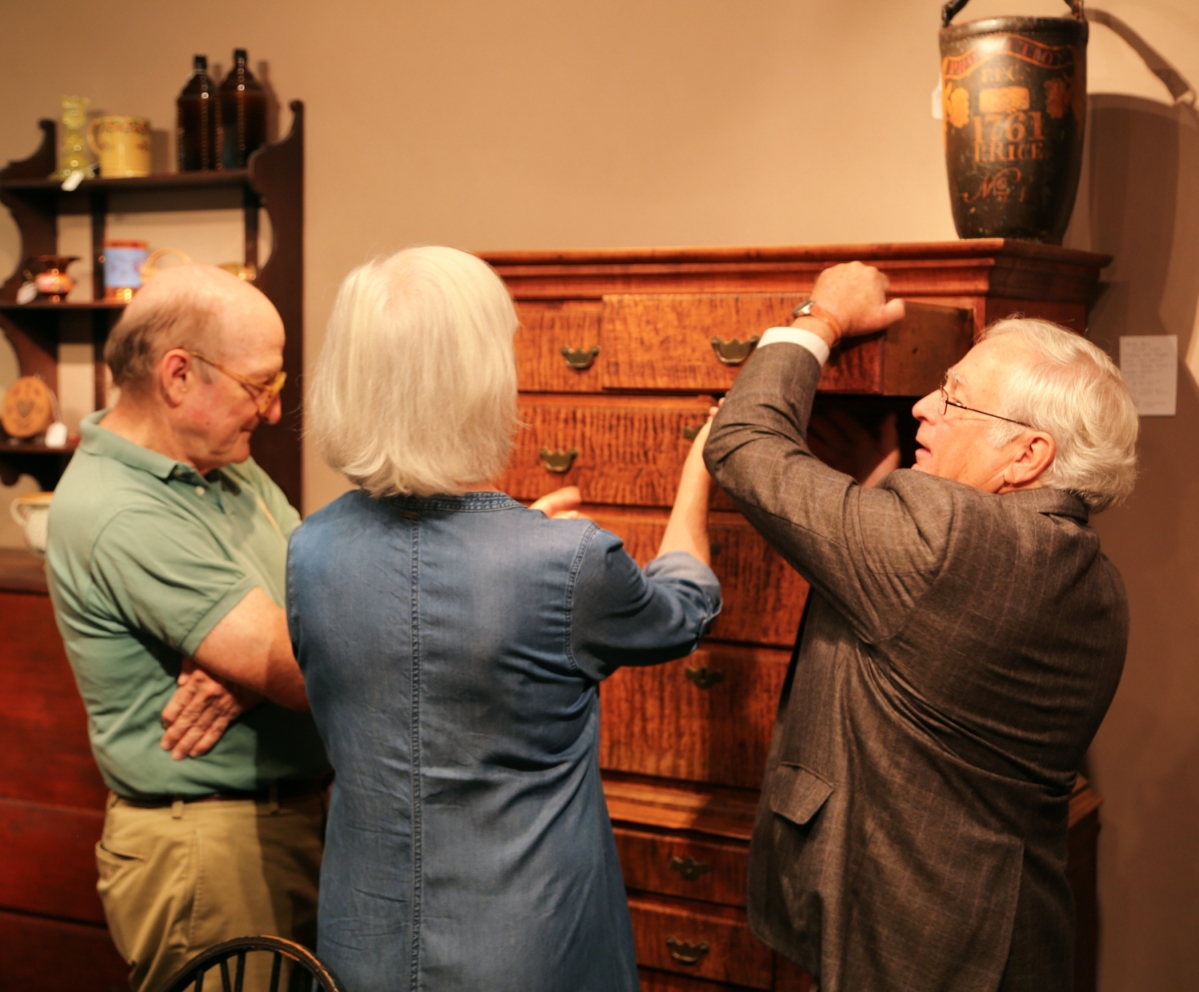
Arthur Liverant pulls a drawer from a Queen Anne figured maple highboy to show a client. The piece was from Rhode Island or Eastern Connecticut, 1735–1750.
A double portrait of two young girls and a cat was a key item at Scott Bassoff and Sandy Jacobs. The Swampscott, Mass., dealer said she had tried to acquire the portrait by an unknown artist more than a decade ago and was recently successful in adding it to her collection. She also showcased a tall hooked rug of cut fabric pieces centering an urn with flowering plant and meandering flowers around the border. The 36-by-96-inch rug exhibited great colors and had been professionally mounted on a folding frame. One of the most compelling items here was a late Nineteenth Century illustrated family record, literally depicting a tree with the composition showing dead branches where a line had died out and recording only the names of males born into the family. A three-masted schooner can be seen in Hingham Harbor and Native Americans watch from the shore. Jacobs ended up selling both the large double portrait and the 1880s watercolor family record.
Mike Whittemore said he sold four weathervanes of the seven he had in his booth, a virtual bestiary of horse and sulky rider, race horse with rider, three roosters, one of which is crowing, a ram and a cow. The Punta Gorda, Fla., dealer also offered a doctor’s apothecary that while having been made in Canada had been found in Florida. A double-sided New England sign, probably mid-Nineteenth Century, exhibited some early graffiti, a childish scrawl in pencil declaring “Do not right on hear.”
Other sales noted by dealers included Jason Samuel’s sale of a good early Nineteenth Century grain-painted desk and Jonathan Trace’s sale of several pieces of silver. Trace said, “It’s the best show I’ve ever had in New Hampshire.”
“It’s New England, all original surface with a screaming tiger maple top,” said Stephen Corrigan, one half of the Americana duo known as Stephen-Douglas, Rockingham, Vt., referring to a circa 1820 table with cutout apron and one-board top. Pressed for details for other items in the booth he shared with partner Doug Jackman, Corrigan took a moment from putting up labels to point out a pair of portraits, man and woman, circa 1830, by an unknown artist that he believed was from Enfield, N.H., and a tiger maple wall box from Ohio in untouched condition.
A rare group of Odd Fellow plaques from either western Pennsylvania or Ohio and by an unknown maker were notable in the booth of John Sideli, artist and antiques and fine art dealer from Westport, Mass. Carved on polychrome wood, circa 1885-1910, and presented in deep walnut frames, the plaques, which Sideli thought may be one of a kind, symbolized the moral code and life goals of lodge members. Also, a high back Windsor, circa 1780, bore a note under the seat placing it in Portland, Maine, while a brilliant still life oil on canvas by an unknown American artist, circa 1850, offered a bold and dynamic composition.
The lid of a Nineteenth Century wooden box meant for transporting honey – “Honey 25¢ Pnt” – had a painted bee skep on its top with swarming bees and some “petrified” globs of honey on its underside. Folk art dealer Tim Chambers of Missouri Plain Folk, Sikeston, Md., wondered in jest if it was still edible. “Doesn’t it last forever?” A “Painting & Hardwood Finishing” sign from western New York at the turn of the century and a Navajo weaving of an American flag, circa 1915, were further highlights.
It was Boston dealer Stephen Score’s third year at the show and it was a good one. Score said he sold a very good 1890-1900 barber pole, a very colorful abstract sewn and braided rug – a technique he said he’d never seen before – and smalls. A grouping of 19 red, white and blue whirligig propellers from the 1950s covered one of the dealer’s walls, while a portrait of a pug, oil on board, New York, 1895, and a folky hooked rug with a cartoon tom cat character and his progeny boasted “Ya Gotta Make Calls” on one panel and “If Ya Wanta Get Results” on the lower one.
Back for the second year were Christopher and Bernadette Evans, hailing from Waynesboro, Va., and favoring mostly folk art and regional decorative arts that exhibit great color and form, as well as country pottery and stoneware. On offer here was an Auguste Edouart silhouette grouping on ink with interior background signed “1839 411 Broadway New York”; a vibrant orange and red wools windmill blades log cabin quilt, late Nineteenth Century; and a mid-Nineteenth Century stoneware presentation jar (wedding theme) with profuse incised and cobalt decoration, possibly made by the Edmonds family of Boston.
In a corner booth was Axtell Antiques, presided over by the Deposit, N.Y., dealer “Smitty” Axtell and with many things on display. These included a rare pair of miniature firkins, circa 1800s, in original color, stamped on the lid with their maker’s initials “CH” for Cotton Hersey; a cigar store Indian archer figure signed and dated 1865 by Joseph Ligget; and a wonderful whirligig featuring a lighthouse around which there is much industriousness by carved figures – cow milking, wood chopping and butter churning.
Kelly Kinzle, New Oxford, Penn., sold a bronze eagle and a painted cupboard. Compelling items on offer in his booth included the “Village Romp,” a Yankee Clipper-type sled from New England, circa 1880, decorated with an American shield on a checkerboard background; an elegant example of Mahantongo craftsmanship in the form of a hanging cupboard, circa 1830-35, of poplar with original paint, brass and iron; and, featuring the fancy paint decoration of Oley Valley, Penn., a chest of drawers in poplar and pine, circa 1810.
The Massachusetts business of Pam and Martha Boynton still carries the name of Pam Boynton, who passed away in early spring of 2017. Her daughter, Martha Boynton, Townsend, Mass., carries on the business, this year showcasing a charming Prior-Hamblin School portrait of a young girl holding a book, a cast and zinc trade sign in the form of a pocket watch that was ex Bisnoff collection and a theorem on velvet with fruit and a bird.
The show dates for next year are August 8, 9 and 10. For information, www.nhada.org.

